Nvidia GeForce RTX 3070 Ti Review: More Bandwidth, More Power, More Money
GA104 gets a GDDR6X Upgrade
The Nvidia GeForce RTX 3070 Ti continues the Ampere architecture rollout, which powers the GPUs behind many of the best graphics cards. Last week Nvidia launched the GeForce RTX 3080 Ti, a card that we felt increased the price too much relative to the next step down. RTX 3070 Ti should do better, both by virtue of only costing $599 (in theory), and also because there's up to a 33% difference between the existing GeForce RTX 3070 and GeForce RTX 3080. That's a $100 increase in price relative to the existing 3070, but both the 3070 and 3080 will continue to be sold, in "limited hash rate" versions, for the time being. We'll be adding the RTX 3070 Ti to our GPU benchmarks hierarchy shortly, if you want to see how all the GPUs rank in terms of performance.
The basic idea behind the RTX 3070 Ti is simple enough. Nvidia takes the GA104 GPU that powers the RTX 3070 and RTX 3060 Ti, only this time it's the full 48 SM variant of the chip, and pairs it with GDDR6X. While Nvidia could have tried doing this last year, both the RTX 3080 and RTX 3090 were already struggling to get enough GDDR6X memory, and delaying by nine months allowed Nvidia to build up enough inventory of both the GPU and memory for this launch. Nvidia has also implemented its Ethereum hashrate limiter, basically cutting mining performance in half on crypto coins that use the Ethash / Dagger-Hashimoto algorithm.
Will it be enough to avoid having the cards immediately sell out at launch? Let me think about that, no. Not a chance. In fact, miners are probably still trying to buy the limited RTX 3080 Ti, 3080, 3070, 3060 Ti, and 3060 cards. Maybe they hope the limiter will be cracked or accidentally unlocked again. Maybe they made too much money off of the jump in crypto prices during the past six months. Or maybe they're just optimistic about where crypto is going in the future. The good news, depending on your perspective, is that mining profitability has dropped significantly during the past month, which means cards like the RTX 3090 are now making under $7 per day after power costs, and the RTX 3080 has dropped down to just over $5 per day.
GeForce RTX 3070 Ti: Not Great for Mining but Still Profitable
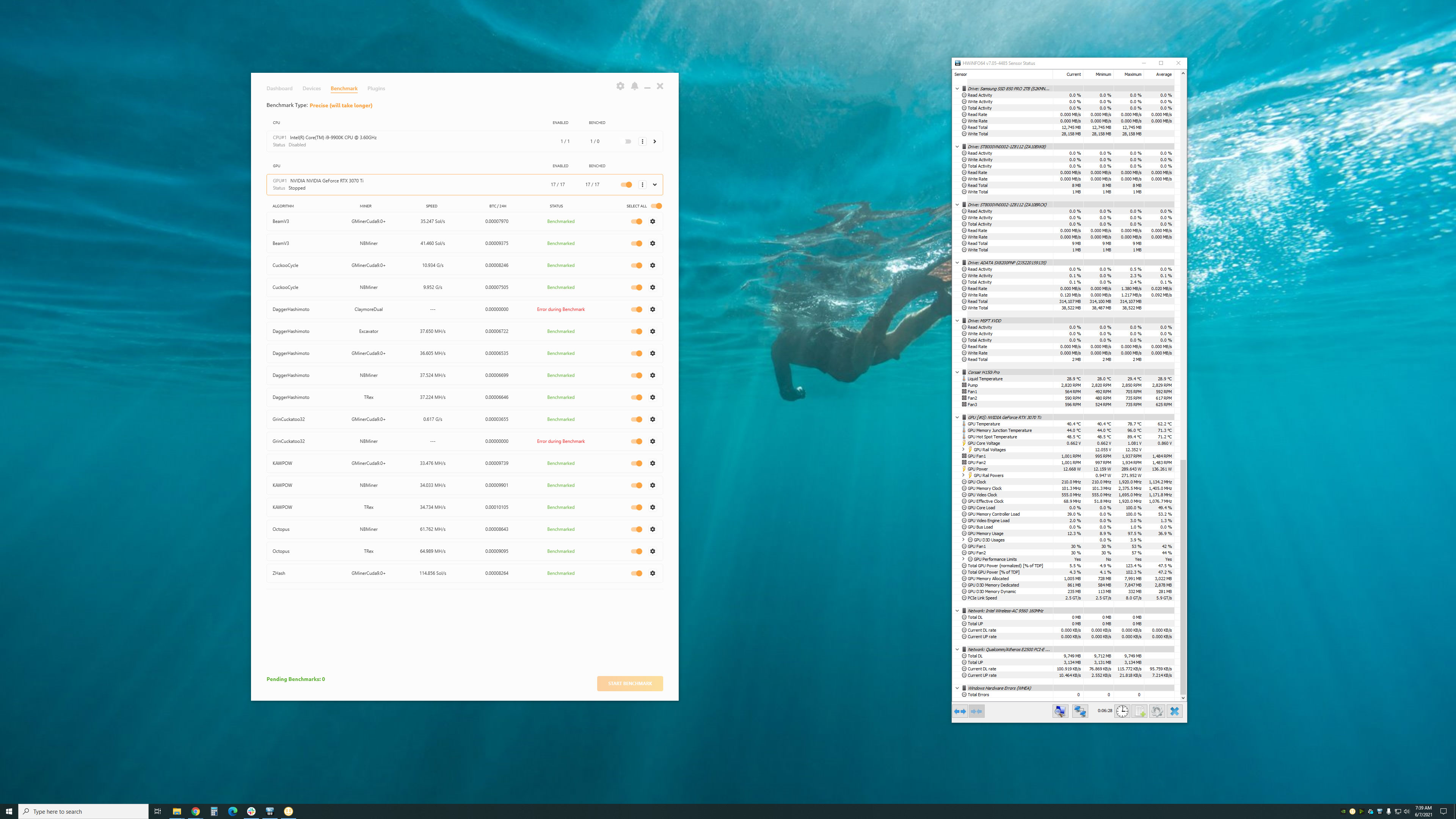

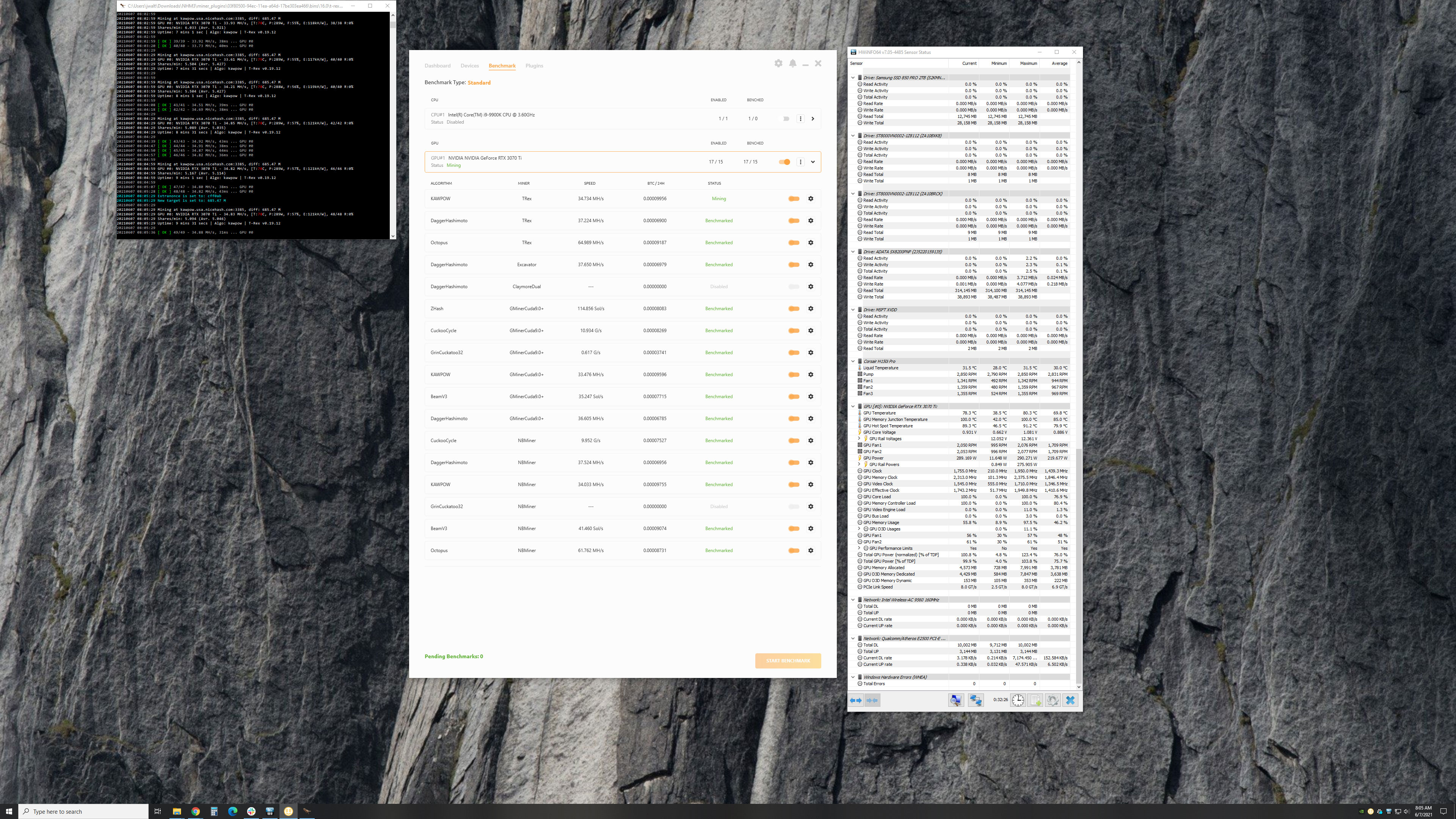
Even if the RTX 3070 Ti didn't have a limited hashrate, it would only net about $4.25 a day. With the limiter in place, Ravencoin (KAWPOW) and Conflux (Octopus) are the most profitable crypto coins right now, and both of those hashing algorithms still appear to run at full speed. Profitability should be a bit higher with tuning, but right now, we'd estimate making only $3.50 or so per day. That's still enough for the cards to 'break even' in about six months, but again, profitability has dropped and may continue to drop.
The gamers among us will certainly hope so, but even without crypto coin mining, demand for GPUs continues to greatly exceed supply. By launching the RTX 3070 Ti, with its binned GA104 chips and GDDR6X memory, Nvidia continues to steadily increase the number of GPUs it's selling. Nvidia is also producing more Turing GPUs right now, mostly for the CMP line of miner cards, and at some point, supply should catch up. Will that happen before the next-gen GPUs arrive? Probably, but only because the next-gen GPUs are likely to be pushed back thanks to the same shortages facing current-gen chips.
Okay, enough of the background information. Let's take a look at the specifications for the RTX 3070 Ti, along with related Nvidia GPUs like the 3080, 3070, and the previous-gen RTX 2070 Super:
| Graphics Card | RTX 3080 | RTX 3070 Ti | RTX 3070 | RTX 2070 Super |
|---|---|---|---|---|
| Architecture | GA102 | GA104 | GA104 | TU104 |
| Process Technology | Samsung 8N | Samsung 8N | Samsung 8N | TSMC 12FFN |
| Transistors (Billion) | 28.3 | 17.4 | 17.4 | 13.6 |
| Die size (mm^2) | 628.4 | 392.5 | 392.5 | 545 |
| SMs / CUs | 68 | 48 | 46 | 40 |
| GPU Cores | 8704 | 6144 | 5888 | 2560 |
| Tensor Cores | 272 | 192 | 184 | 320 |
| RT Cores | 68 | 48 | 46 | 40 |
| Base Clock (MHz) | 1440 | 1575 | 1500 | 1605 |
| Boost Clock (MHz) | 1710 | 1765 | 1725 | 1770 |
| VRAM Speed (Gbps) | 19 | 19 | 14 | 14 |
| VRAM (GB) | 10 | 8 | 8 | 8 |
| VRAM Bus Width | 320 | 256 | 256 | 256 |
| ROPs | 96 | 96 | 96 | 64 |
| TMUs | 272 | 192 | 184 | 160 |
| TFLOPS FP32 (Boost) | 29.8 | 21.7 | 20.3 | 9.1 |
| TFLOPS FP16 (Tensor) | 119 (238) | 87 (174) | 81 (163) | 72 |
| RT TFLOPS | 58.1 | 42.4 | 39.7 | 27.3 |
| Bandwidth (GBps) | 760 | 608 | 448 | 448 |
| TDP (watts) | 320 | 290 | 220 | 215 |
| Launch Date | Sep 2020 | Jun 2021 | Oct 2020 | Jul 2019 |
| Launch Price | $699 | $599 | $499 | $499 |
The GeForce RTX 3070 Ti provides just a bit more theoretical computational performance than the 3070, thanks to the addition of two more SMs. It also has slightly higher clocks, giving it 7% more TFLOPS — and it still has 27% fewer TFLOPS than the 3080. More important by far is that the 3070 Ti goes from 14Gbps of GDDR6 and 448 GB/s of bandwidth to 19Gbps GDDR6X and 608 GB/s of bandwidth, a 36% improvement. In general, we expect performance to land between the 3080 and 3070, but closer to the 3070.
Get Tom's Hardware's best news and in-depth reviews, straight to your inbox.
Besides performance specs, it's also important to look at power. It's a bit shocking to see that the 3070 Ti has a 70W higher TDP than the 3070, and we'd assume nearly all of that goes into the GDDR6X memory. Some of it also allows for slightly higher clocks, but generally, that's a significant increase in TDP just for a change in VRAM.
There's still the question of whether 8GB of memory is enough. These days, we'd say it's sufficient for any game you want to play, but there are definitely instances where you'll run into memory capacity issues. Not surprisingly, many of those come in games promoted by AMD, it's almost like AMD has convinced developers to target 12GB or 16GB of VRAM at maximum quality settings. But a few judicious tweaks to settings (like dropping texture quality a notch) will generally suffice.
The difficulty is that there's no good way to get more memory other than simply doing it. The 256-bit interface means Nvidia can do 8GB or 16GB — nothing in between. And with the 3080 and 3080 Ti offering 10GB and 12GB, respectively, there was basically no chance Nvidia would equip a lesser GPU with more GDDR6X memory. (Yeah, I know, but the RTX 3060 12GB remains a bit of an anomaly in that department.)
GeForce RTX 3070 Ti Design: A Blend of the 3070 and 3080
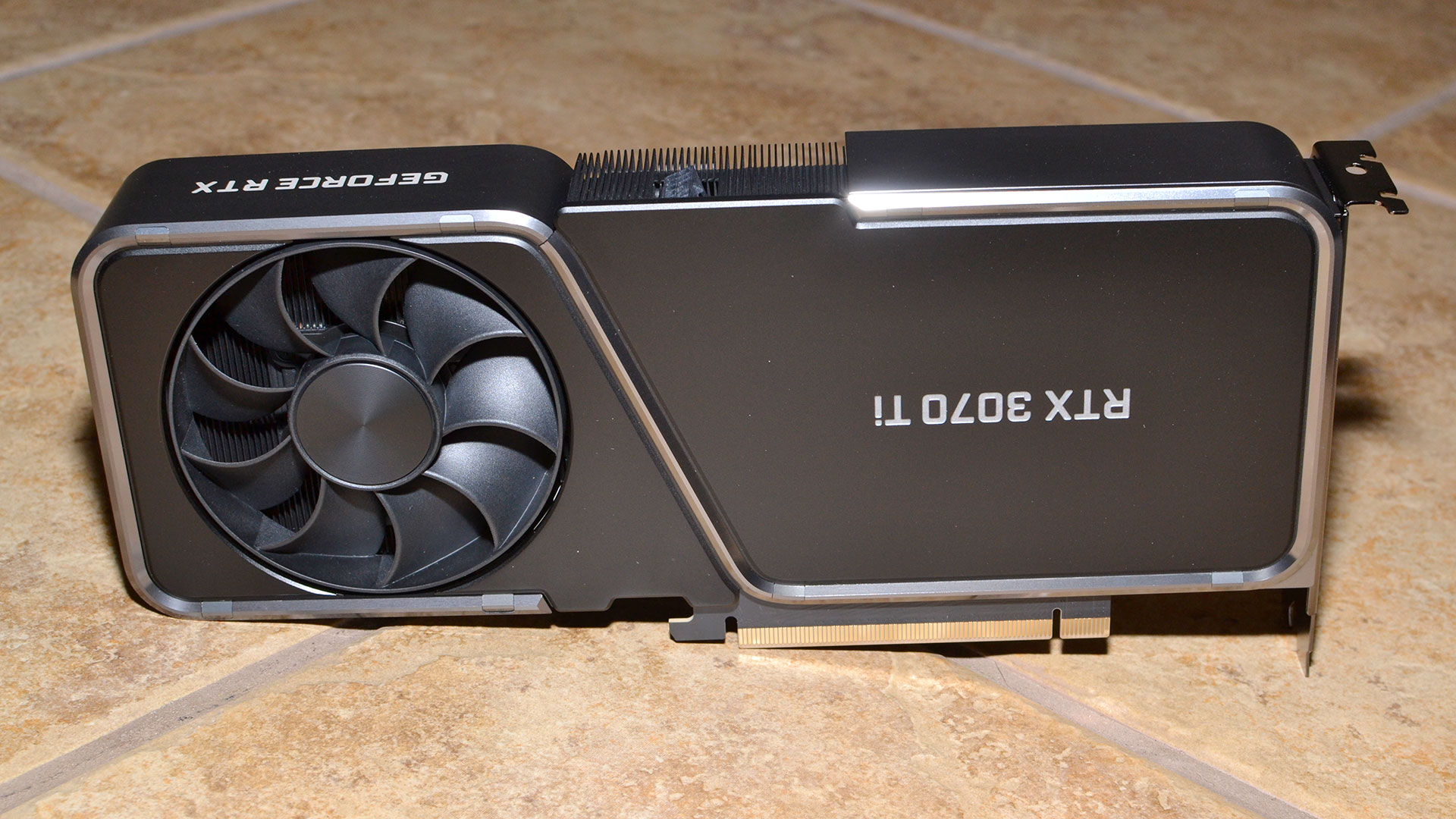

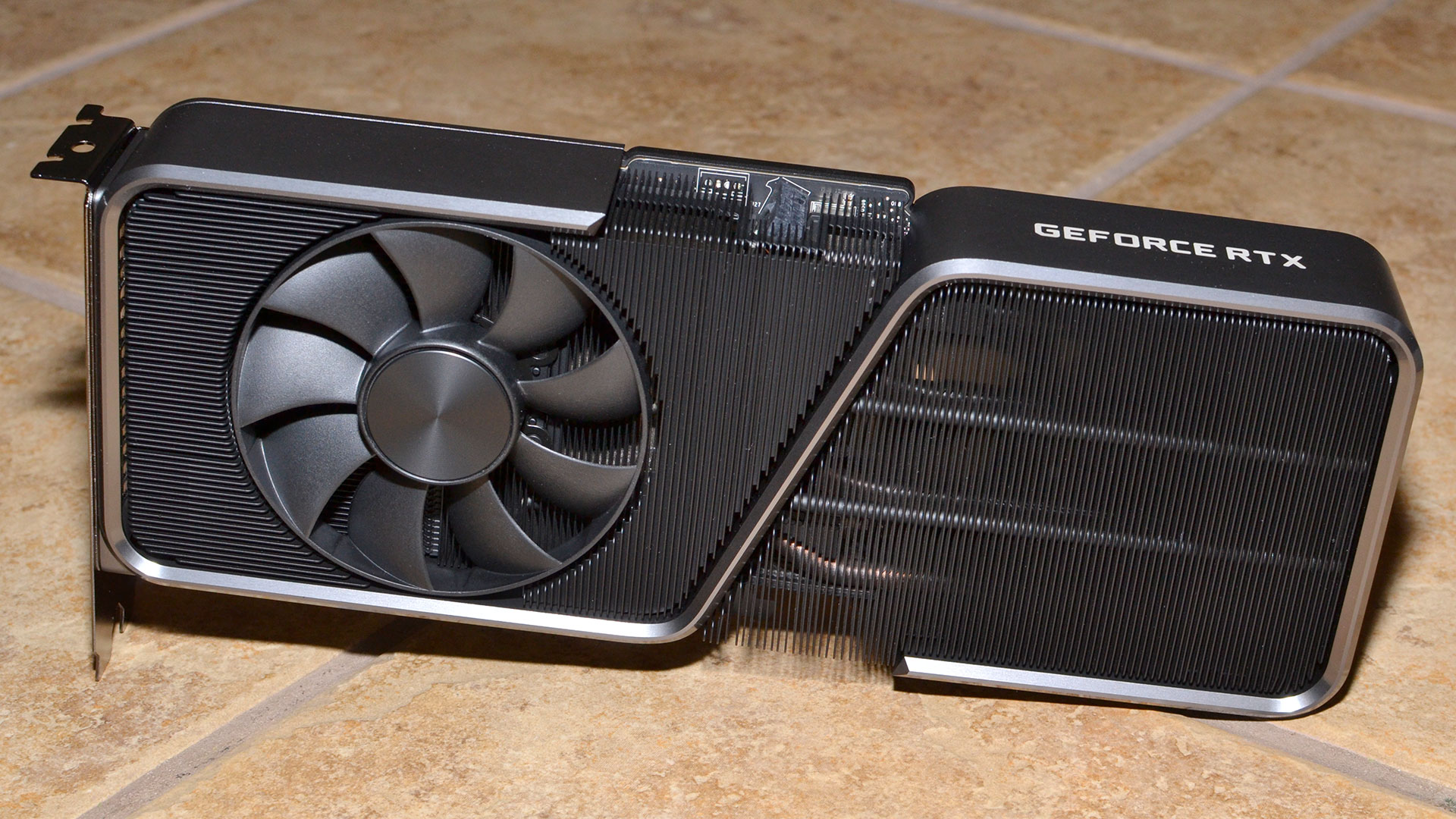
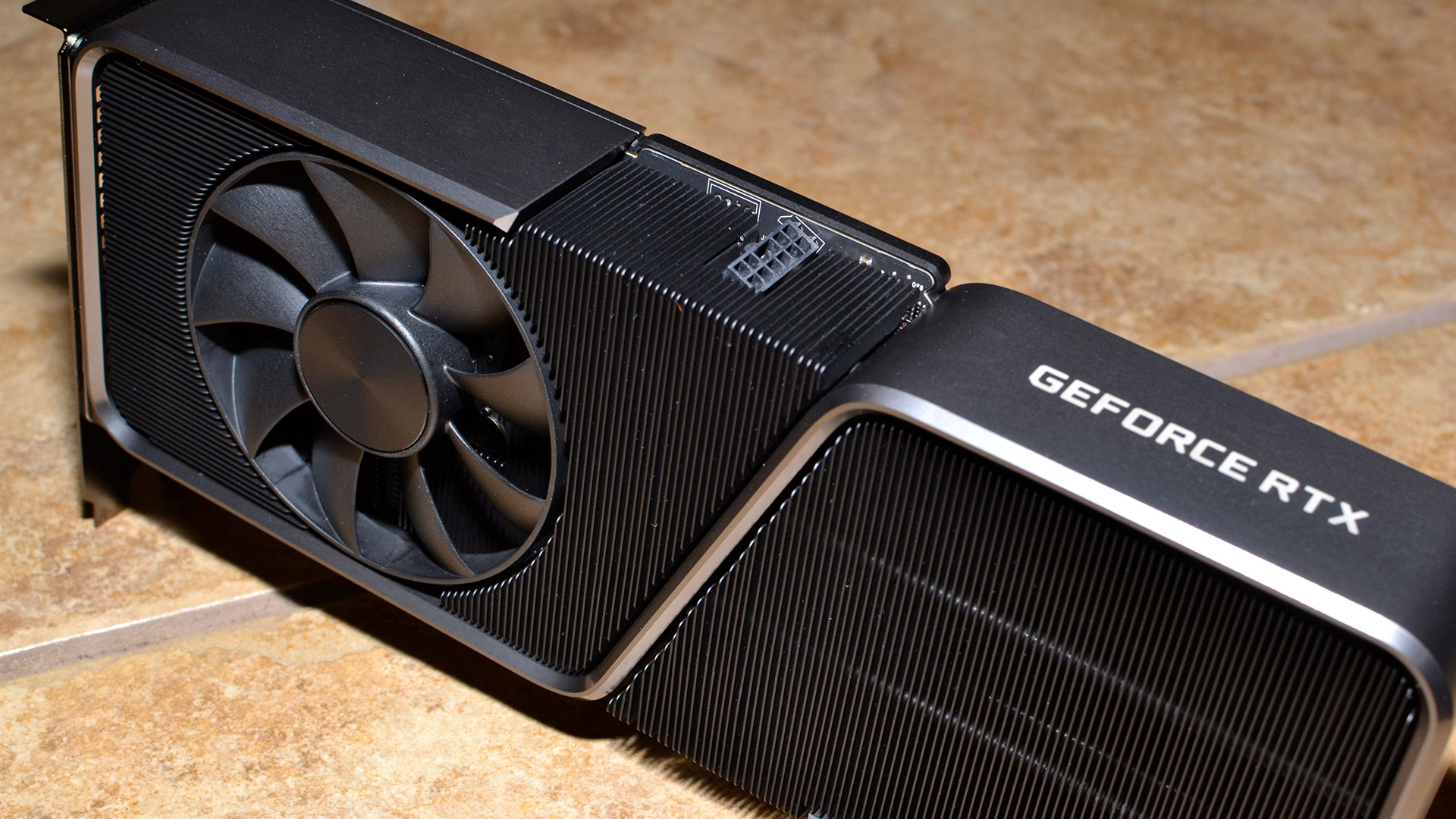

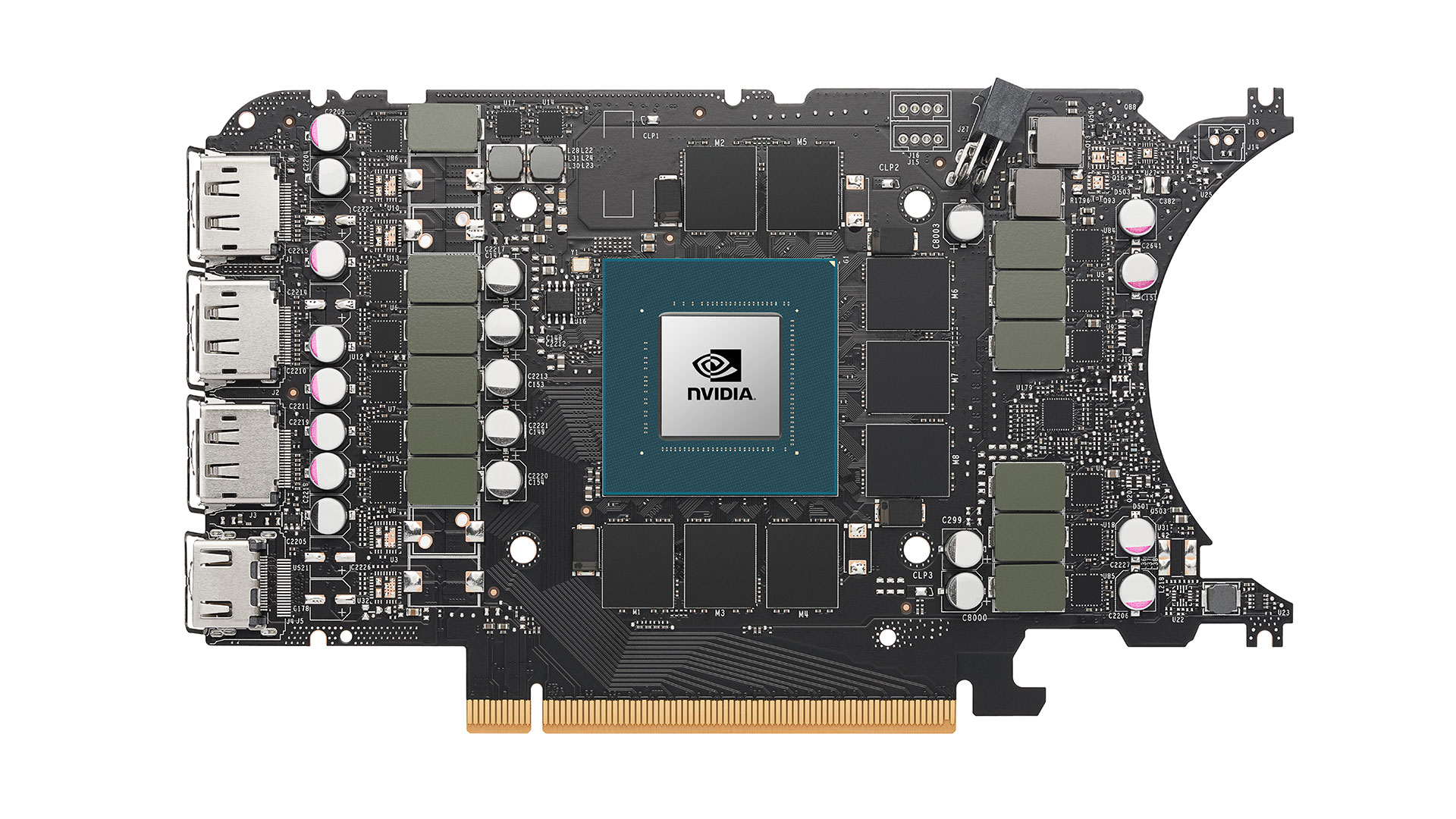
Unlike the RTX 3080 Ti, Nvidia actually made some changes to the RTX 3070 Ti's design. Basically, the 3070 Ti has a flow-through cooling fan at the 'back' of the card, similar to the 3080 and 3090 Founders Edition cards. In comparison, the 3070 just used two fans on the same side of the card. This also required some tweaks to the PCB layout, so the 3070 Ti doesn't use the exact same boards as the 3070 and 3060 Ti. It's not clear exactly how much the design tweak helps with cooling, but considering the 290W vs. 220W TDP, presumably Nvidia did plenty of testing before settling on the final product.
Overall, whether the change significantly improves the cooling or not, we think it does improve the look of the card. The RTX 3070 and 3060 Ti Founders Editions looked a bit bland, as they lacked even a large logo indicating the product name. The 3080 and above (FE models) include RGB lighting, though, which the 3070 Ti and below lack. Third party cards can, of course, do whatever they want with the GPU, and we assume many of them will provide beefier cooling and RGB lighting, along with factory overclocks.
One question we had going into this review was how well the card would cool the GDDR6X memory. The various Founders Edition cards with GDDR6X memory can all hit 110 degrees Celsius on the memory with various crypto mining algorithms, at which point the fans kick into high gear and the GPU throttles. Gaming tends to be less demanding, but we still saw 102C-104C on the 3080 Ti. The 3070 Ti doesn't have that problem. Even with mining algorithms, the memory peaked at 100C, and temperatures in games were generally 8C–12C cooler. That's the benefit of only having to cool 8GB of GDDR6X instead of 10GB, 12GB, or 24GB.
GeForce RTX 3070 Ti: Standard Gaming Performance
Our test setup remains unchanged from previous reviews, and like the 3080 Ti, we'll be doing additional testing with ray tracing and DLSS — using the same tests as our AMD vs. Nvidia: Ray Tracing Showdown. We're using the test equipment shown above, which consists of a Core i9-9900K, 32GB DDR4-3600 memory, 2TB M.2 SSD, and the various GPUs being tested — all of which are reference models here, except for the RTX 3060 (an EVGA model running reference clocks).
That gives us two sets of results. First is the traditional rendering performance, using thirteen games, at 1080p, 1440p, and 4K with ultra/maximum quality settings. Then we have ten more games with RT (and sometimes DLSS, where applicable). We'll start with 4K, since this is a top-tier GPU more likely to be used at that resolution, plus it's where the card does best relative to the other GPUs — CPU bottlenecks are almost completely eliminated at 4K, but more prevalent at 1080p. If you want to check 1080p/1440p/4K medium performance, we'll have those results in our best graphics cards and GPU benchmarks articles — though only for nine of the games.
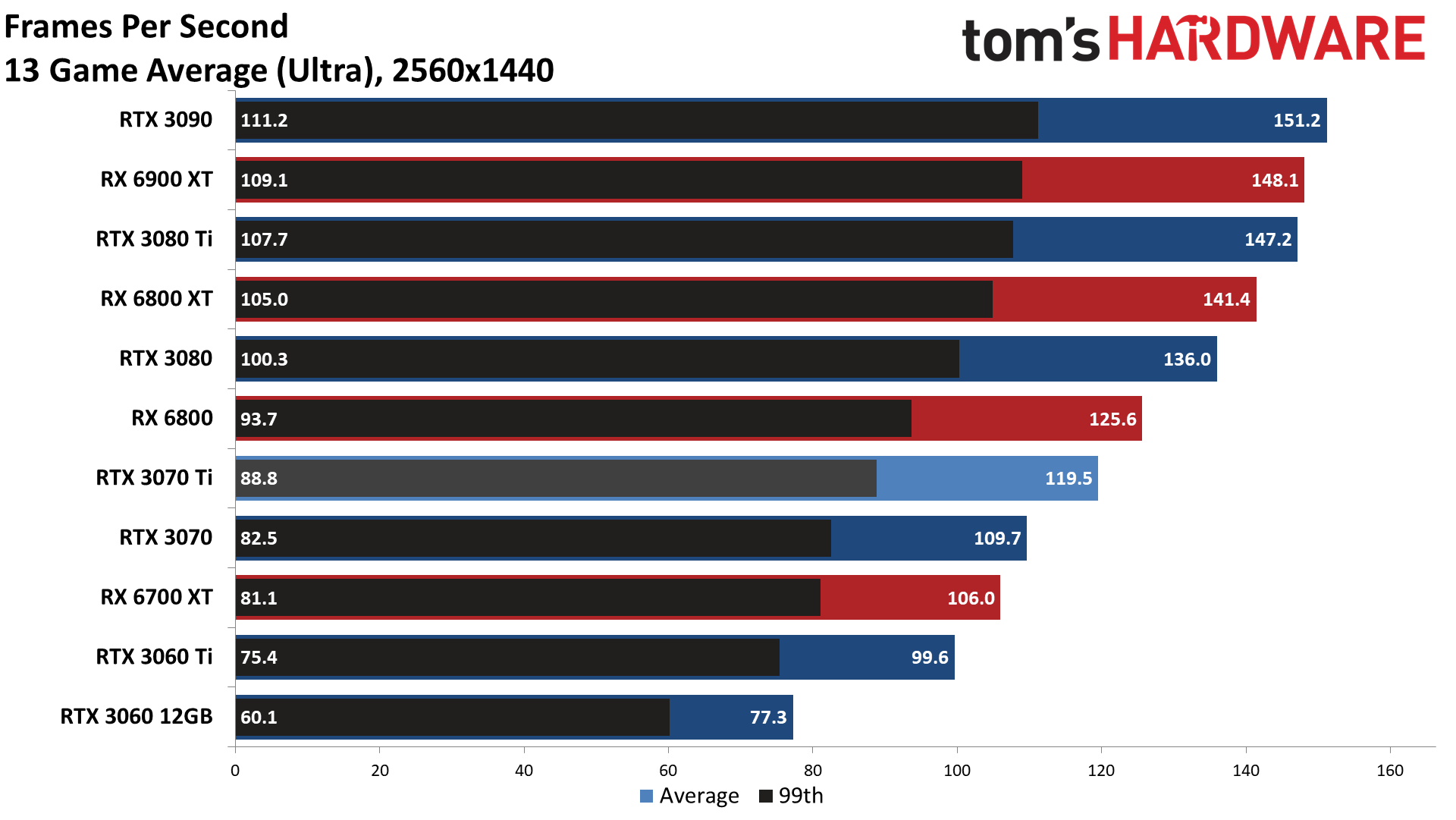


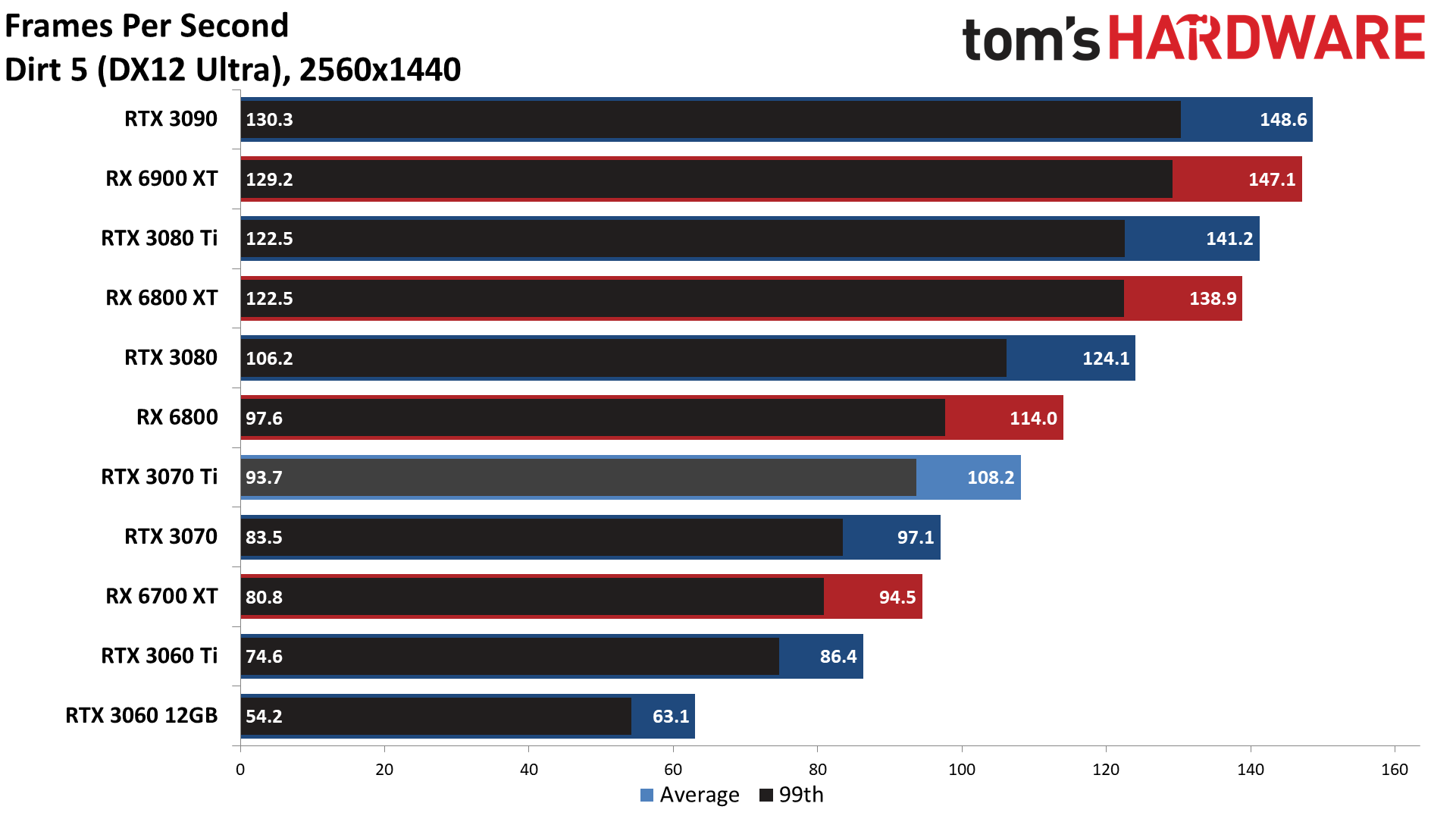
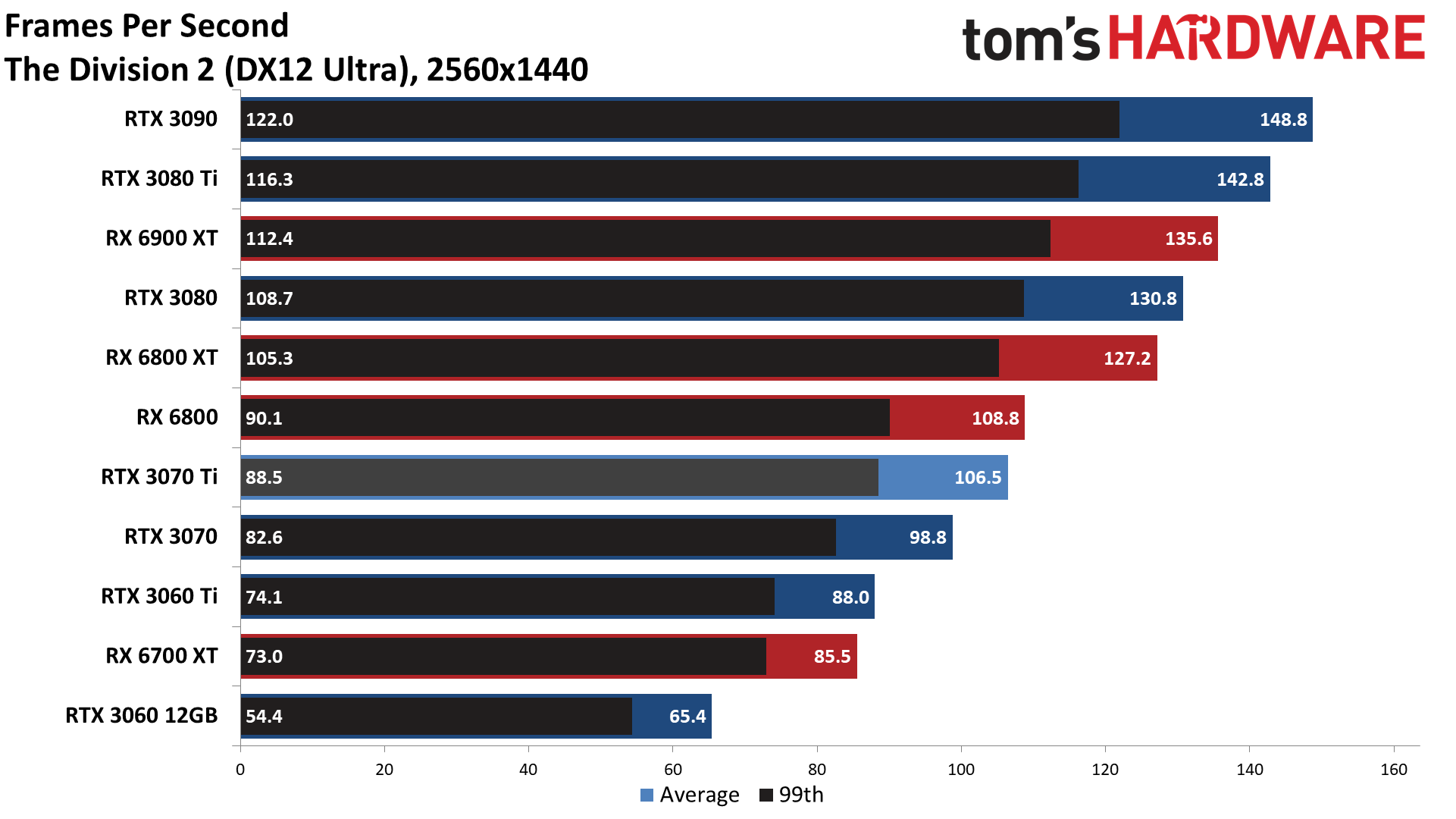
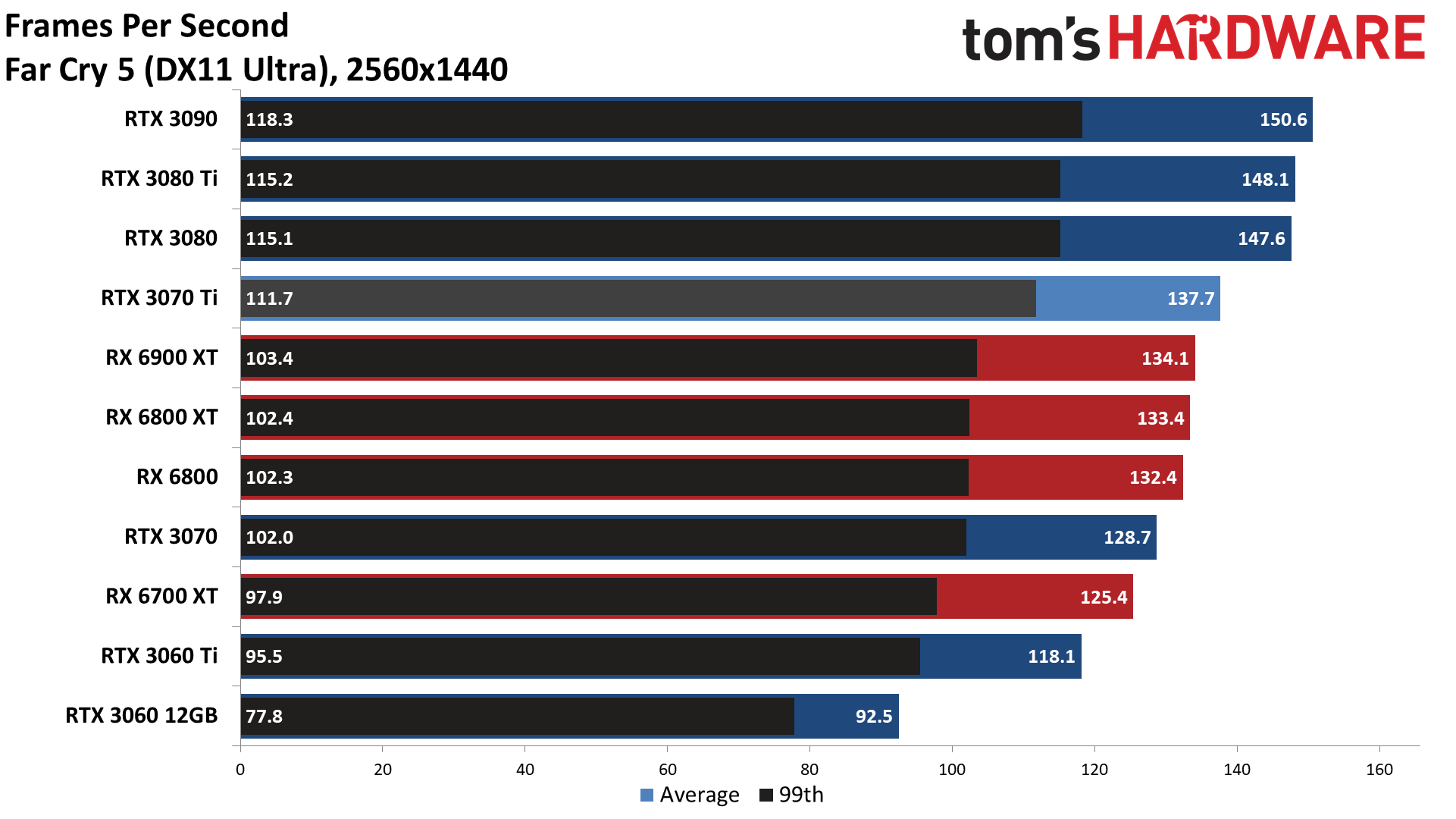
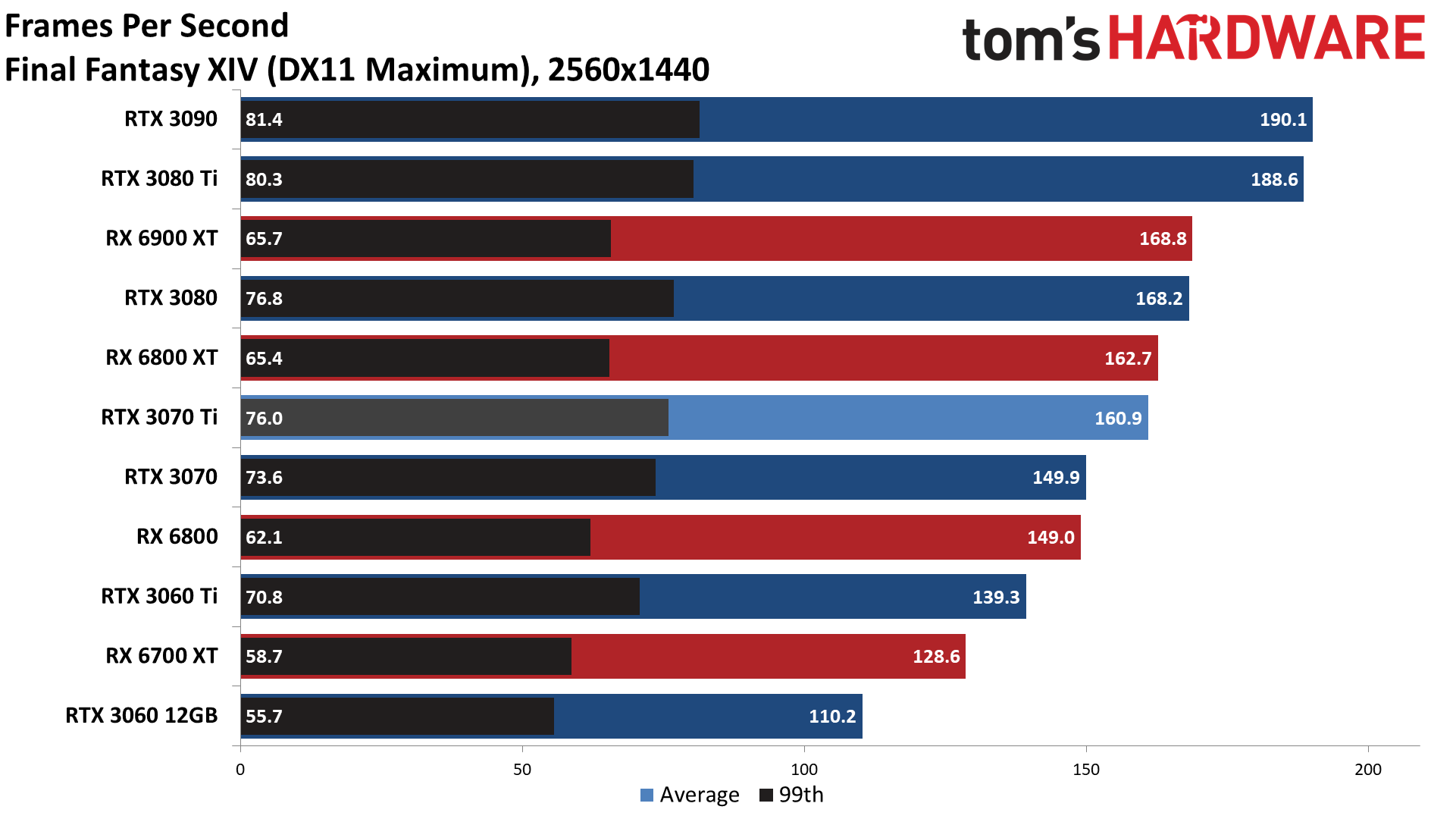
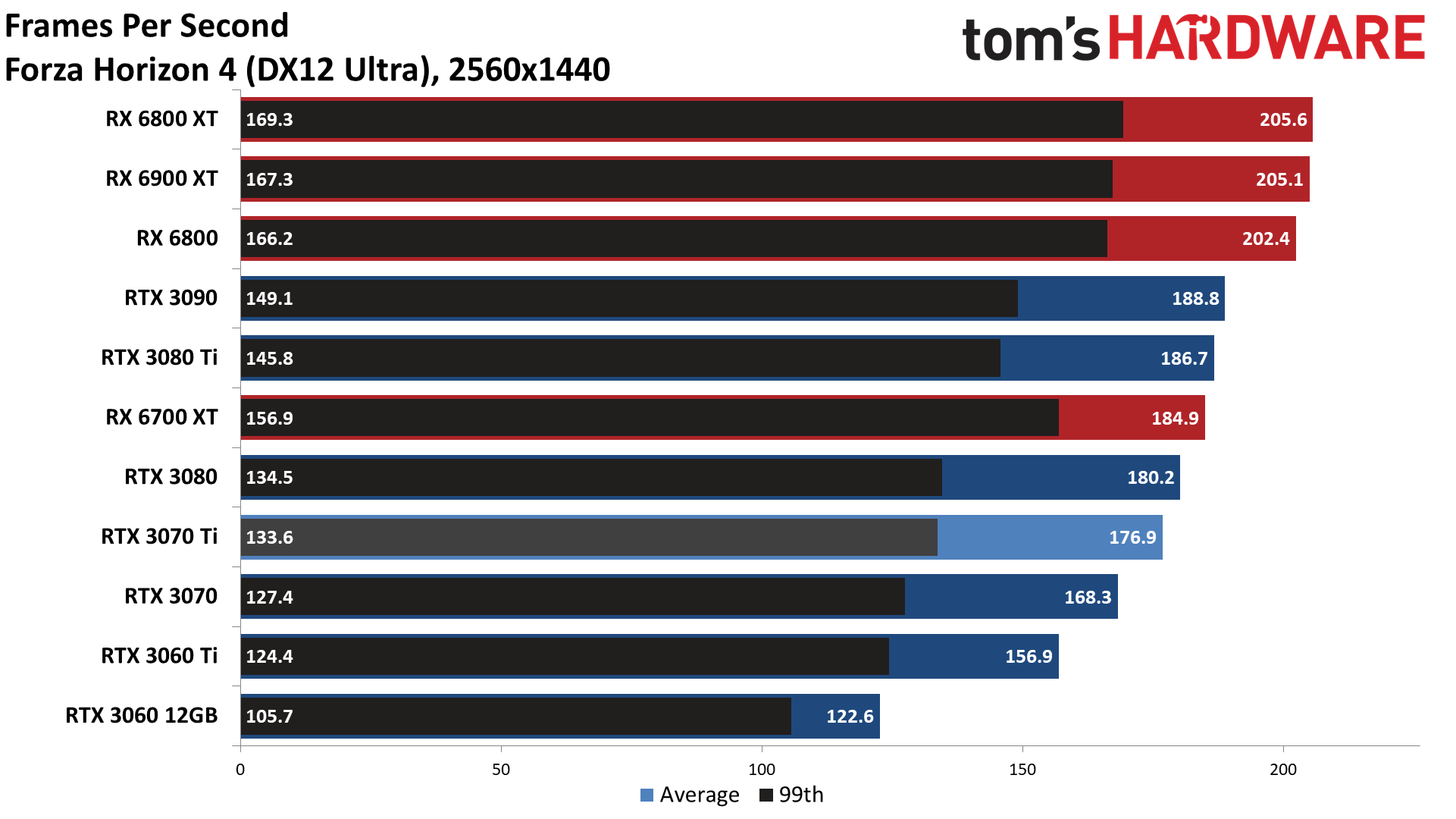

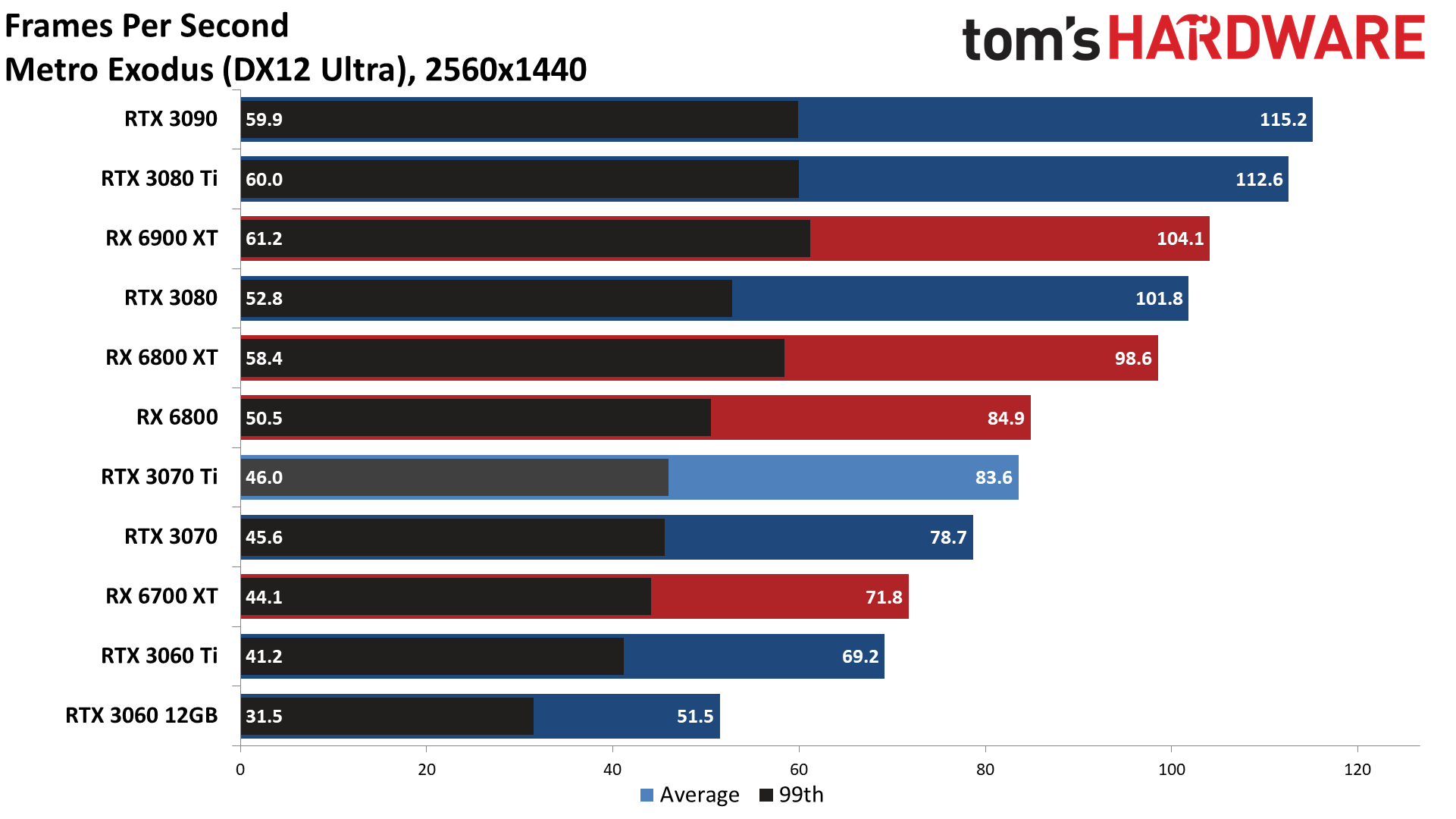

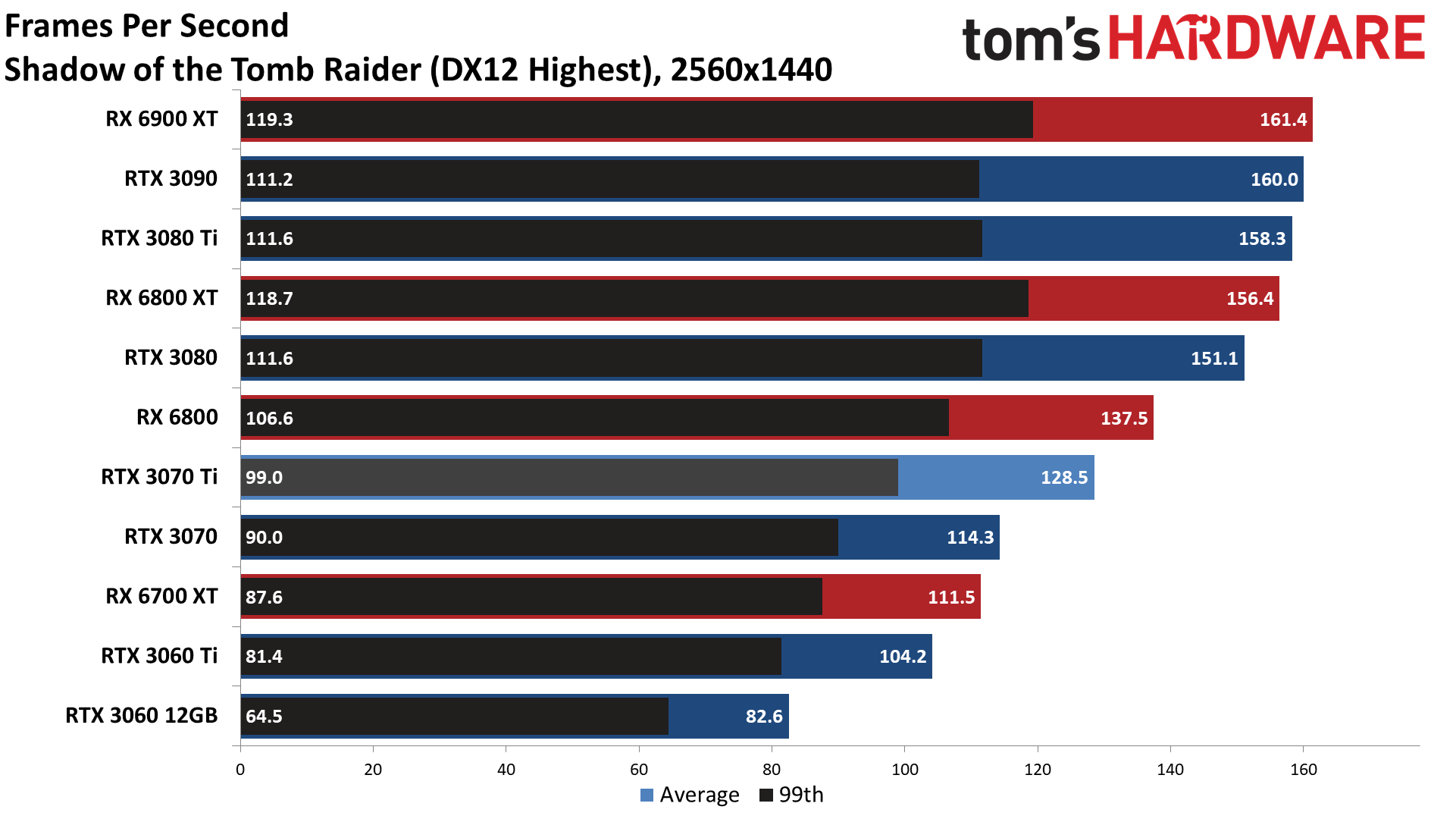
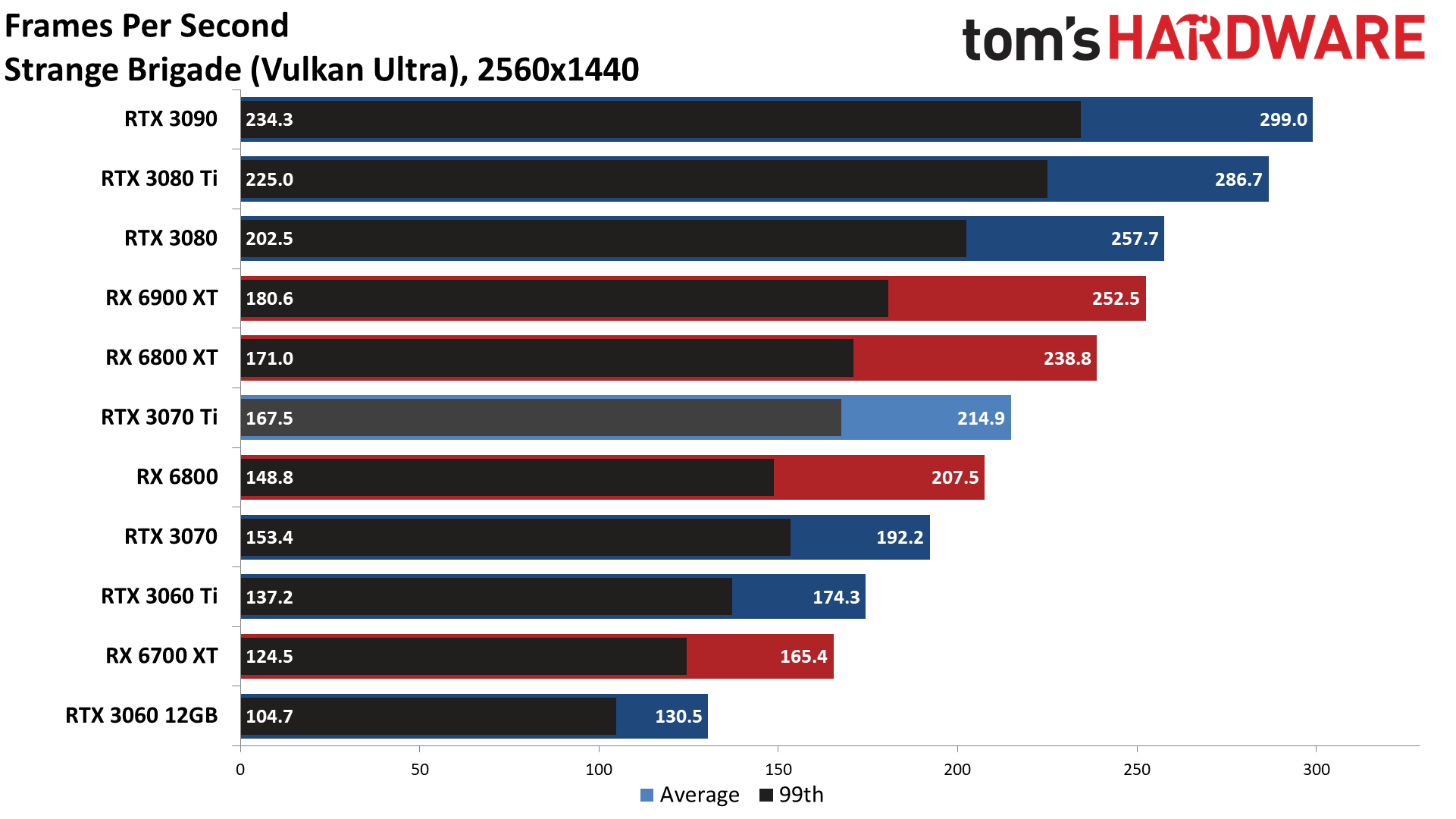

The RTX 3070 Ti does best as a 1440p gaming solution, which remains the sweet spot in terms of image quality and performance requirements. Overall performance ended up 9% faster than the RTX 3070 and 13% slower than the RTX 3080, so the added memory bandwidth only goes so far toward removing bottlenecks. However, a few games benefit more, like Assassin's Creed Valhalla, Dirt 5, Horizon Zero Dawn, Shadow of the Tomb Raider, and Strange Brigade — all of which show double-digit percentage improvements relative to the 3070.
Some of the games are also clearly hitting other bottlenecks, like the GPU cores. Borderlands 3, The Division 2, Far Cry 5, FFXIV, Metro Exodus, and Red Dead Redemption 2 all show performance gains closer to the theoretical 7% difference in compute that we get from core counts and clock speeds. Meanwhile, Watch Dogs Legions ends up showing the smallest change in performance, improving just 3% compared to the RTX 3070.
The RTX 3070 Ti makes for a decent showing here, but we're still looking at an MSRP increase of 20% for a slightly less than 10% increase in performance. Compared to AMD's RX 6000 cards, the 3070 Ti easily beats the RX 6700 XT, but it comes in 6% behind the RX 6800 — which, of course, means it trails the RX 6800 XT as well.
On the one hand, AMD's GPUs tend to sell at higher prices, even when you see them in places like the Newegg Shuffle. At the same time, RTX 30-series hardware on eBay remains extremely expensive, with the 3070 selling for around $1,300, compared to around $1,400 for the RX 6800. Considering the RTX 3070 Ti is faster than the RTX 3070, it remains to be seen where street pricing lands. Of course, the reduced hashrates for Ethereum mining on the 3070 Ti may also play a role.
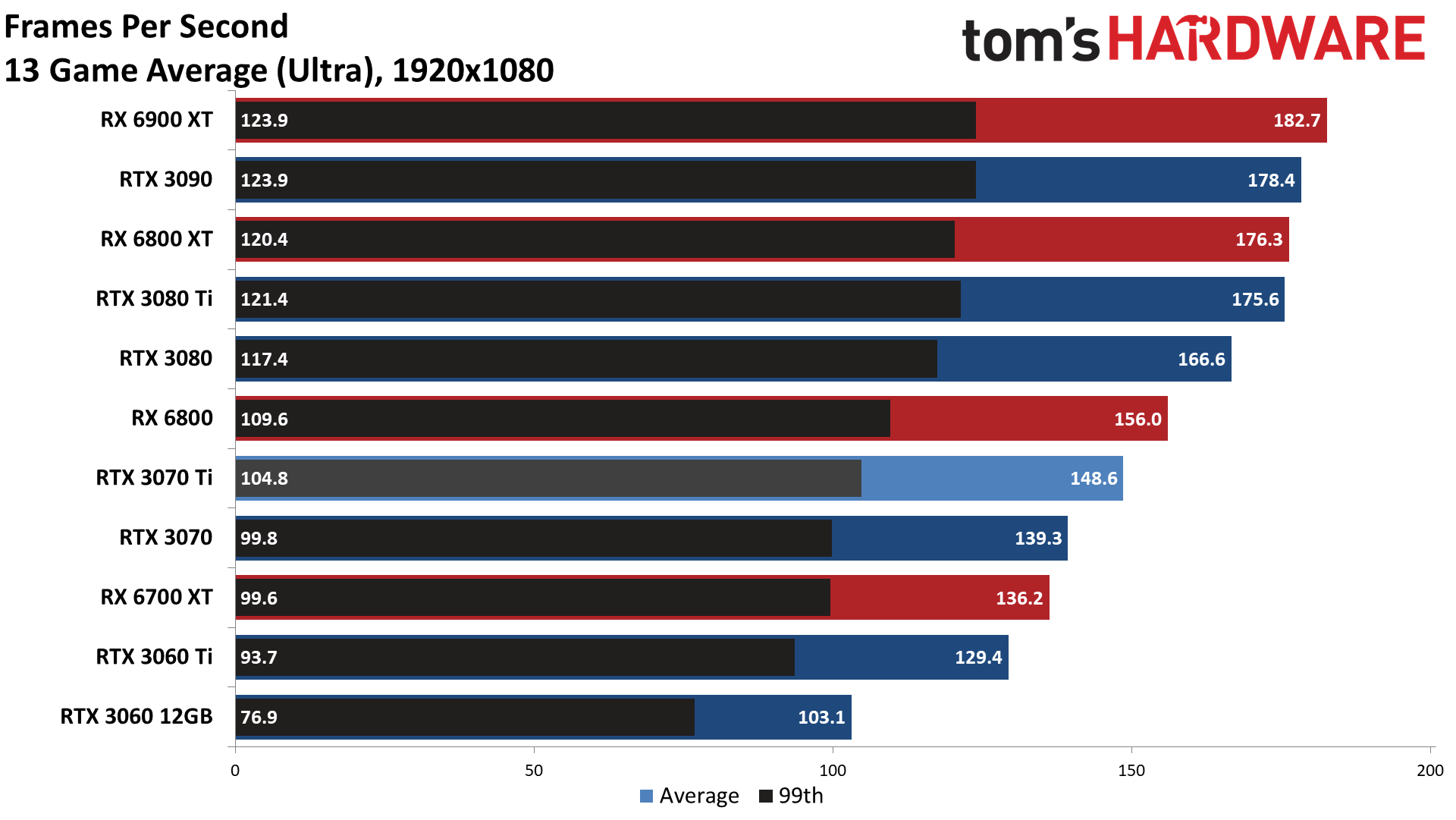
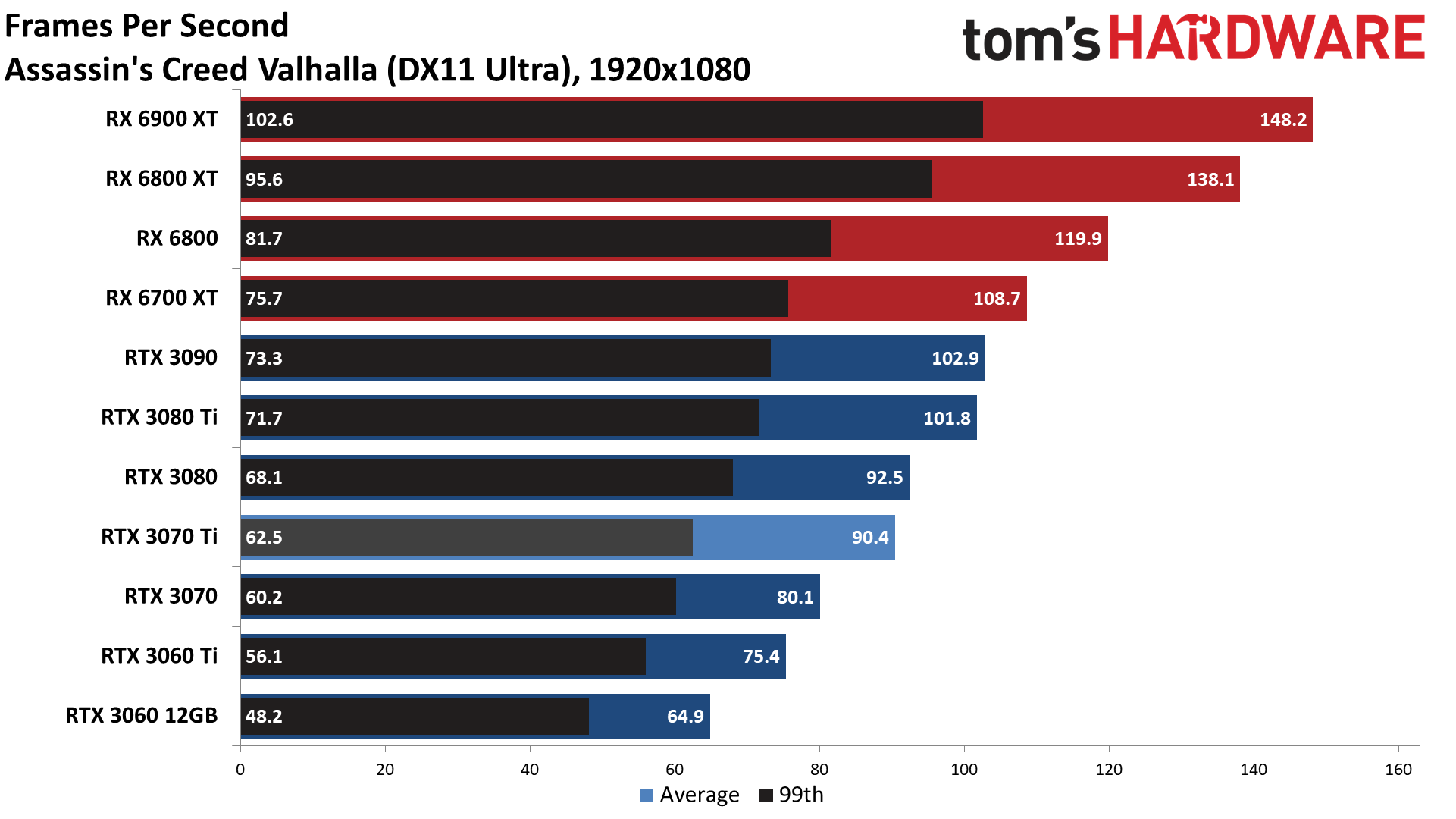
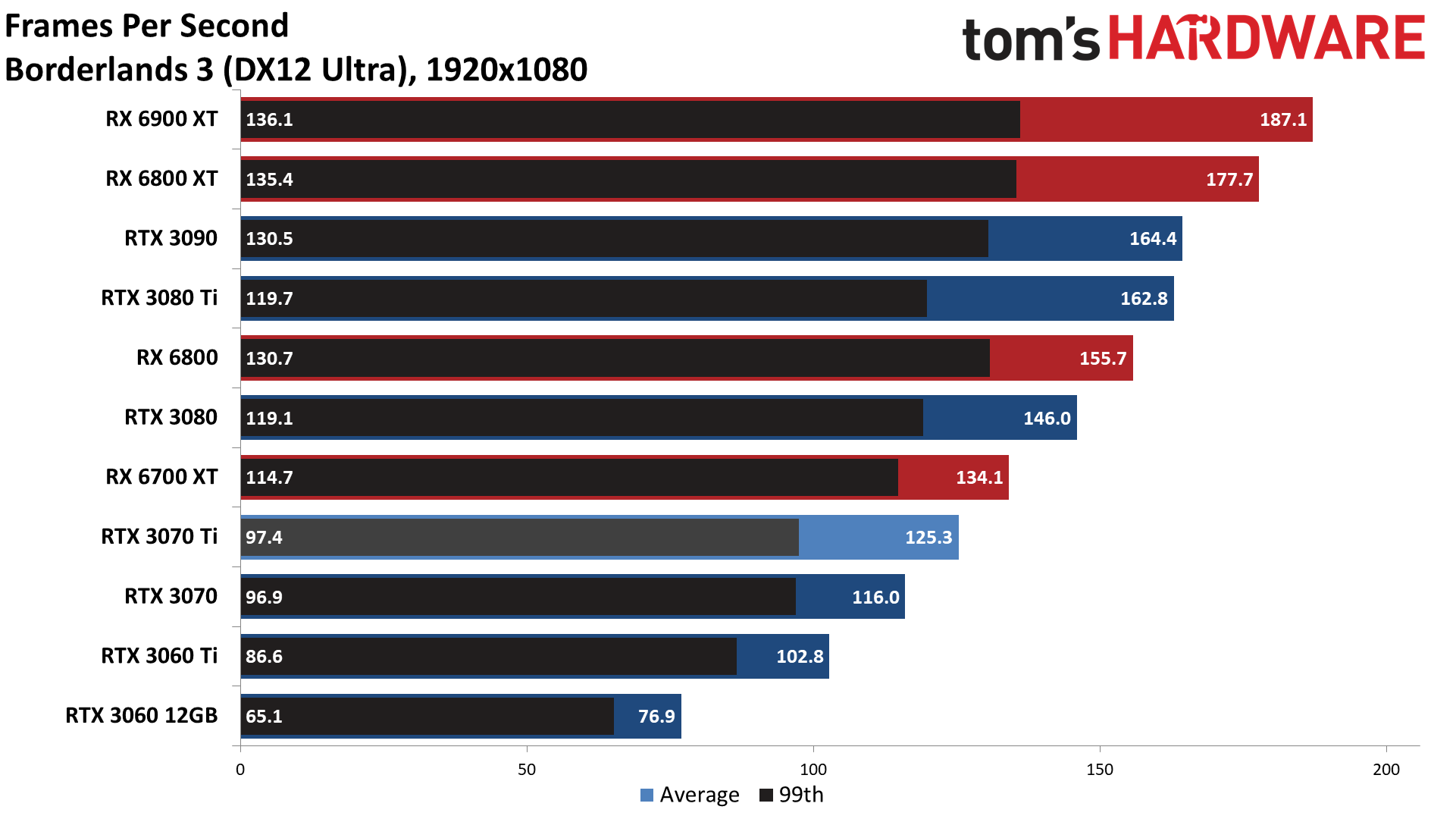
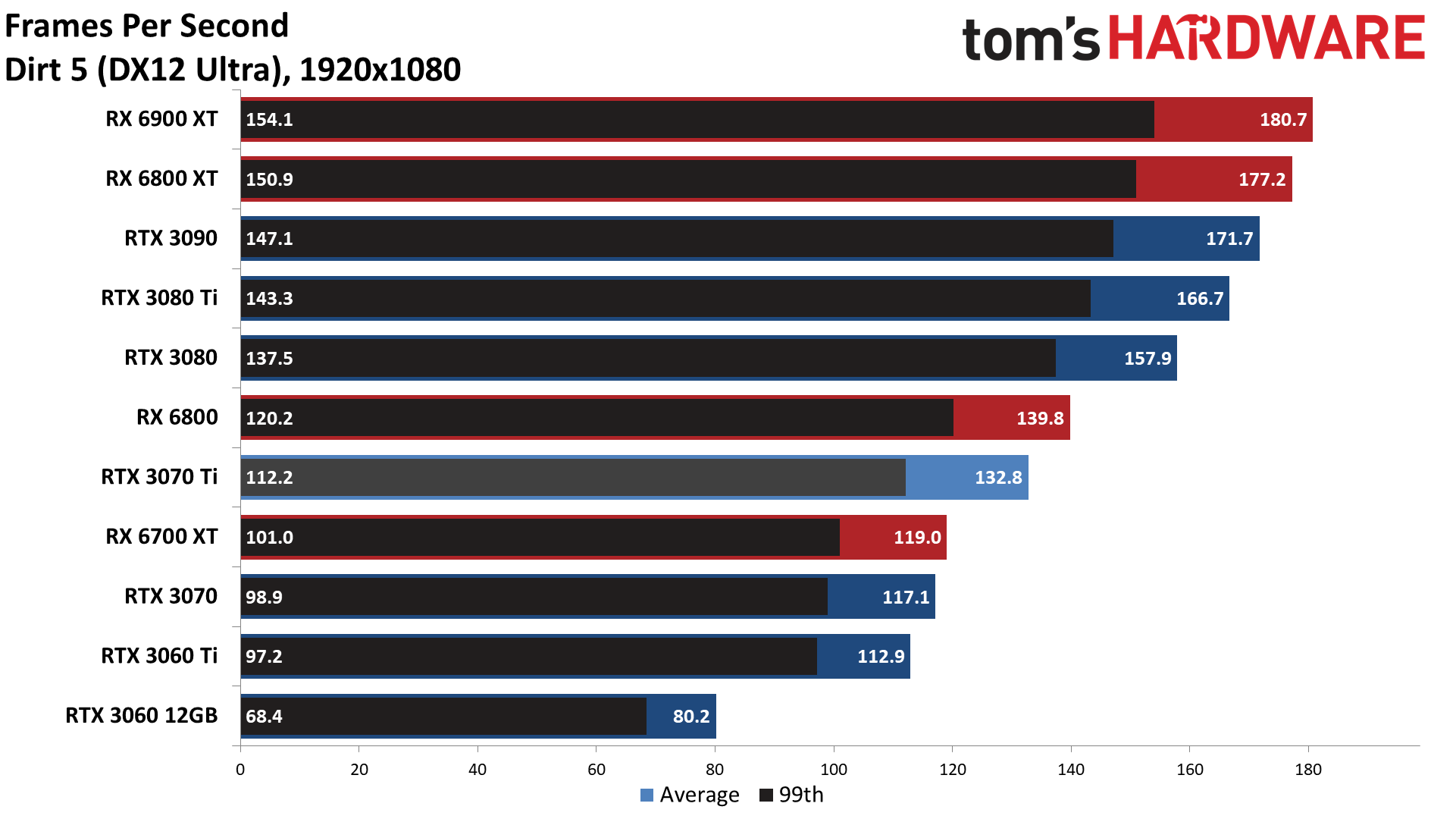
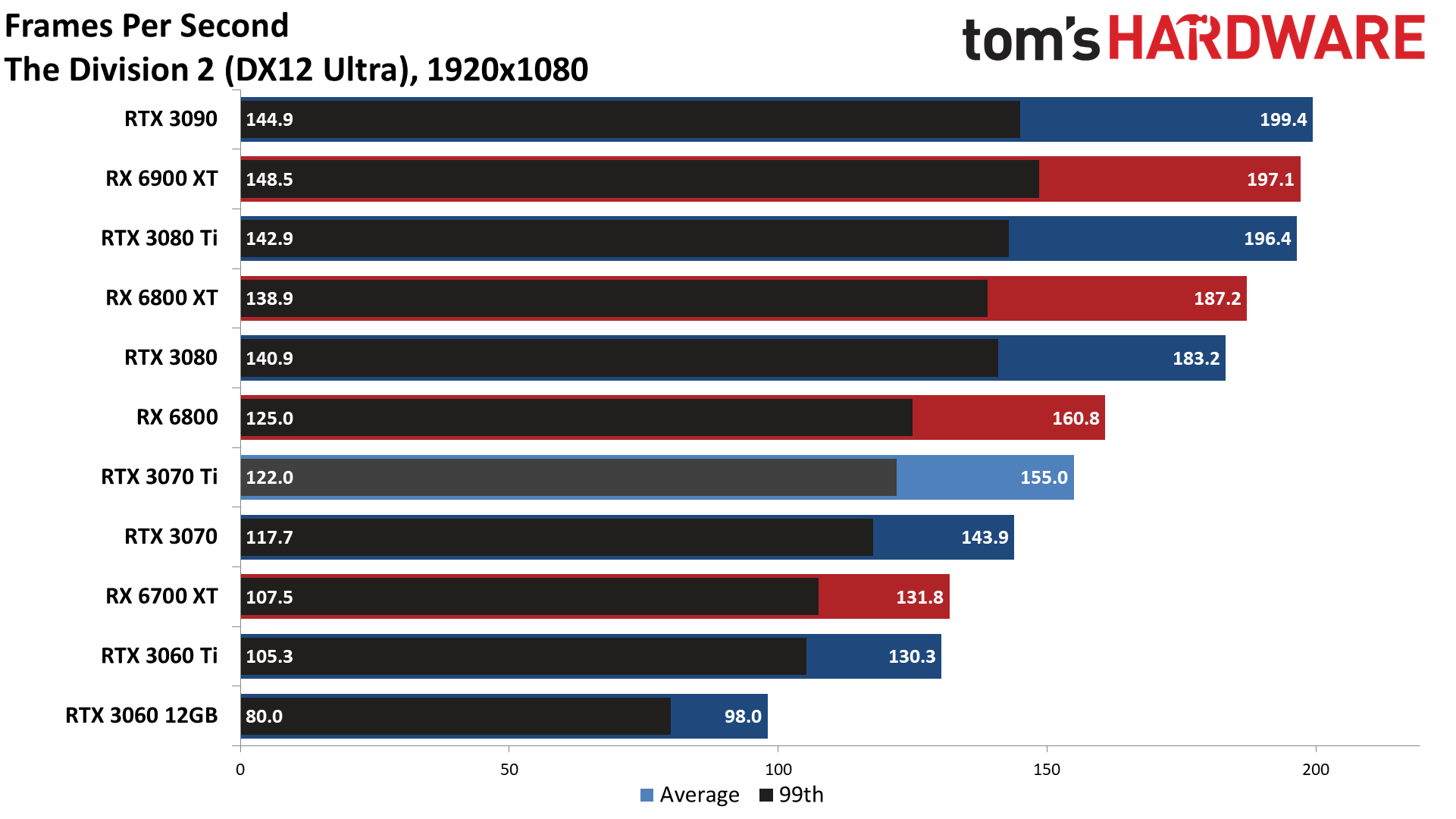


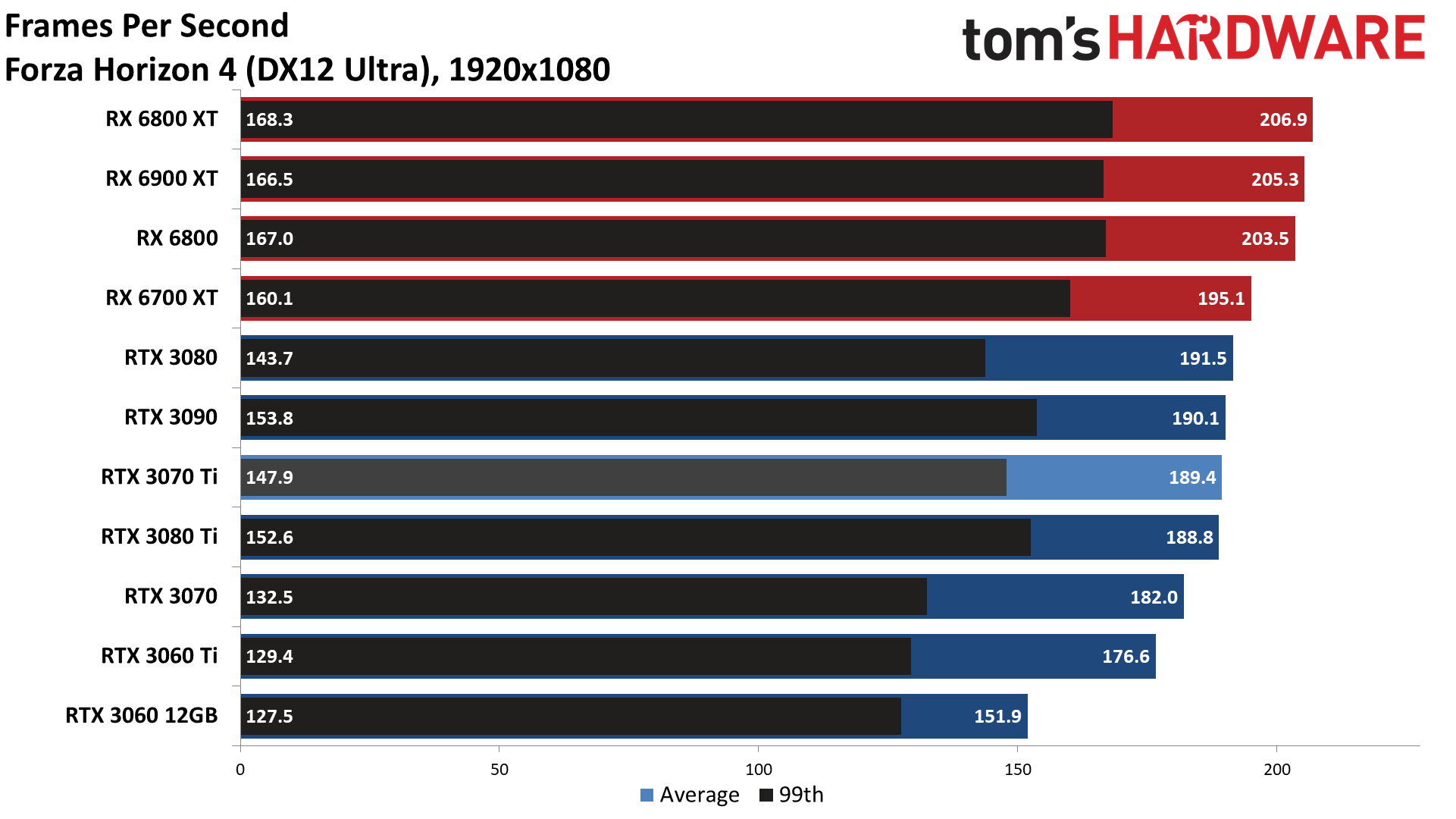
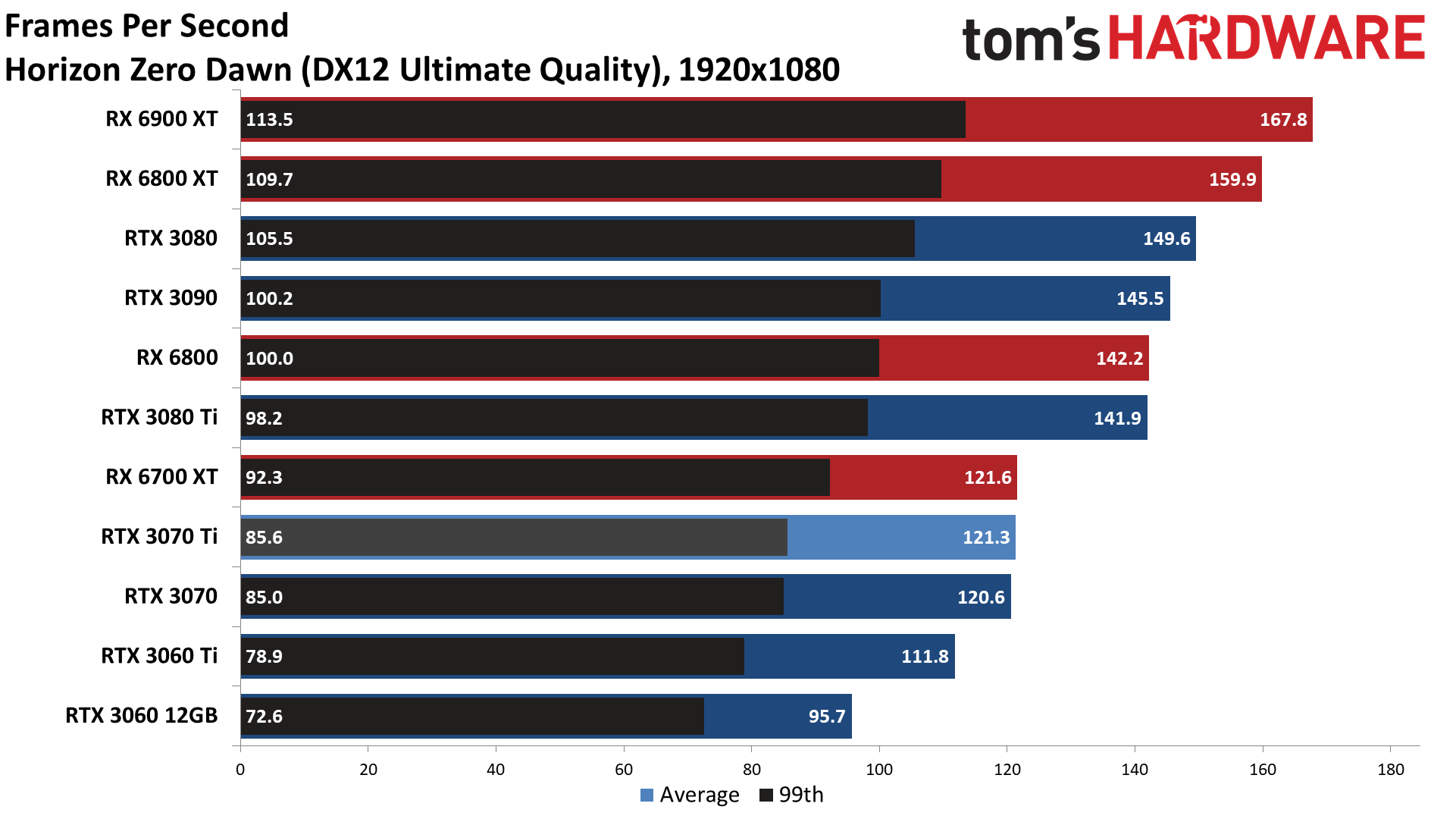

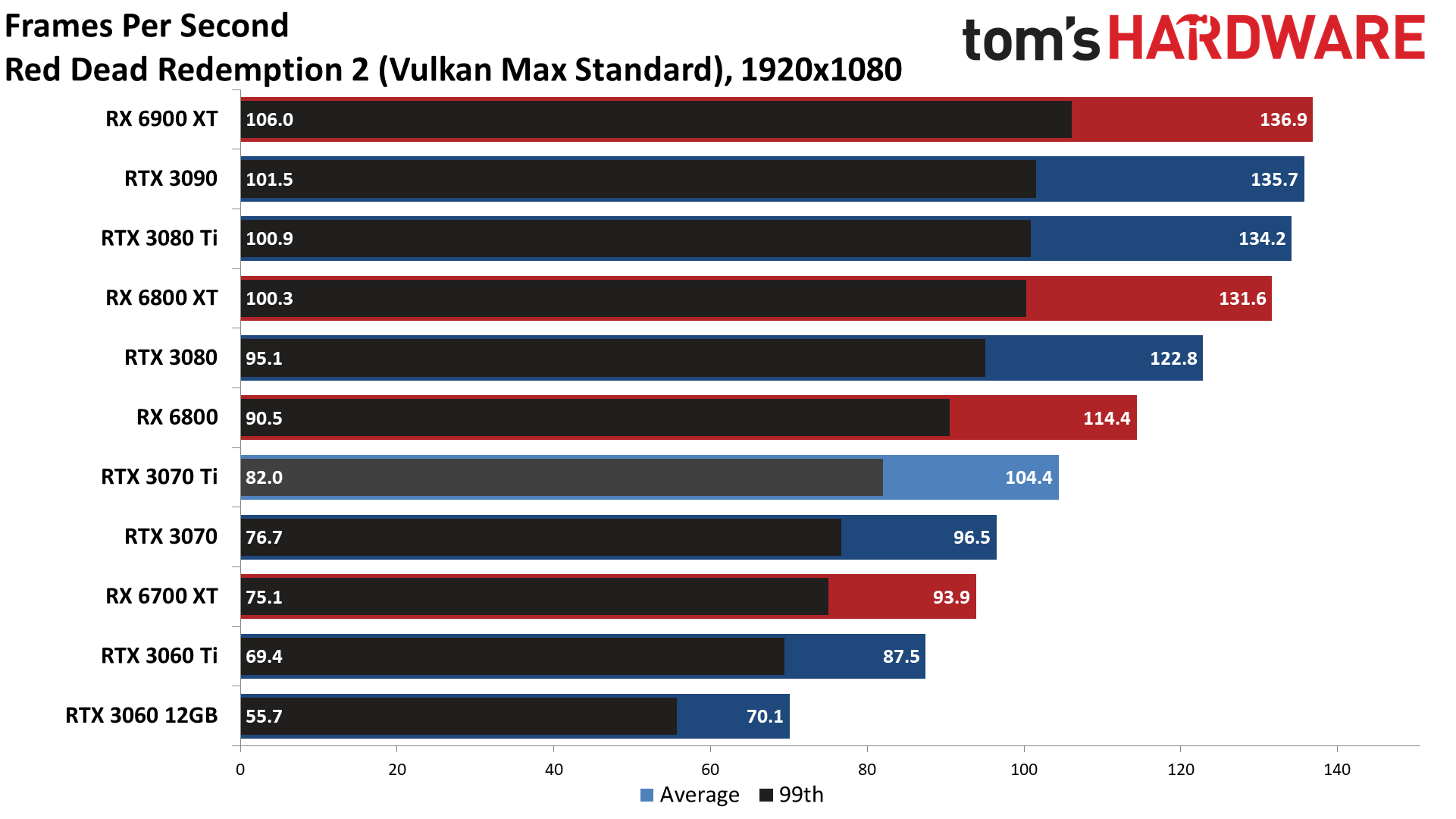


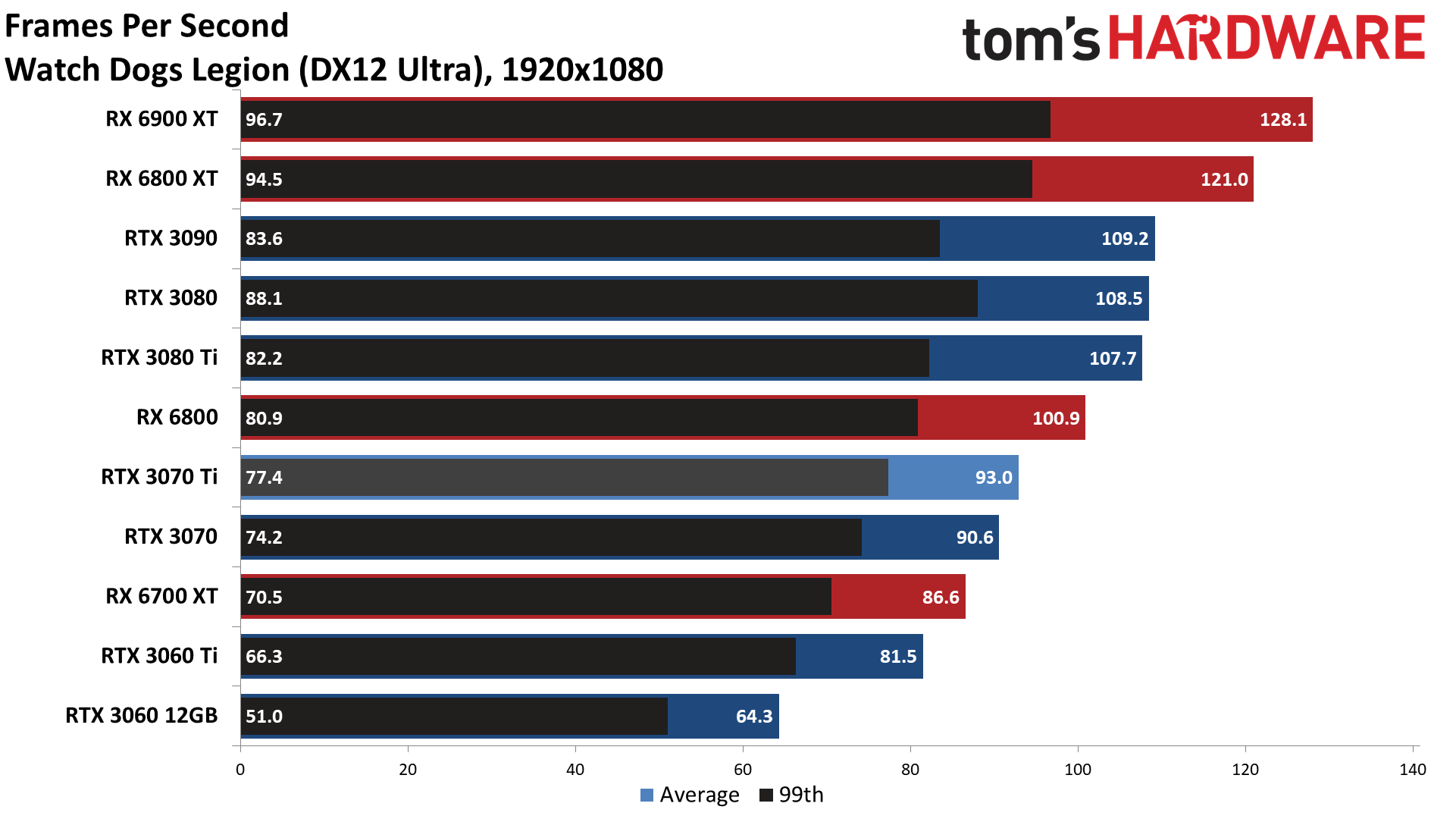
Next up is 1080p testing. Lowering the resolution tends to make games more CPU limited, and that's exactly what we see. The 3070 Ti was 7% faster than the 3070 this time and 11% slower than the 3080. It was also 7% faster than the 6700 XT and 6% slower than the 6800. While you can still easily play games at 1080p on the RTX 3070 Ti, the same is true of most of the other GPUs on our charts.
We won't belabor the point, other than to note that our current test suite is slightly more tilted in favor of AMD GPUs (six AMD-promoted games compared to four Nvidia-promoted games, with three 'agnostic' games). We'll make up for that when we hit the ray tracing benchmarks in a moment.
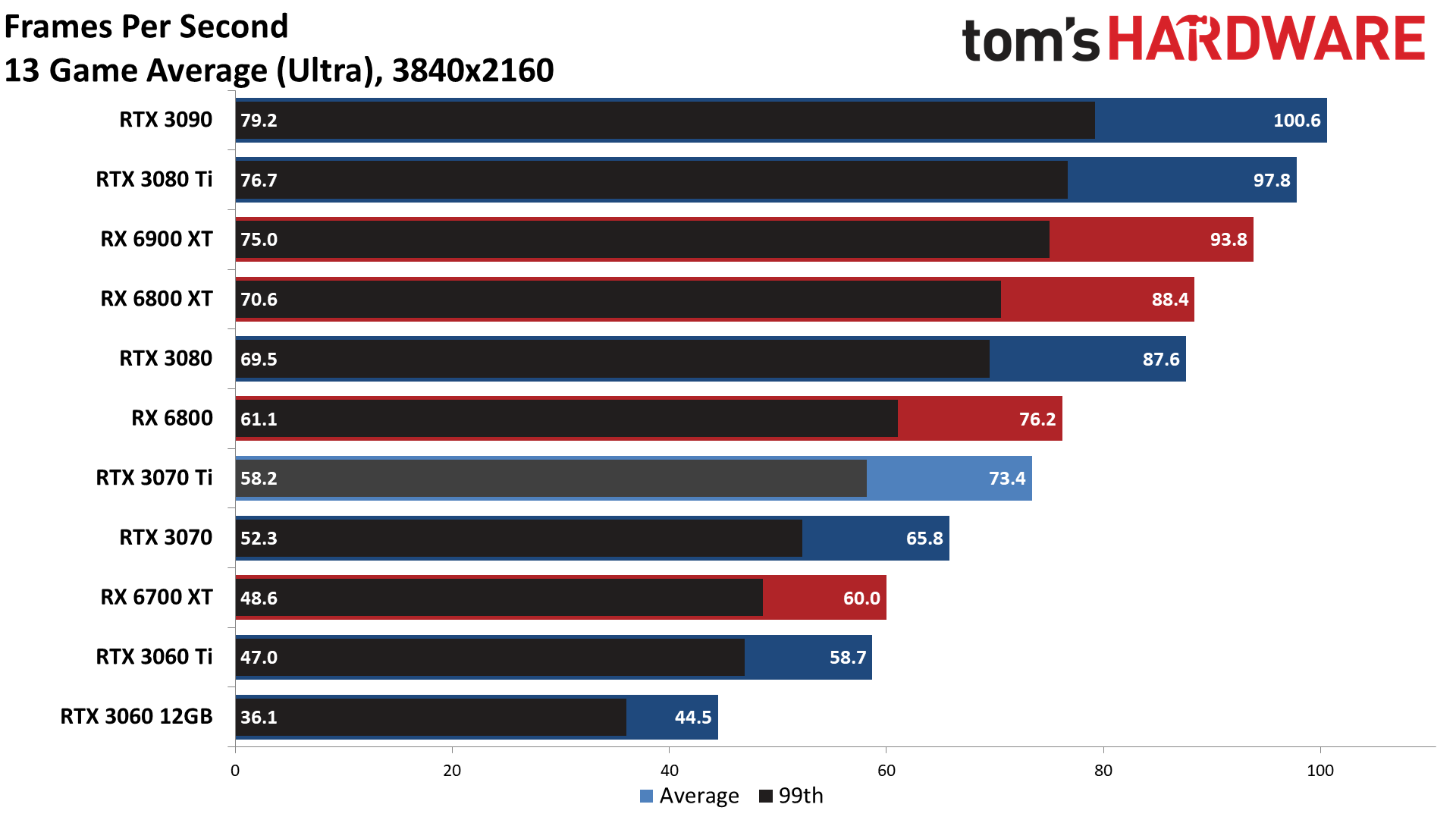


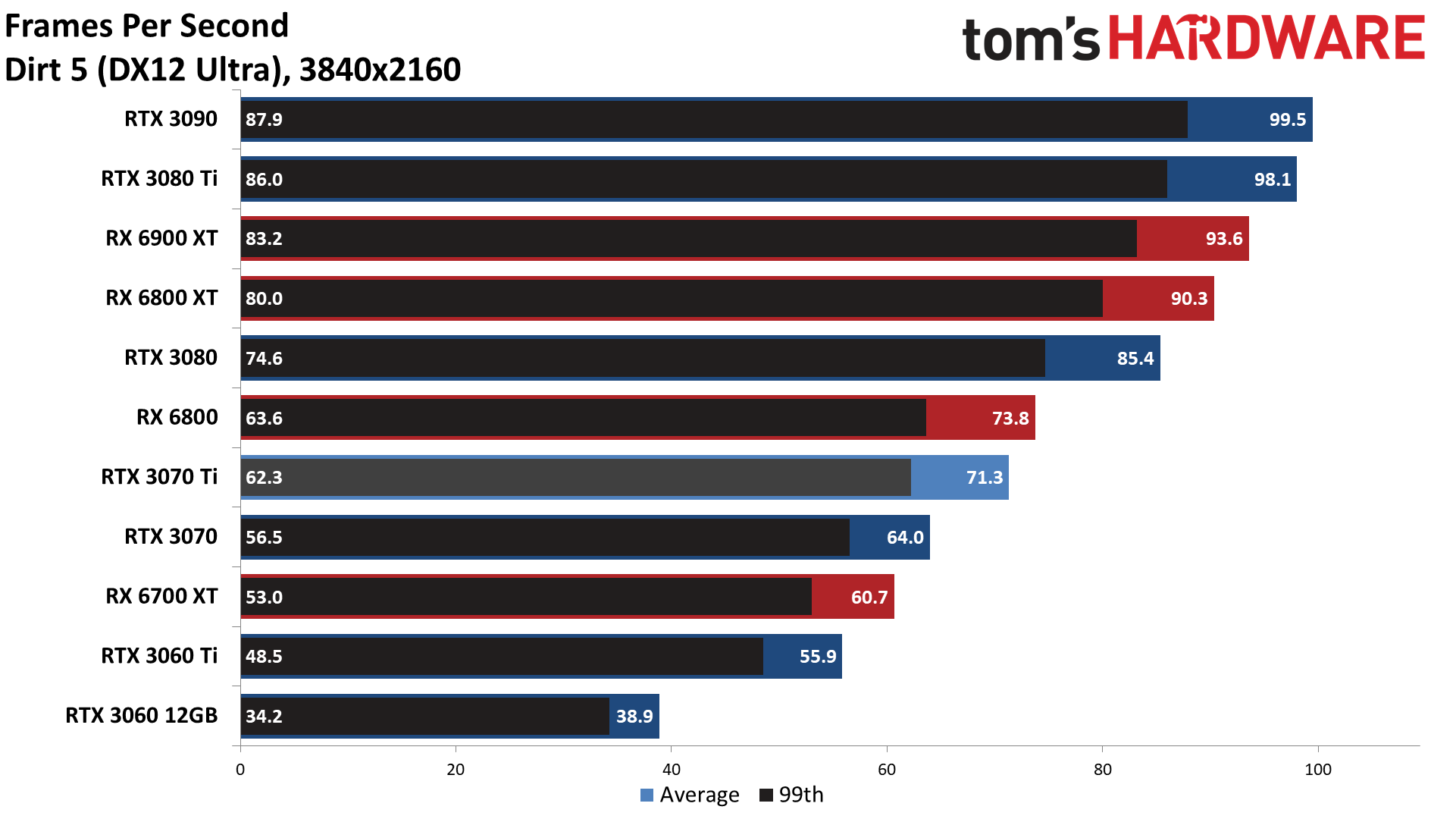
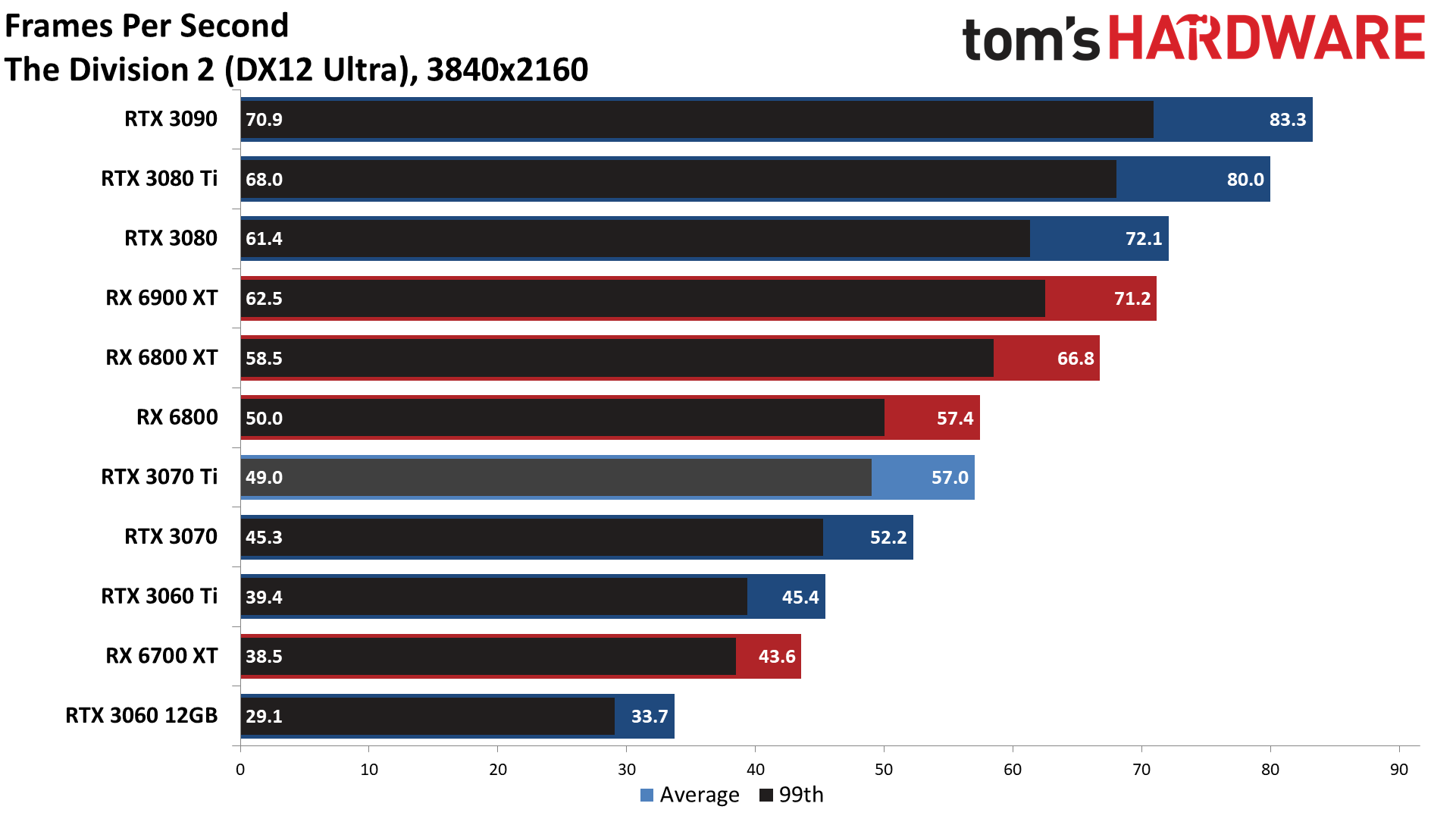
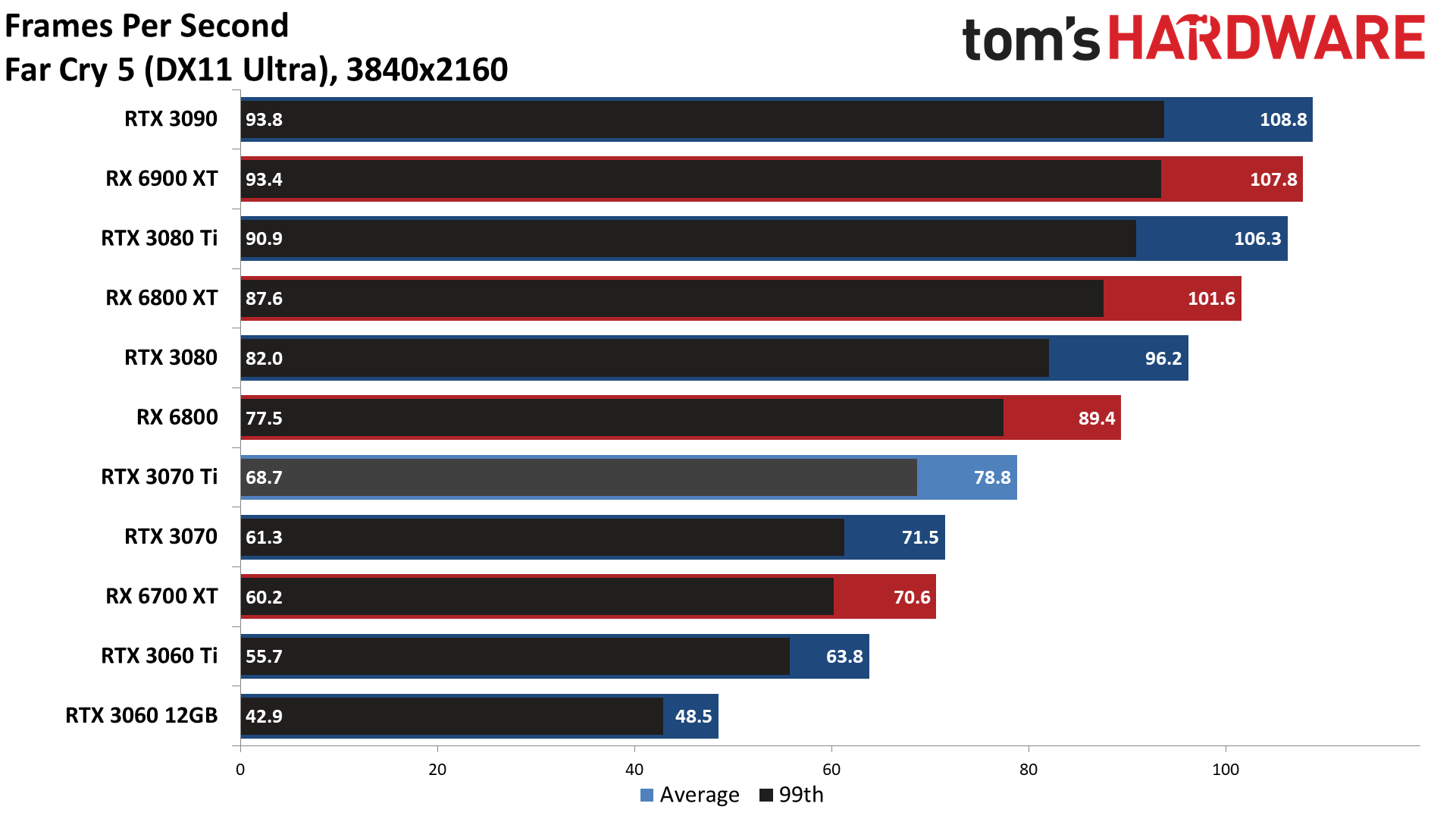
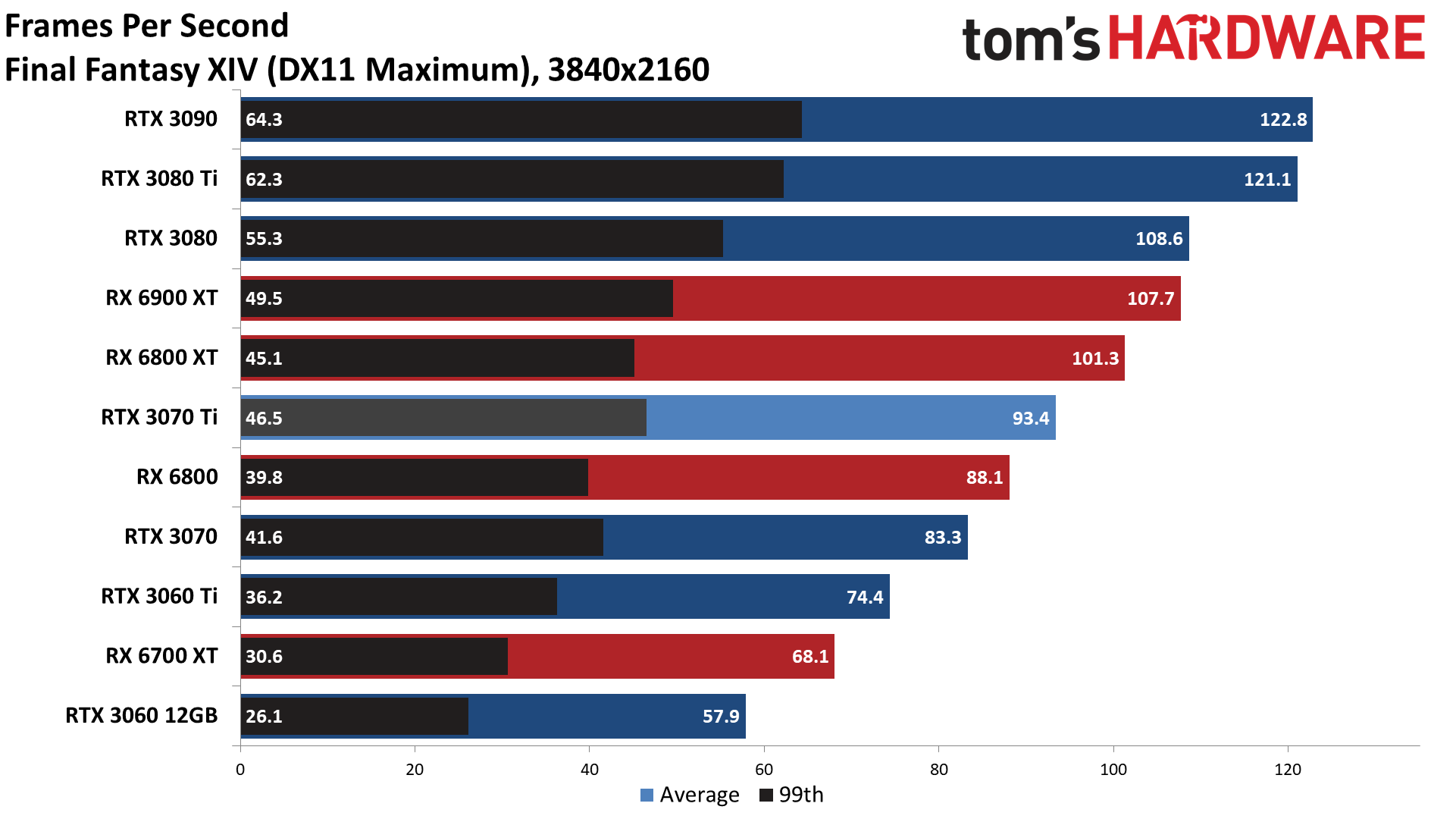
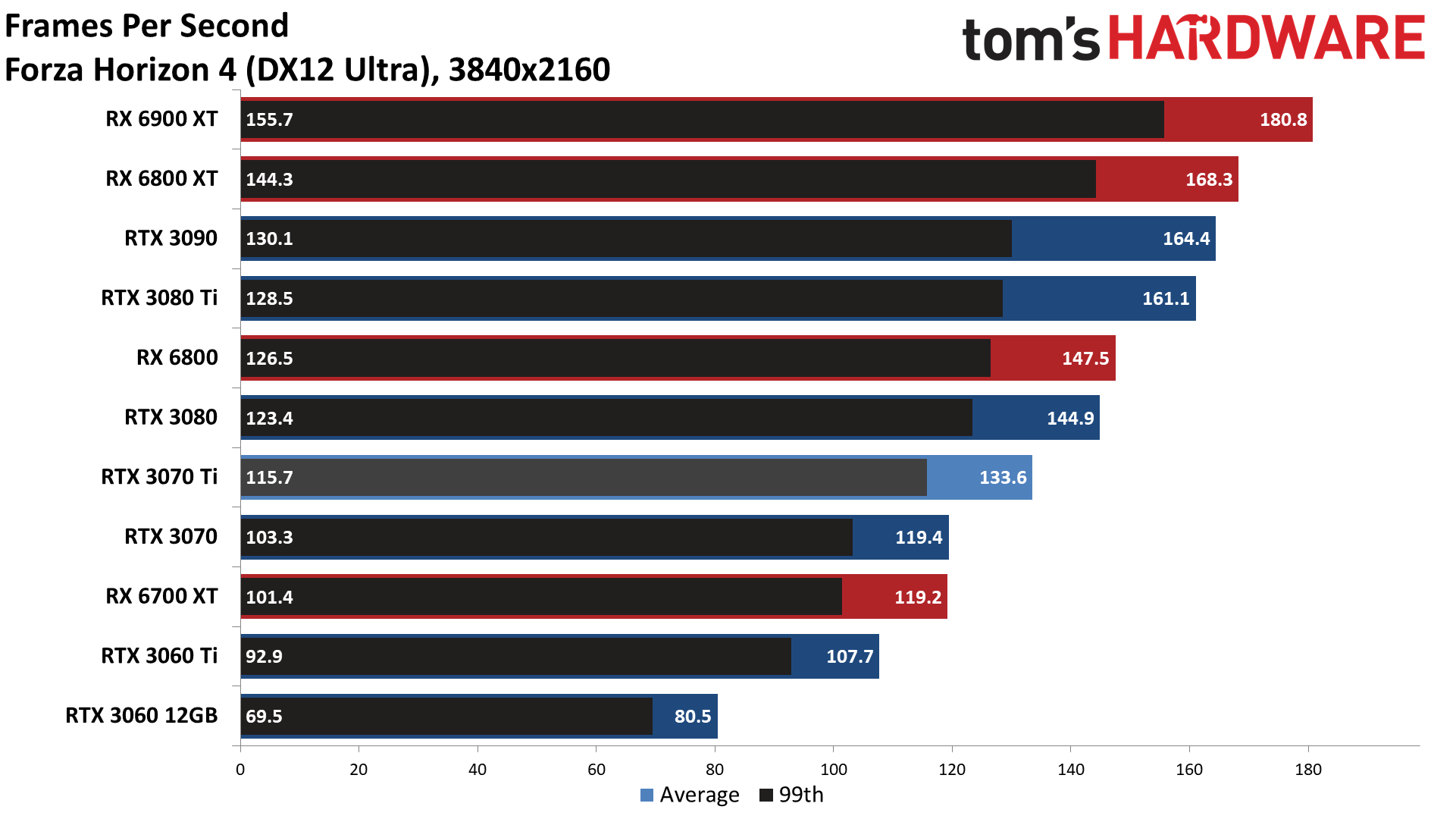

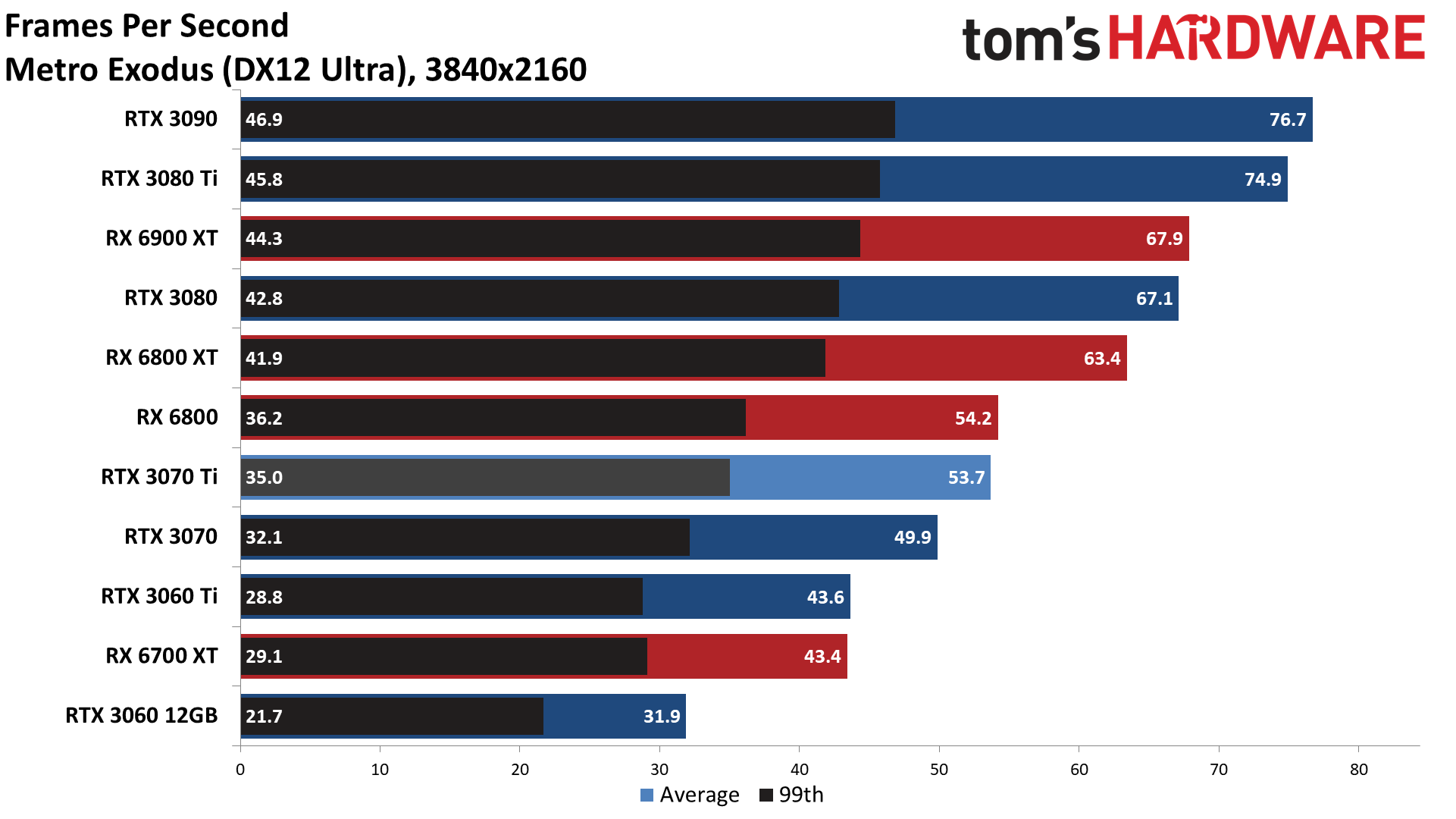
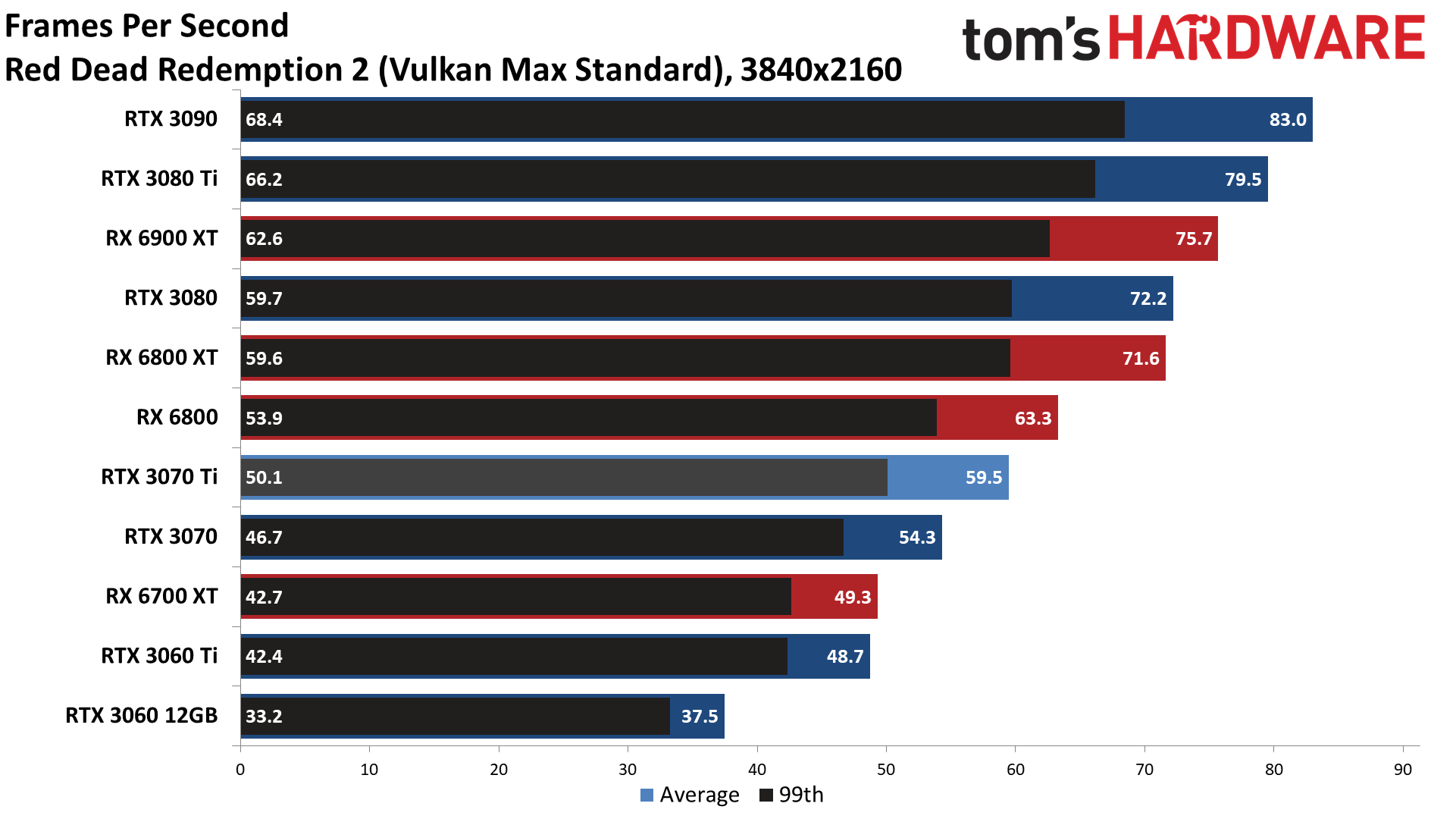
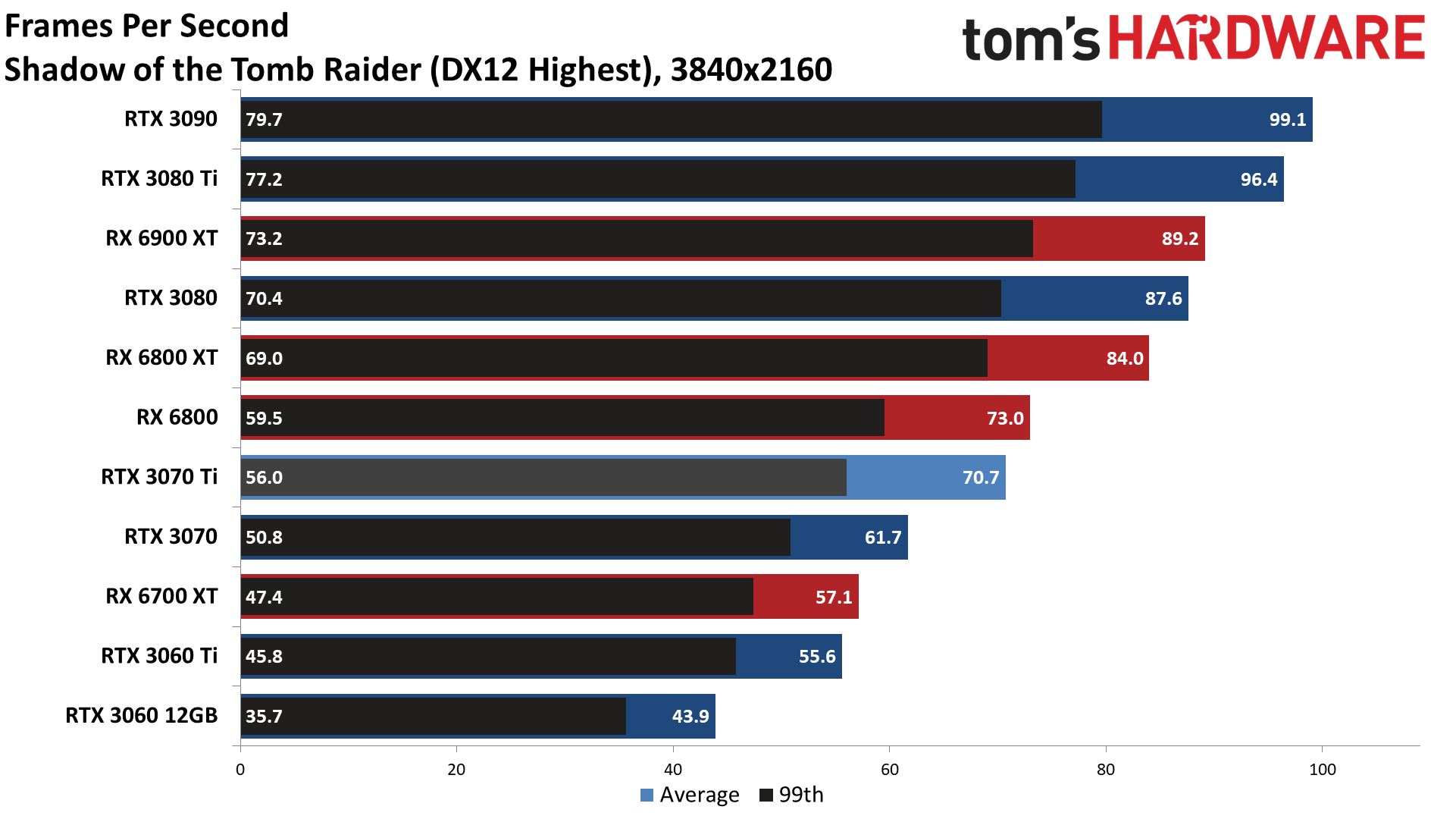
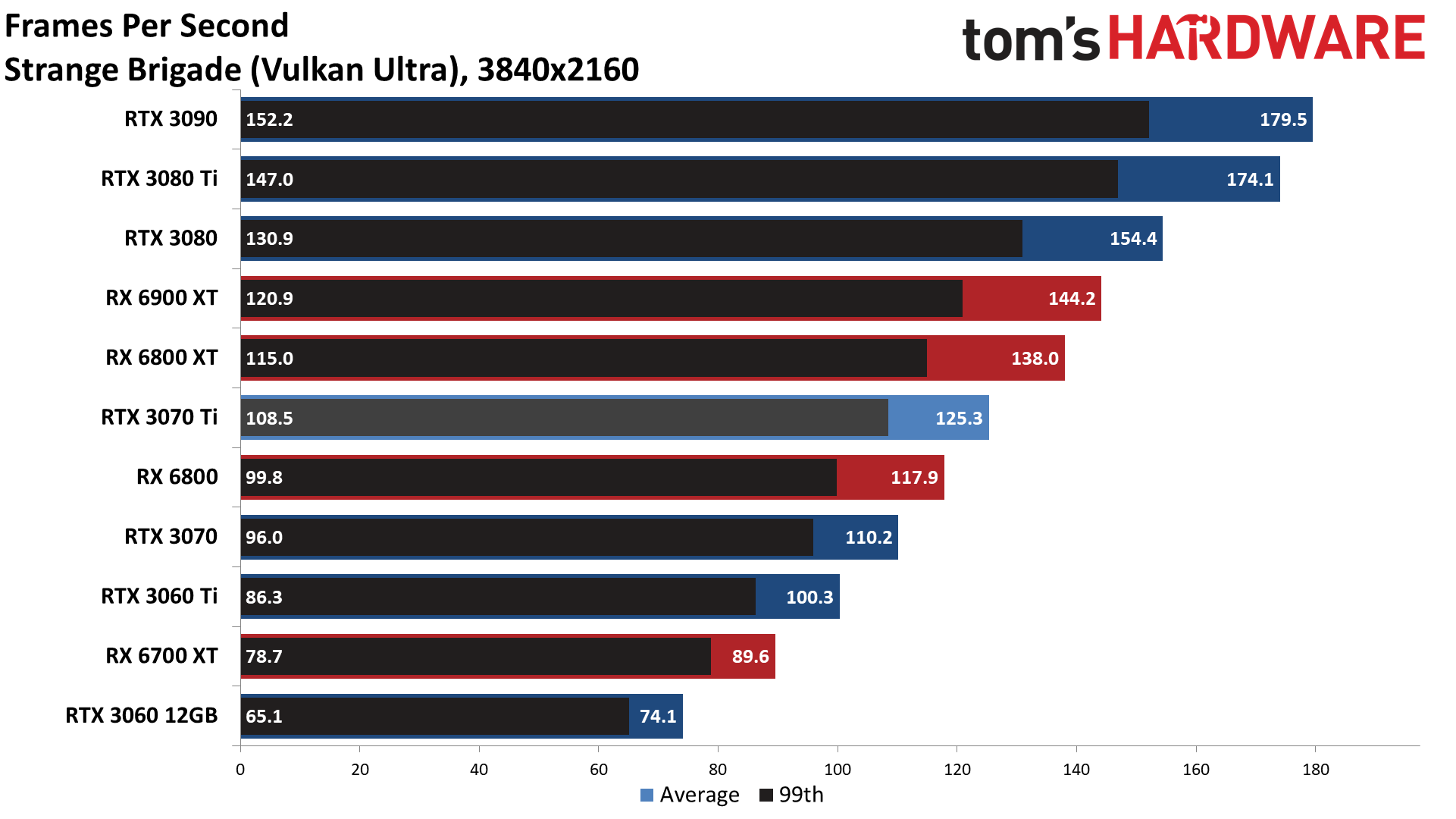
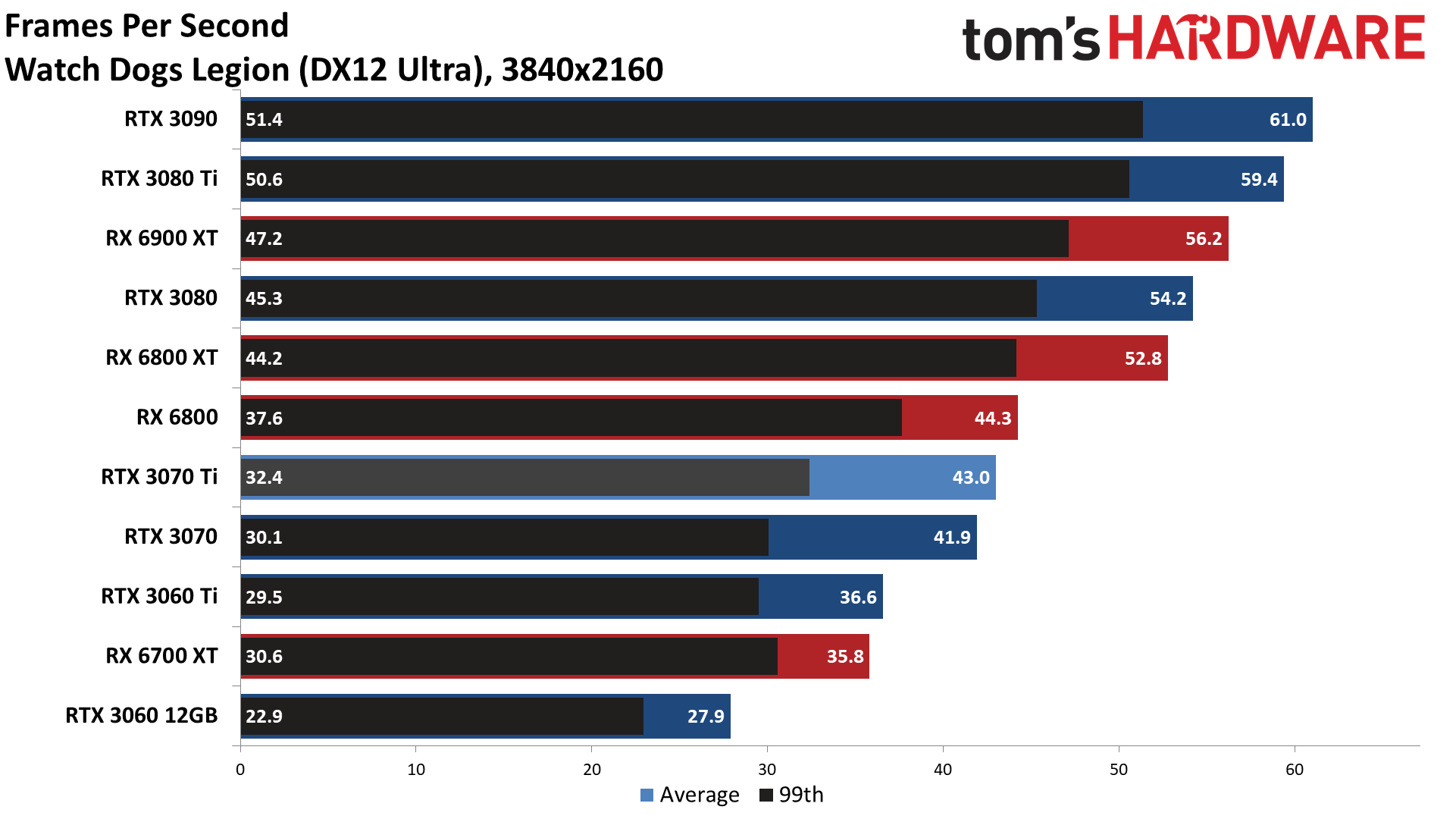
Not surprisingly, while 4K ultra gaming gave the RTX 3070 Ti its biggest lead over the RTX 3070 (11%), it also got its biggest loss (17%) against the 3080. 4K also narrowed the gap between the 3070 Ti and the RX 6800, as AMD's Infinity Cache starts to hit its limits at 4K.
Technically, the RTX 3070 Ti can still play all of the test games at 4K, just not always at more than 60 fps. Nearly half of the games we tested came in below that mark, with Valhalla and Watch Dogs Legion being the two lowest scores — and they're still in the mid-40s. The RTX 3070 was already basically tied with the previous generation RTX 2080 Ti, which means the RTX 3070 Ti is now clearly faster than the previous-gen halo card, at half the price.
GeForce RTX 3070 Ti: Ray Tracing and DLSS Gaming Performance
So far, we've focused on gaming performance using traditional rasterization graphics. We've also excluded using Nvidia's DLSS technology in order to provide an apples-to-apples comparison. Now we'll focus on ray tracing performance, with DLSS 2.0 enabled where applicable. We're only using DLSS in Quality mode (2x upscaling) in the six games where it is supported. We'll have to wait for AMD's FSR to see if it can provide a reasonable alternative to DLSS 2.0 in the coming months, though Nvidia clearly has a lengthy head start. Note that these are the same tests we used in our recent AMD vs. Nvidia Ray Tracing Battle.

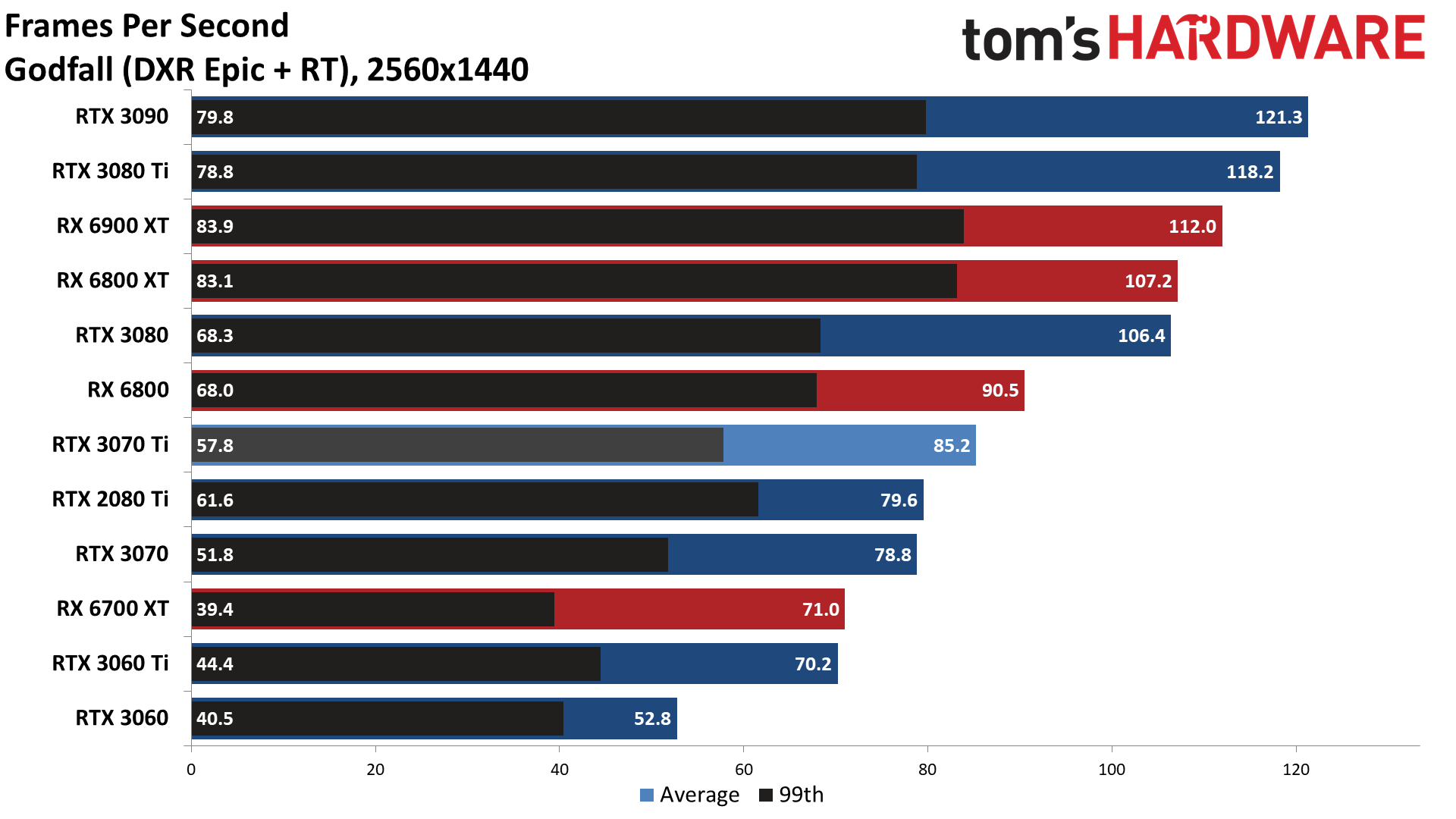
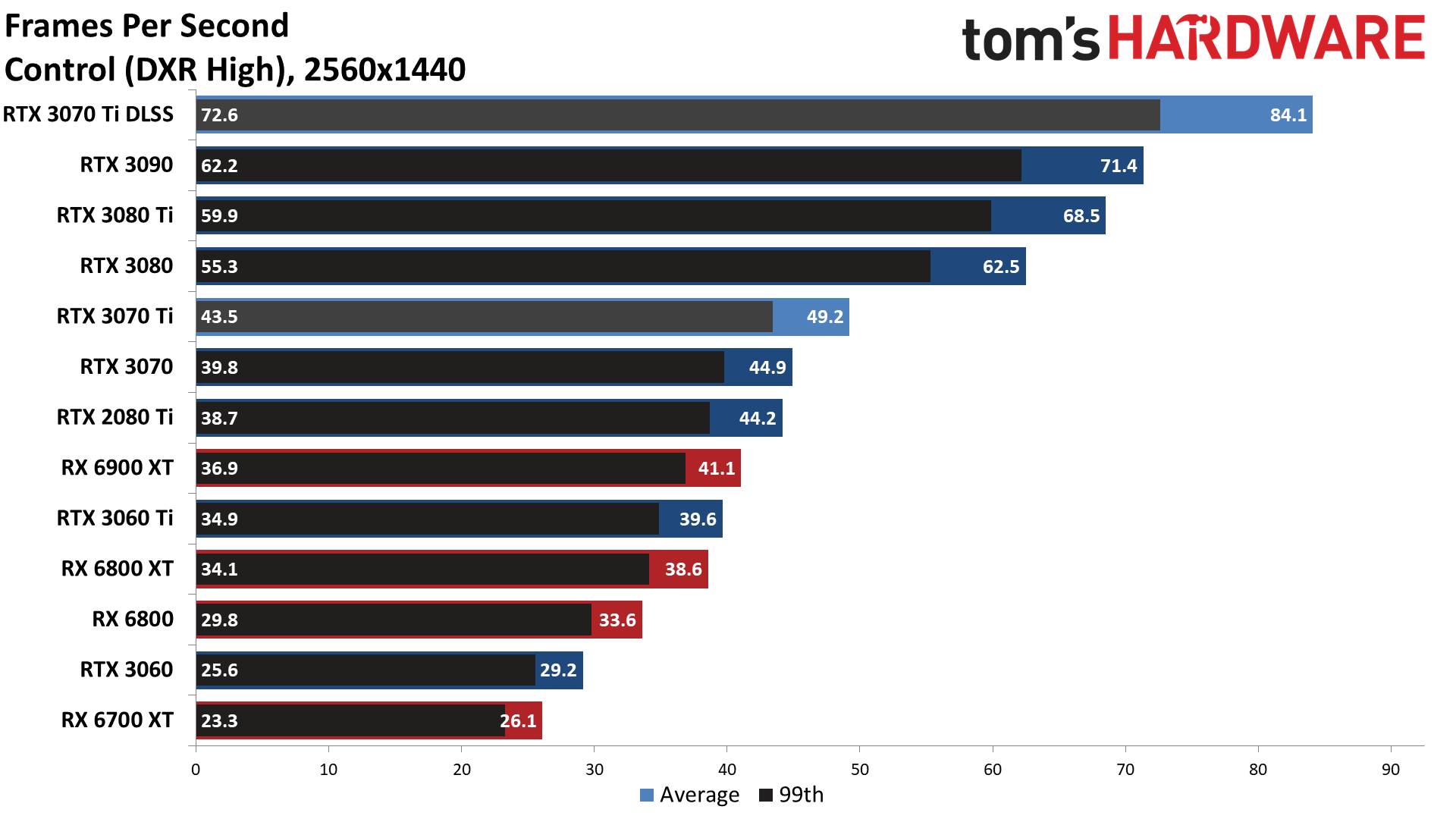
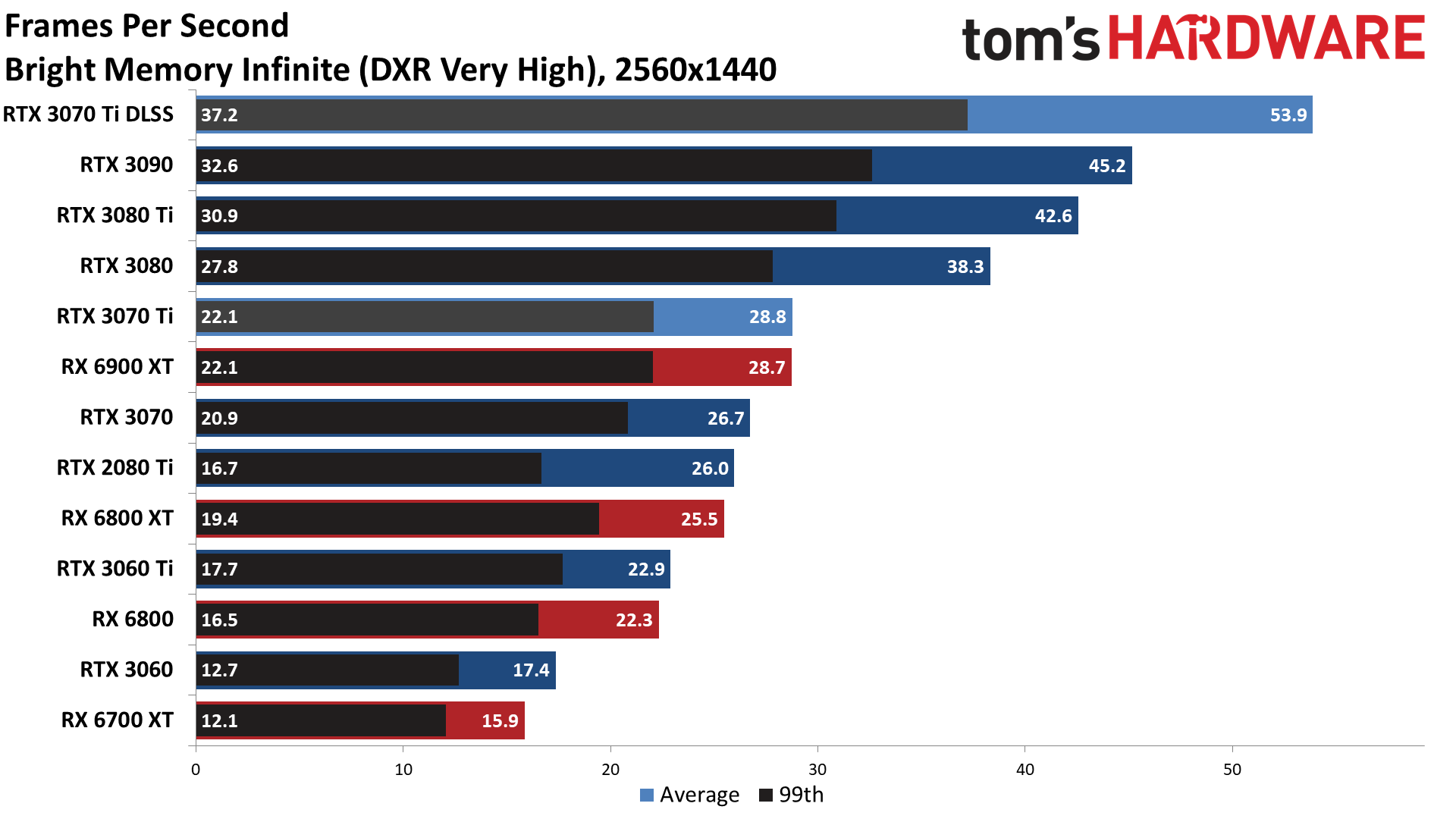

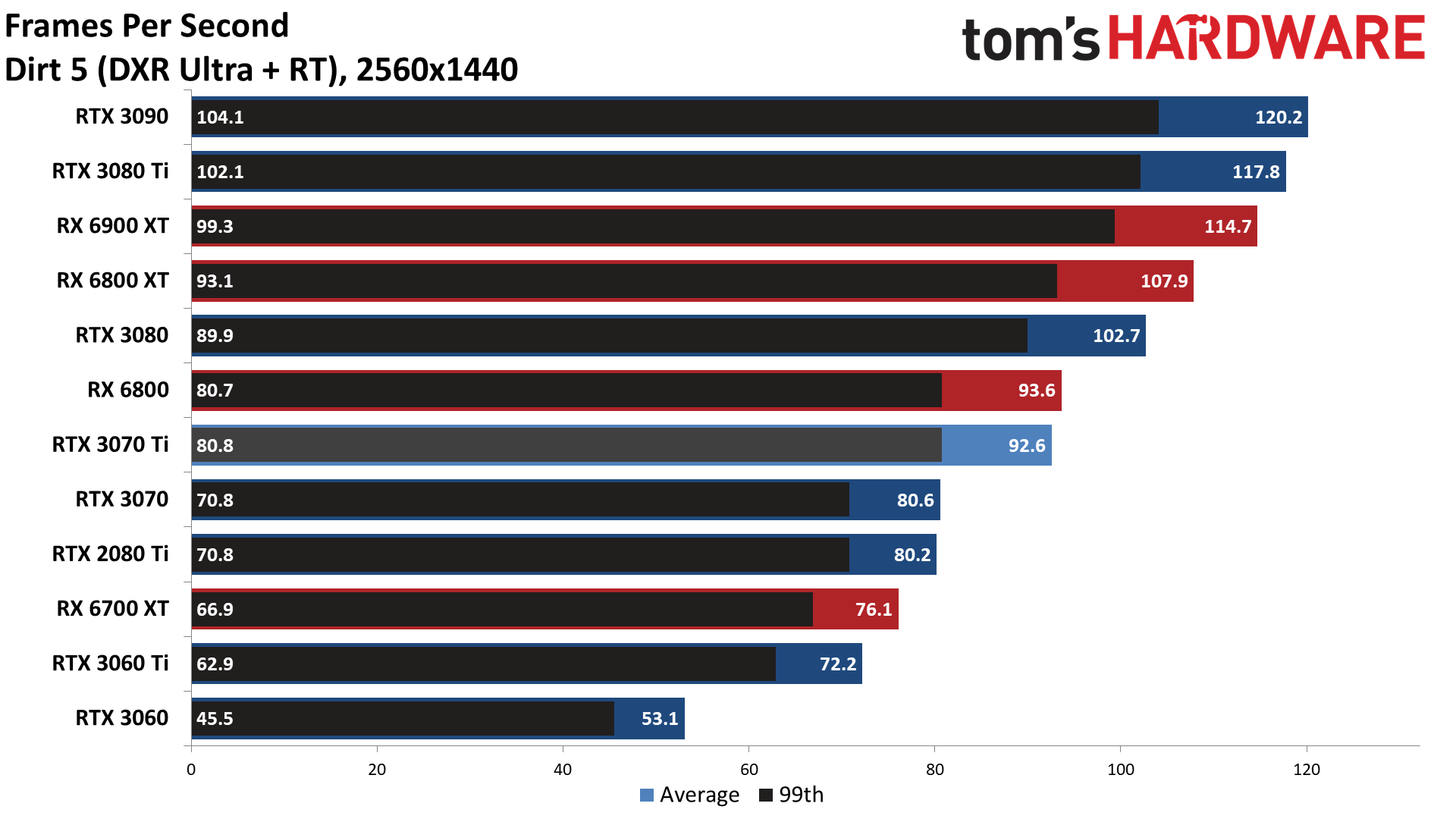
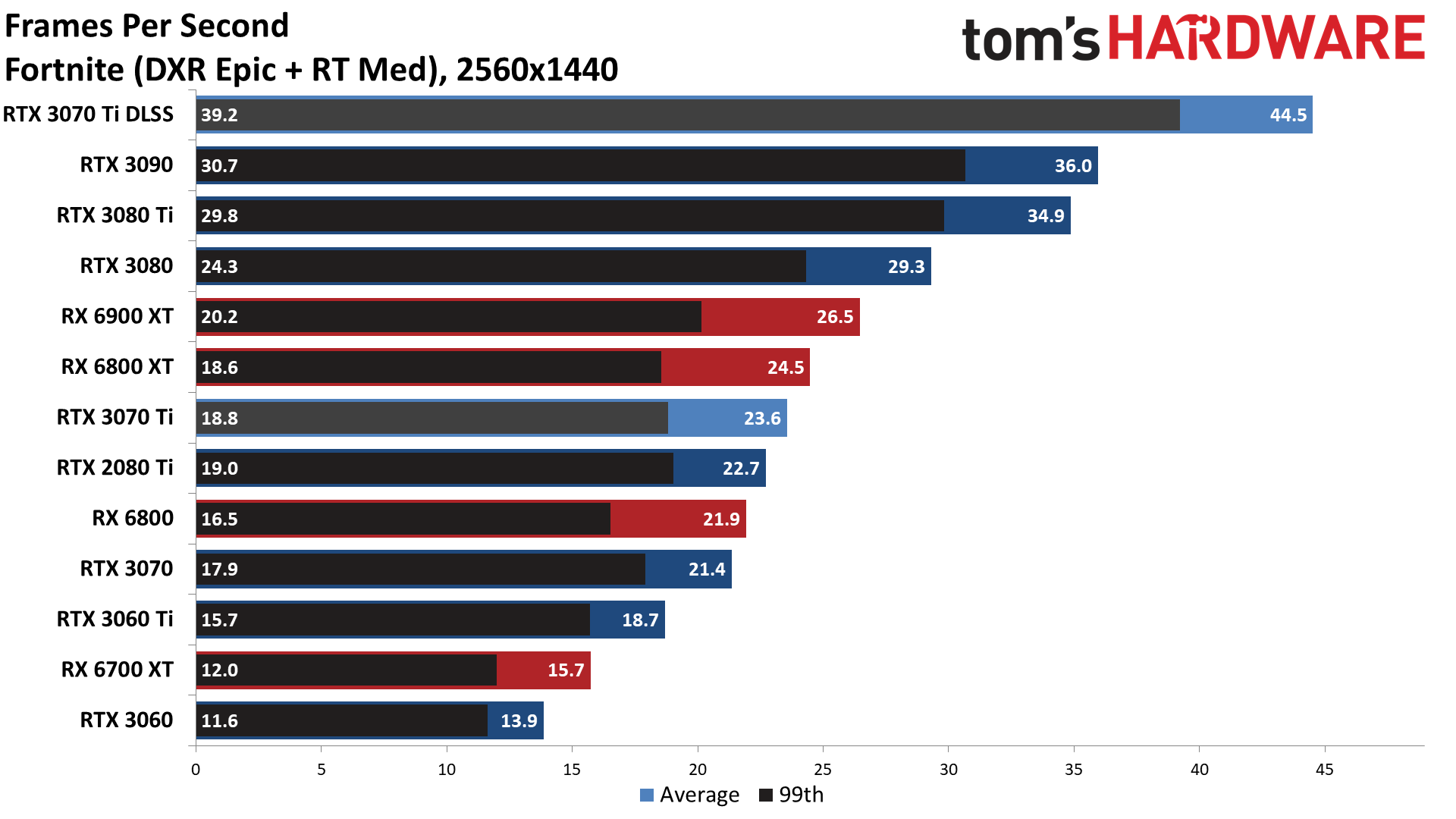
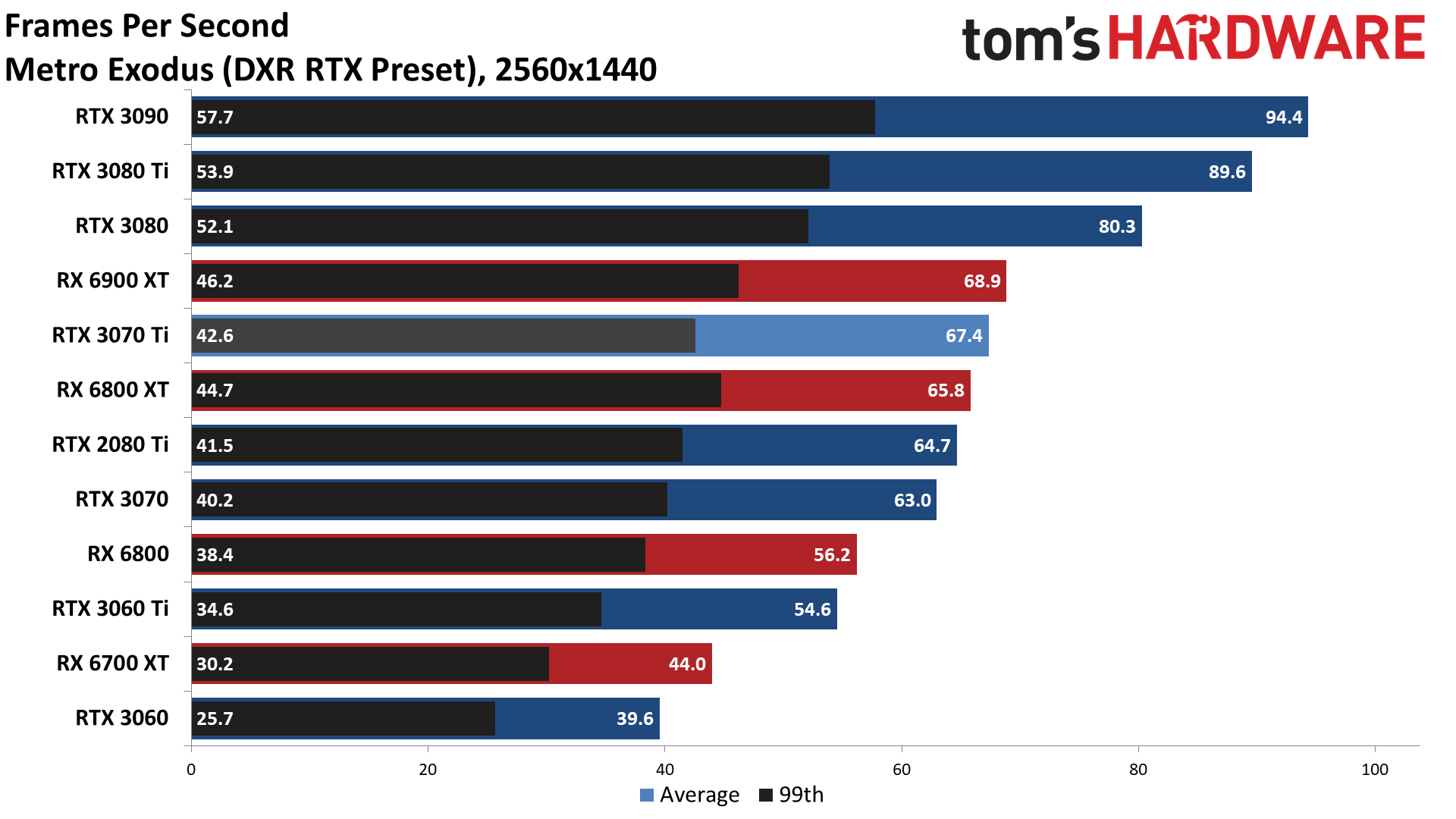

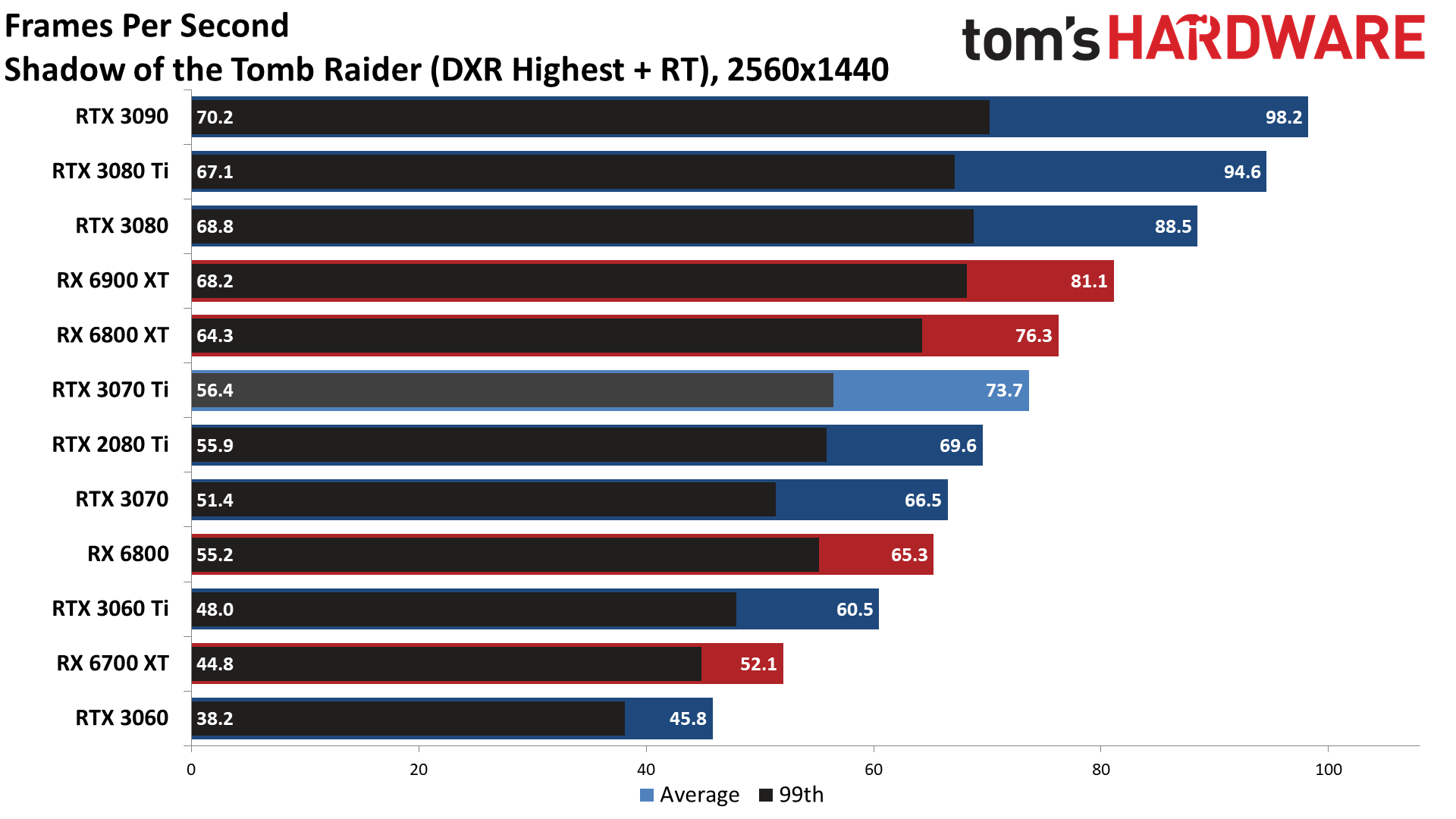
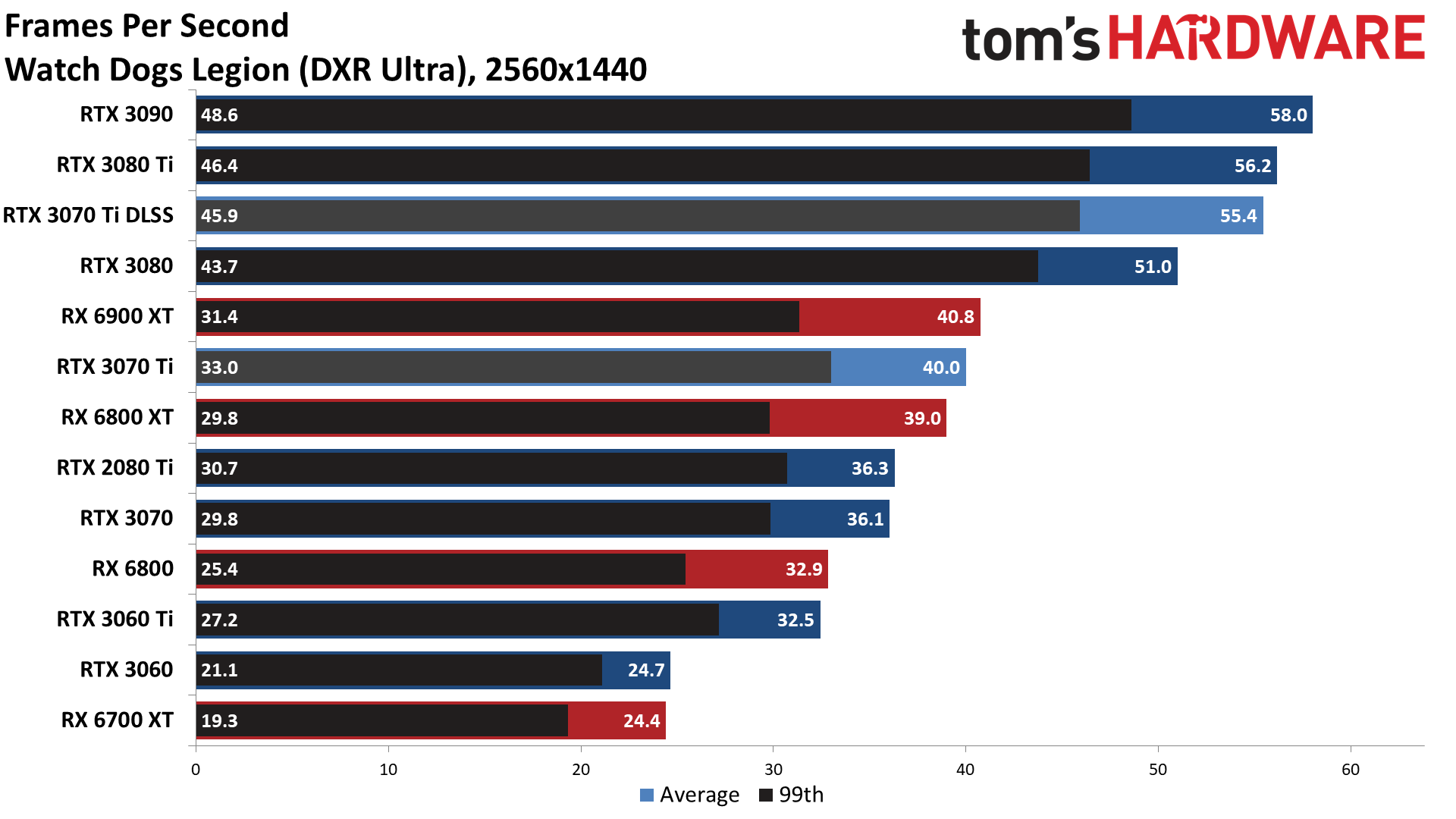
Nvidia's RTX 3070 Ti does far better — at least against the AMD competition — in ray tracing games. It's not a complete sweep, as the RX 6800 still leads in Godfall, but the 3070 Ti ties or wins in every other game. In fact, the 3070 Ti basically ties the RX 6800 XT in our ray tracing test suite, and that's before we enable DLSS 2.0.

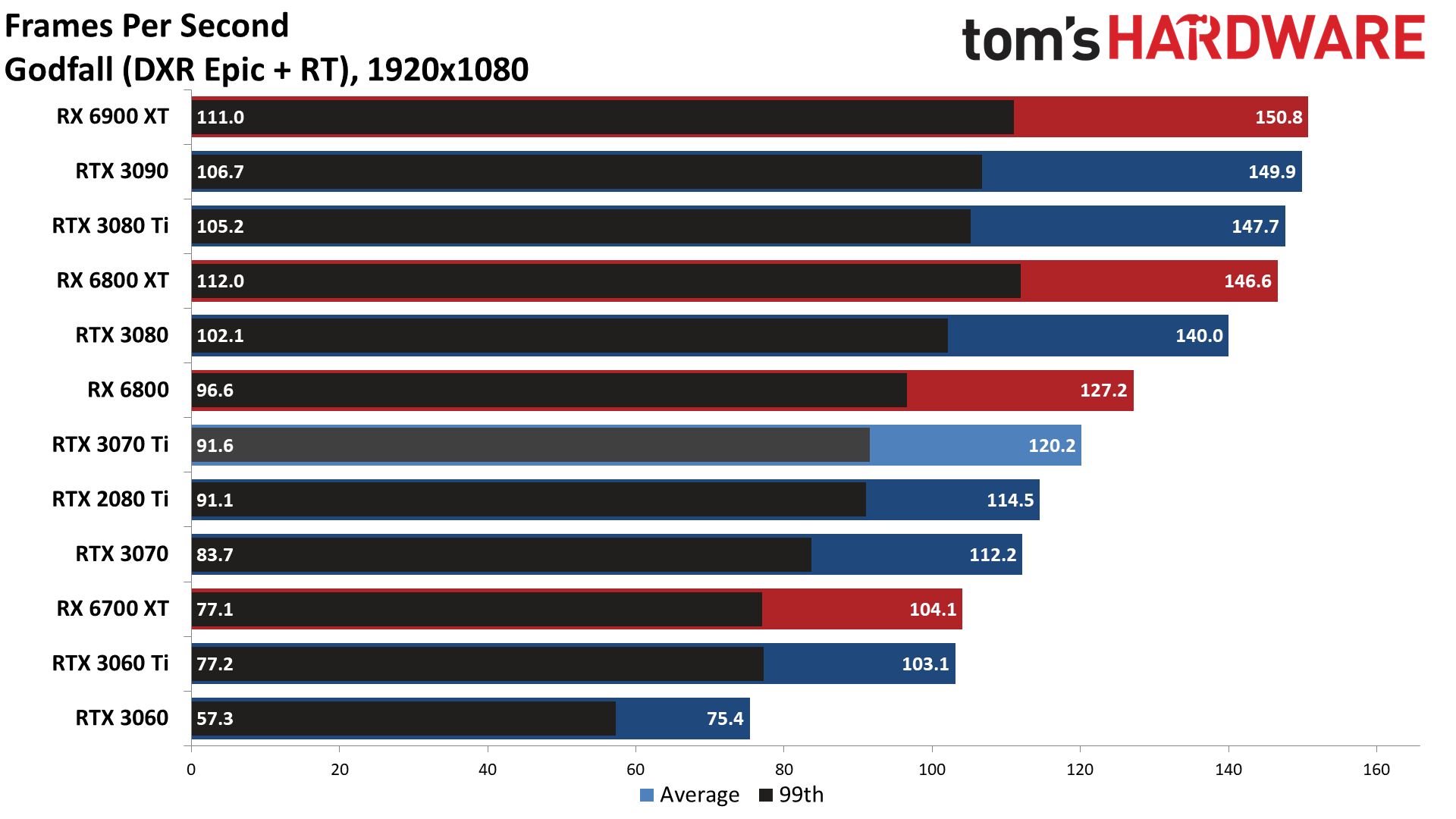
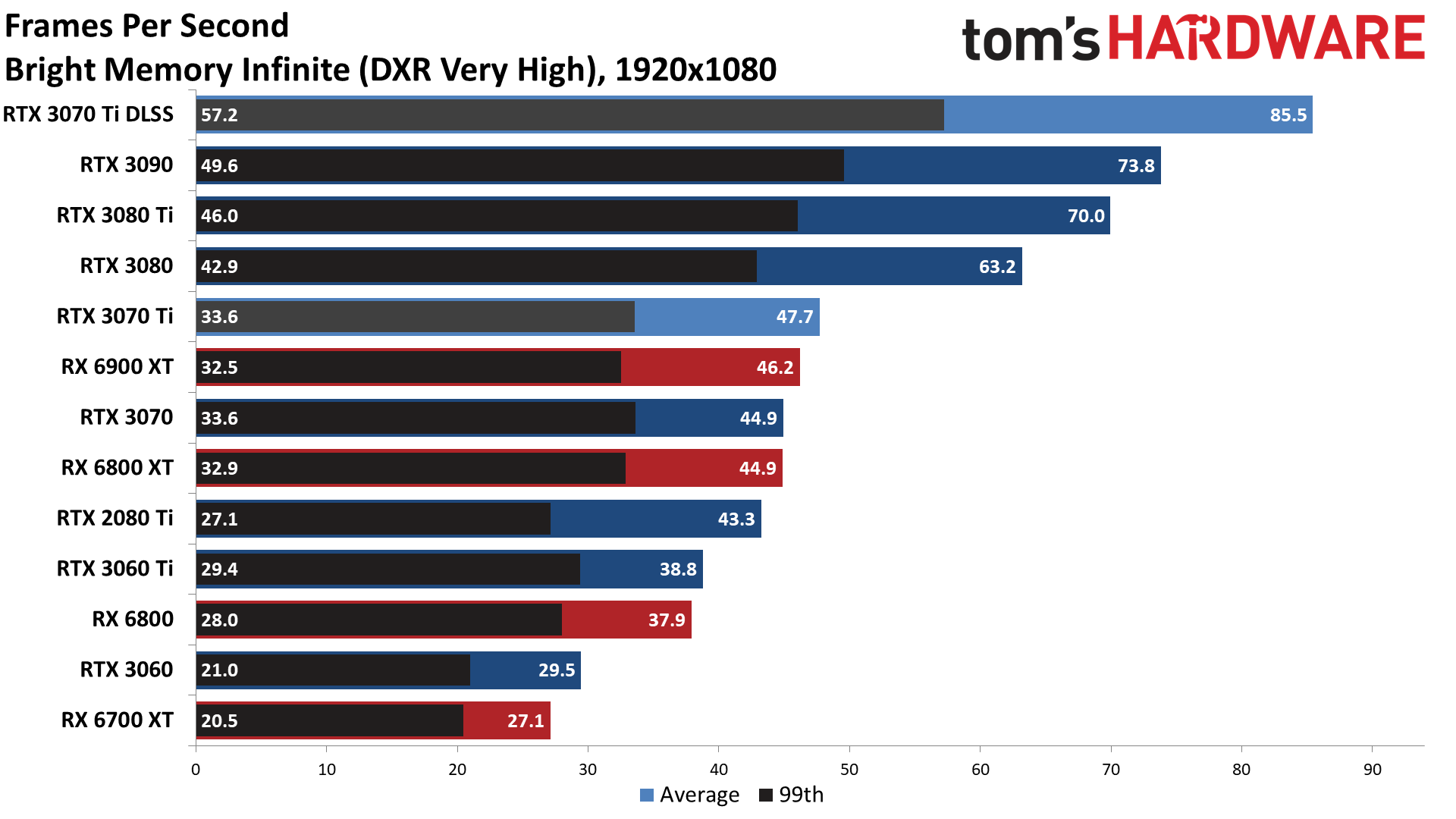

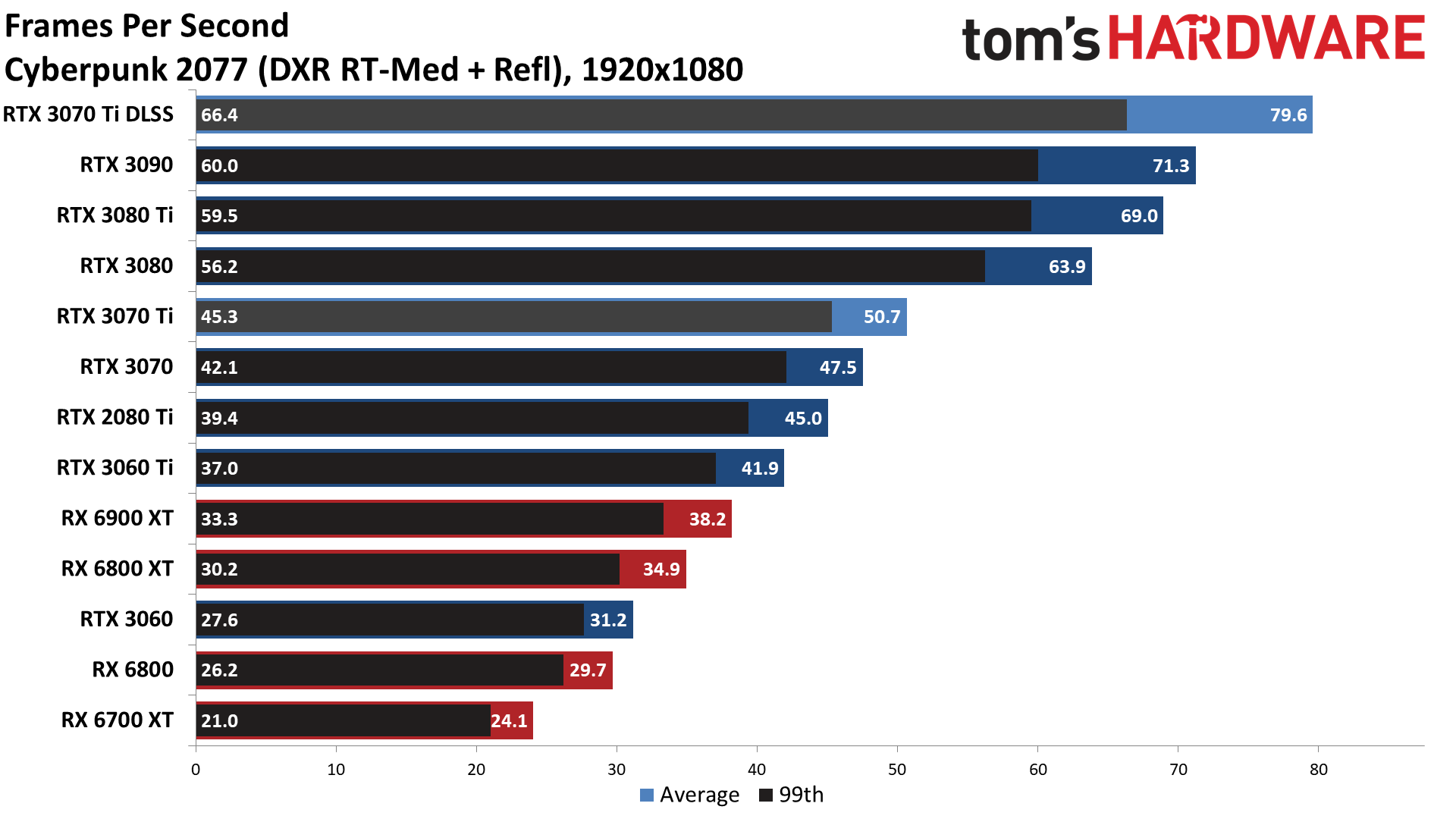
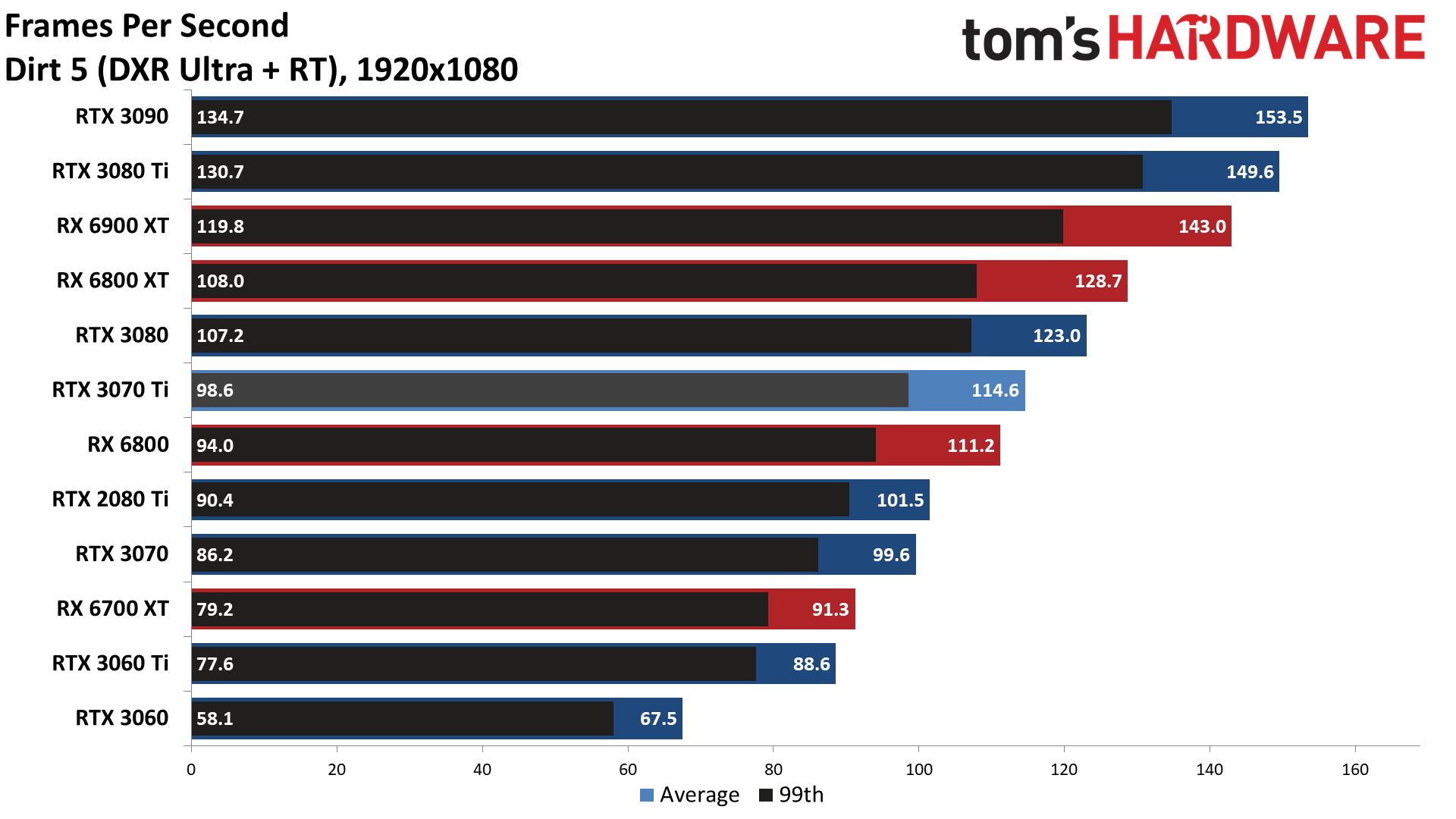

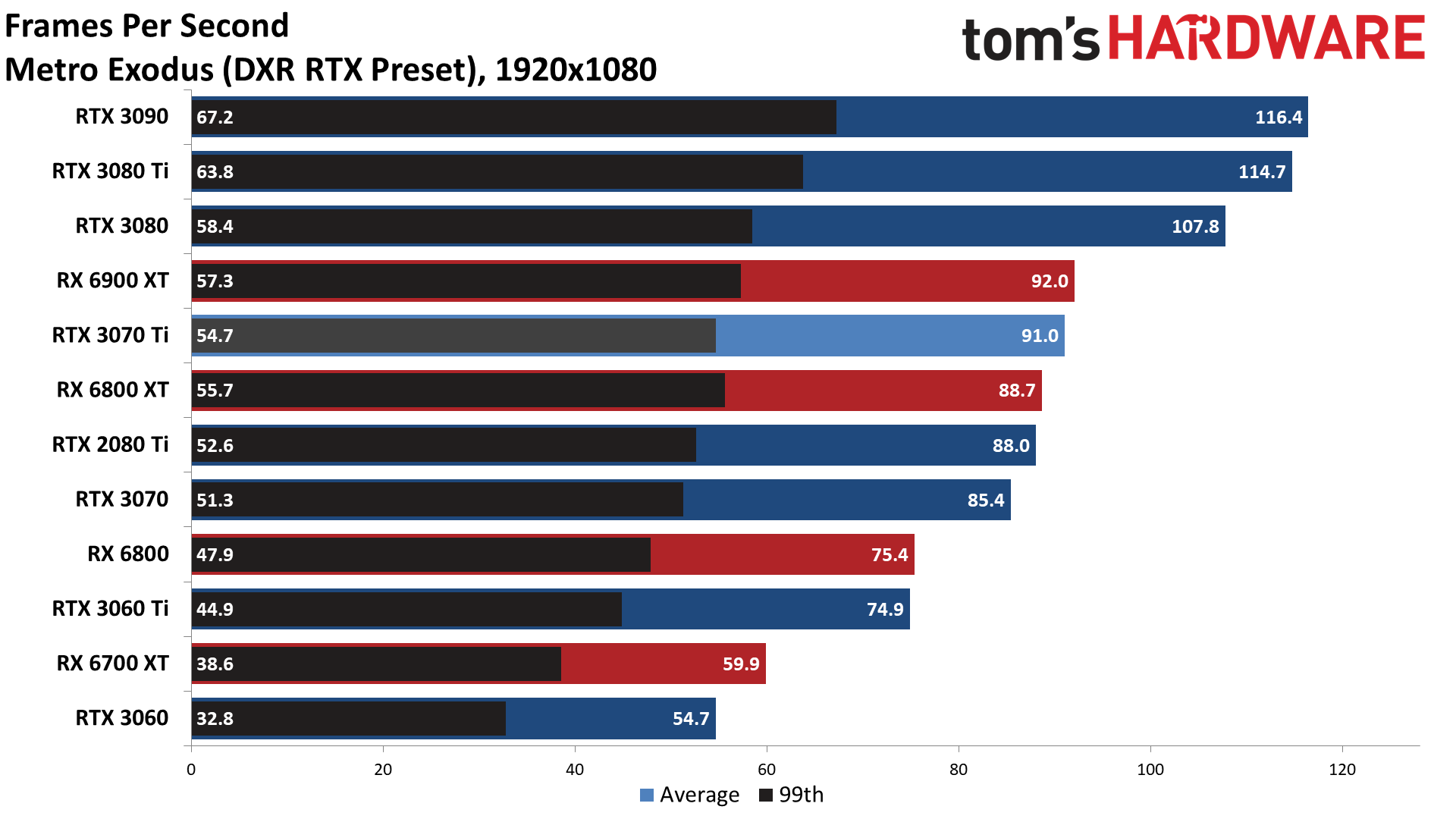

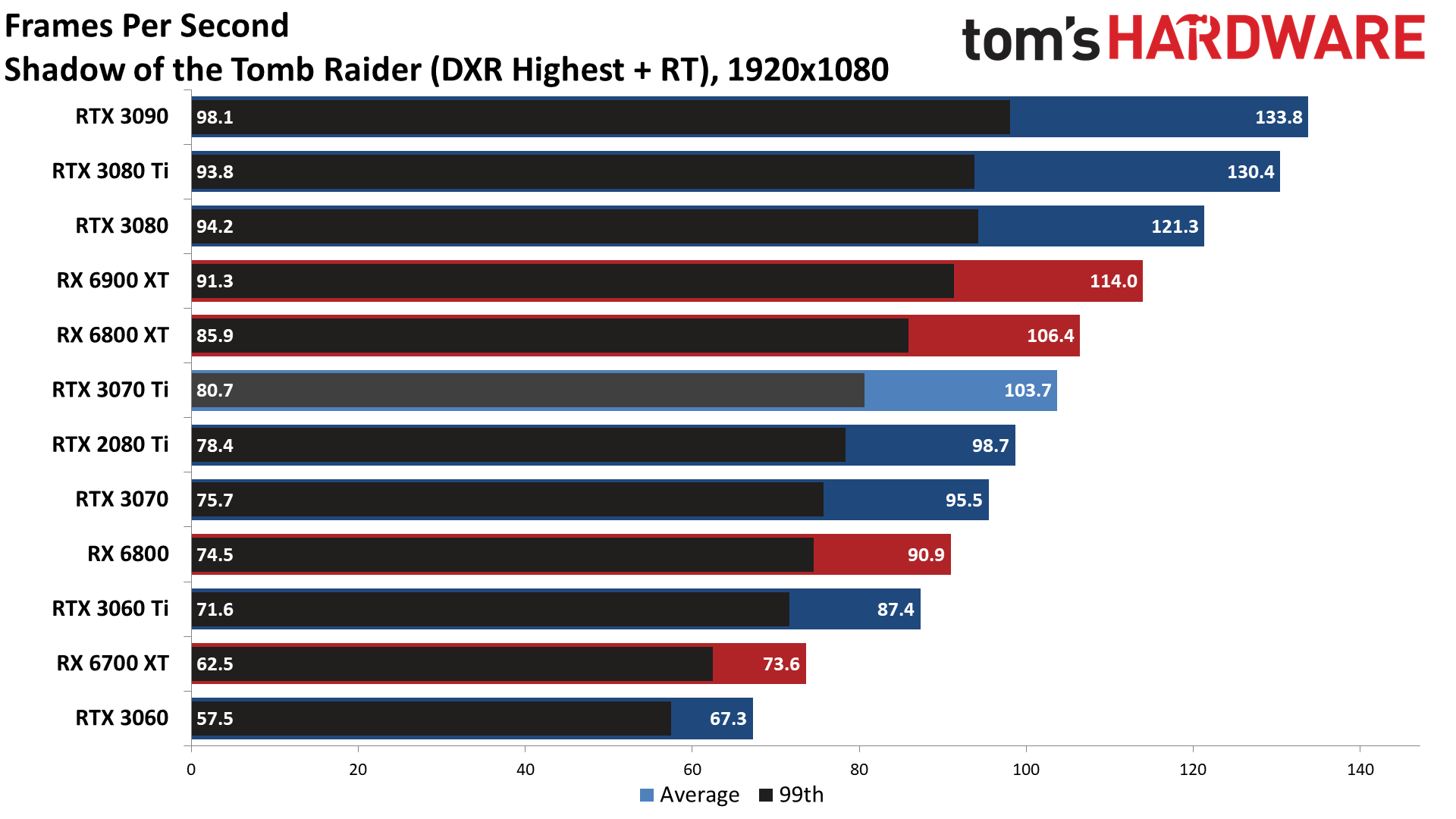
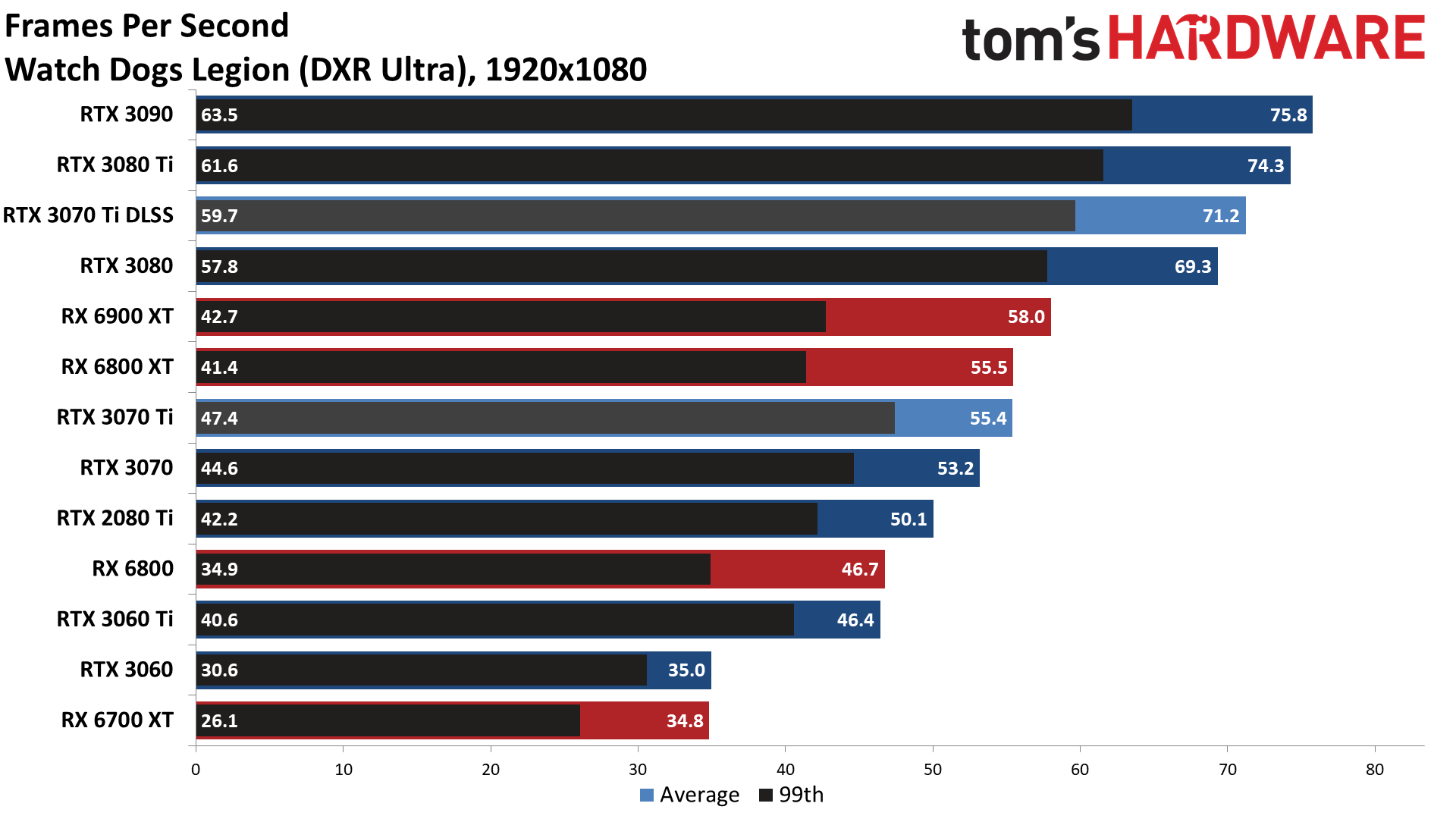
Even 1080p DXR generally ends up being GPU limited, so the rankings don't change much from above. DLSS doesn't help quite as much at 1080p, but otherwise, the 3070 Ti ends up right around 25% faster than the RX 6800 — the same as at 1440p. We've mentioned before that Fortnite is probably the best 'neutral' look at advanced ray tracing techniques, and the 3070 Ti is about 5–7% faster there. Turn on DLSS Quality and it's basically double the framerate of the RX 6800.
GeForce RTX 3070 Ti: Power, Clocks, and Temperatures
We've got our Powenetics equipment working again, so we've added the 3080 Ti to these charts. Unfortunately, there was another slight snafu: We couldn't get proper fan speeds this round. It's always one thing or another, I guess. Anyway, we use Metro Exodus running at 1440p ultra (without RT or DLSS) and FurMark running at 1600x900 in stress test mode for our power testing. Each test runs for about 10 minutes, and we log the result to generate the charts. For the bar charts, we only average data where the GPU load is above 90% (to avoid skewing things in Metro when the benchmark restarts).

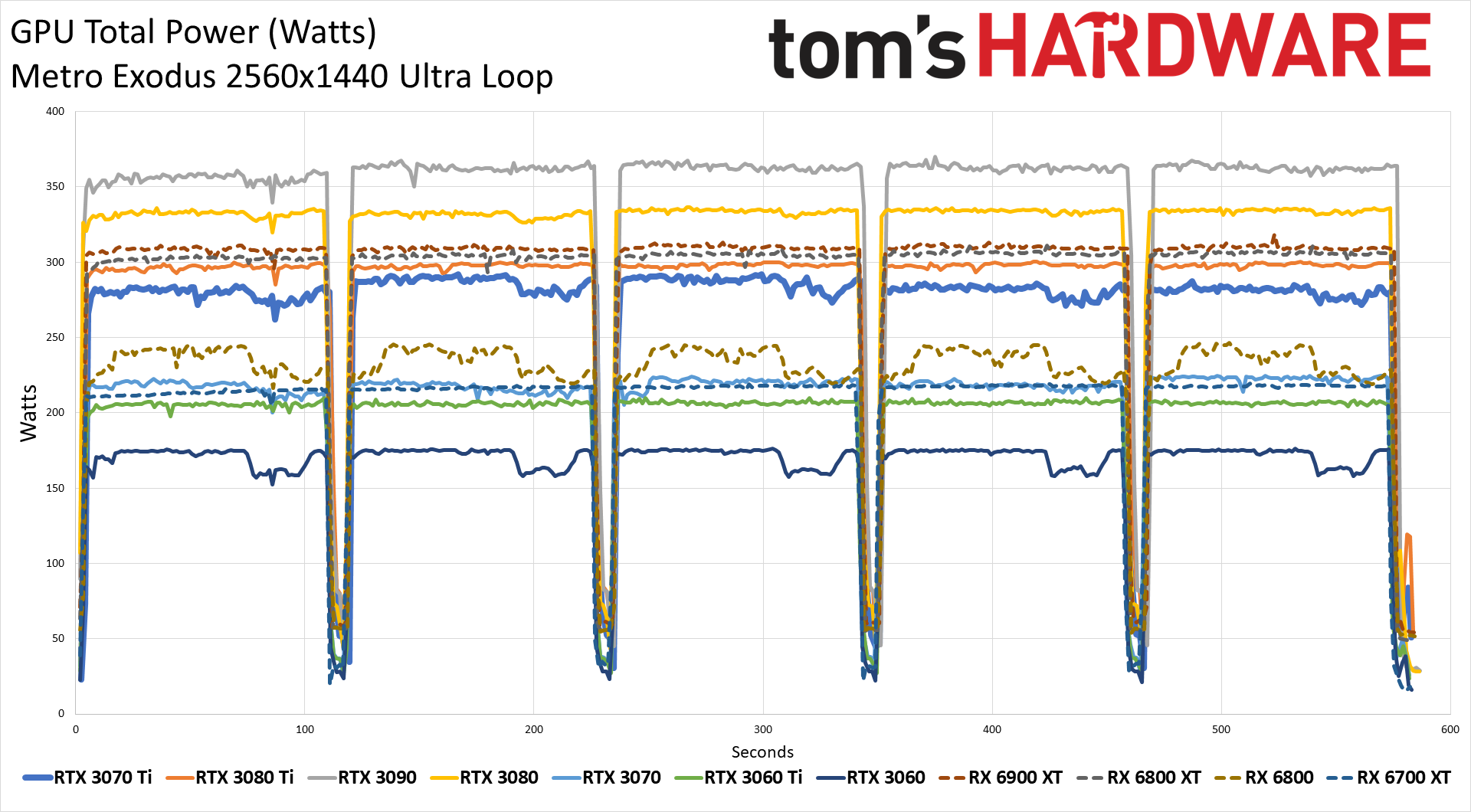

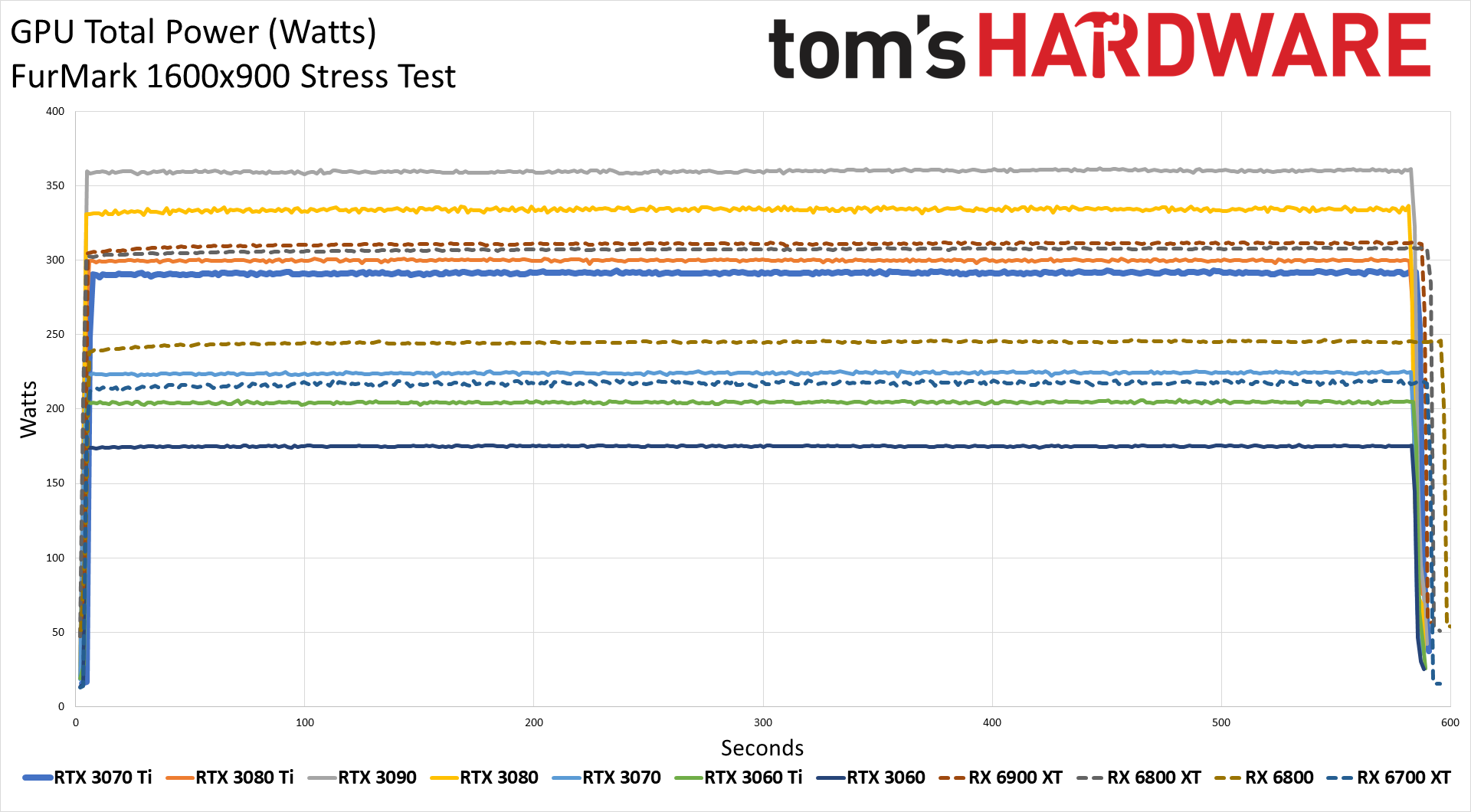
Nvidia gives the RTX 3070 Ti a 290W TDP, and it mostly makes use of that power. It averaged about 282W for our Metro testing, but that's partly due to the lull in GPU activity between benchmark iterations. FurMark showed 291W of power use, right in line with expectations.
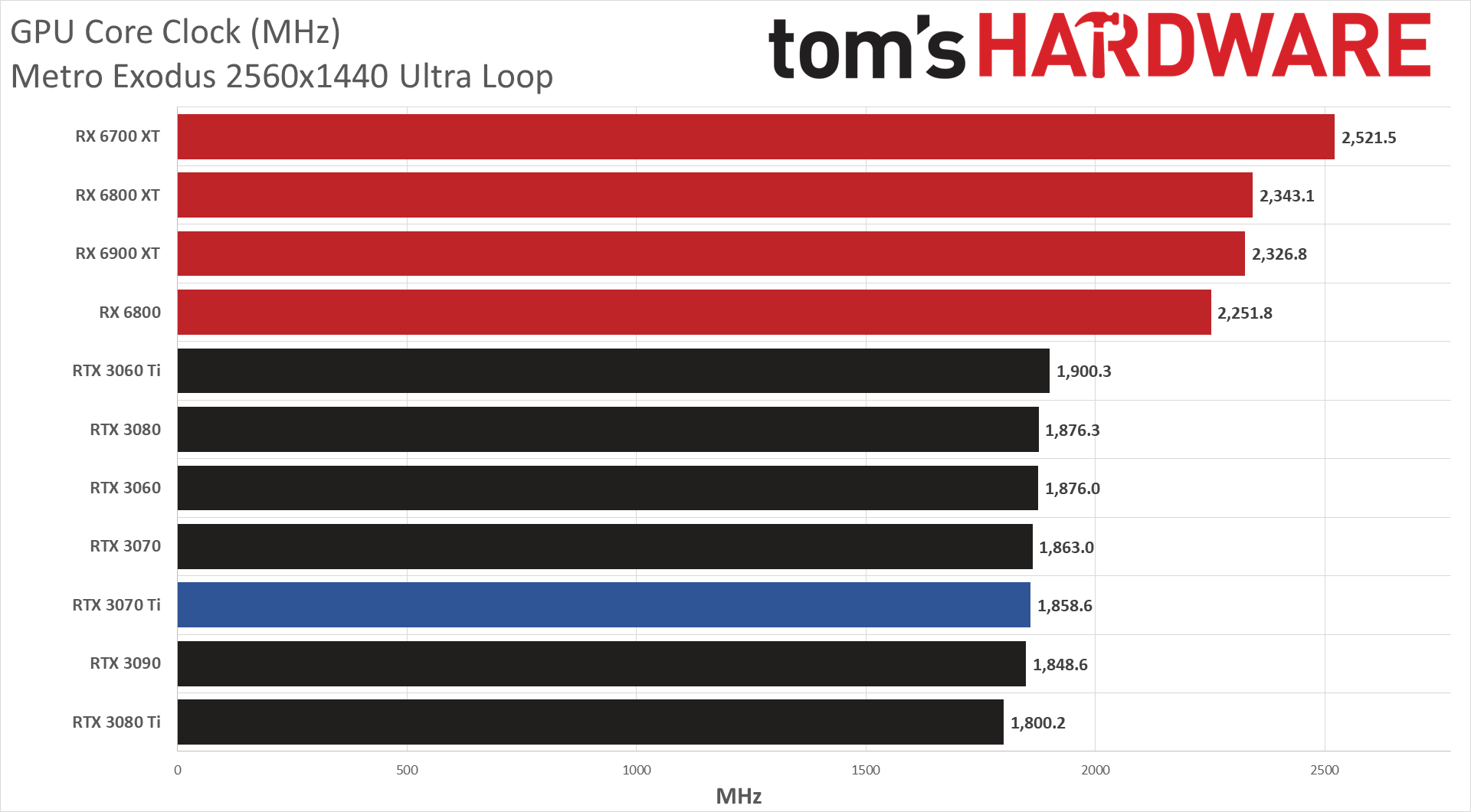
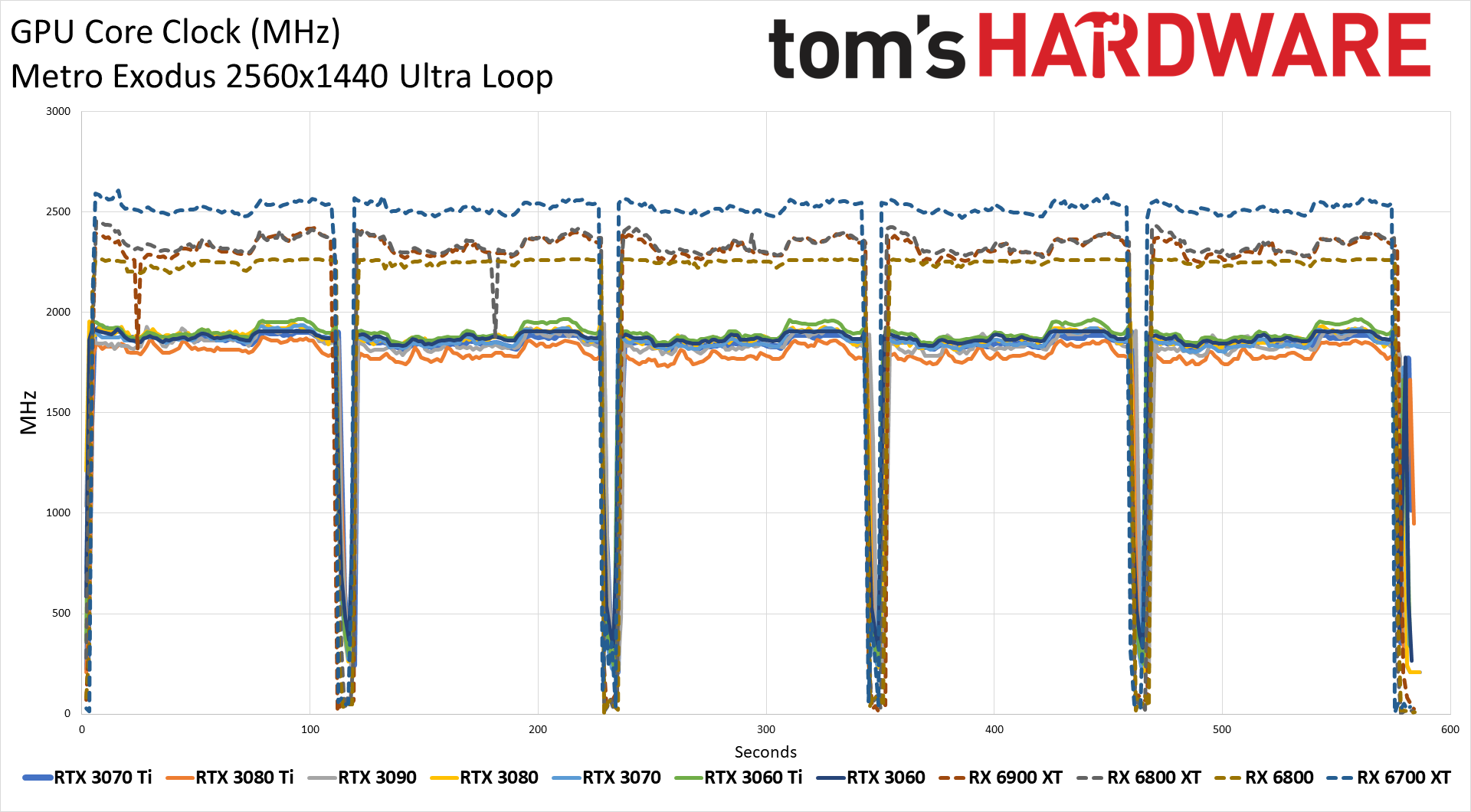
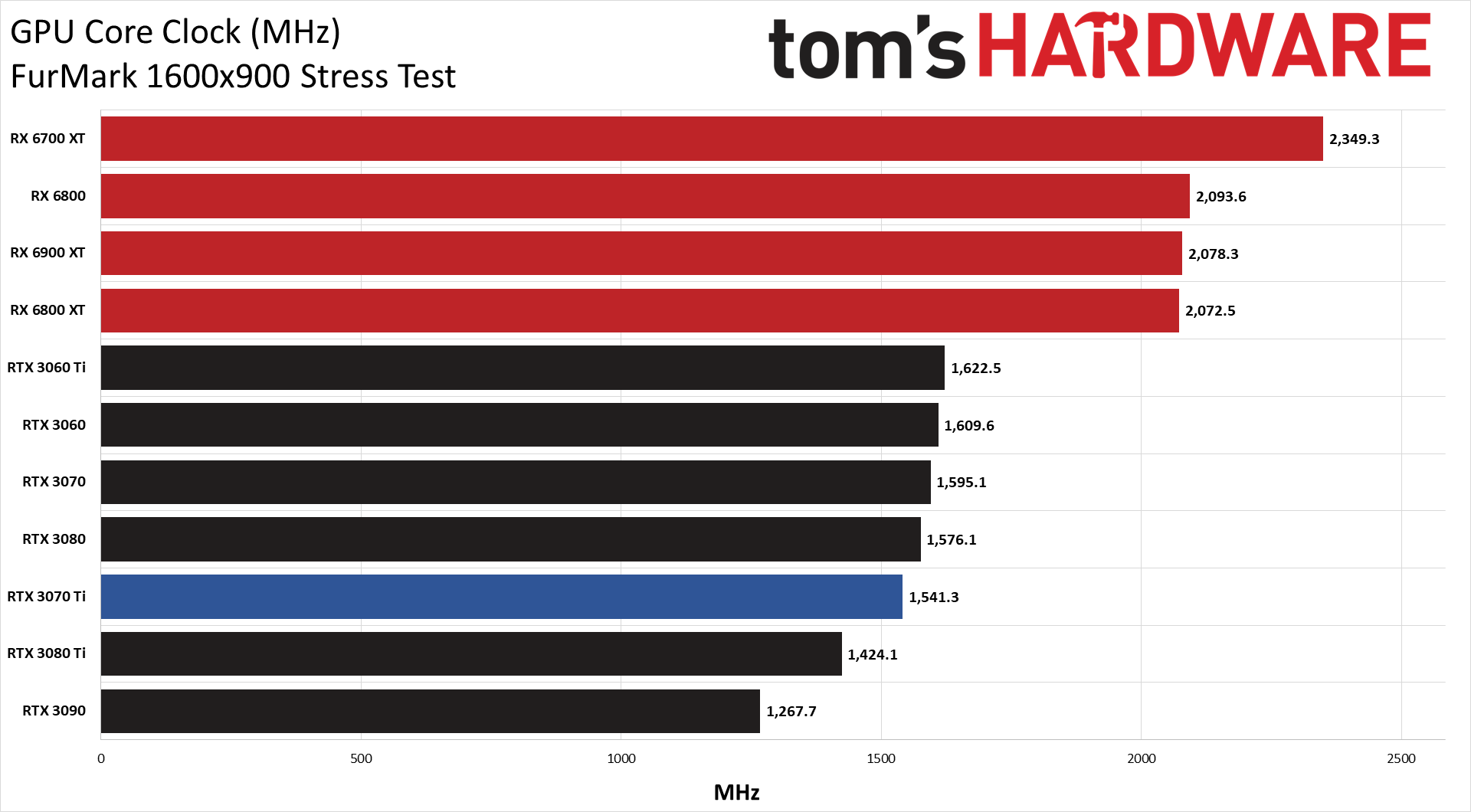
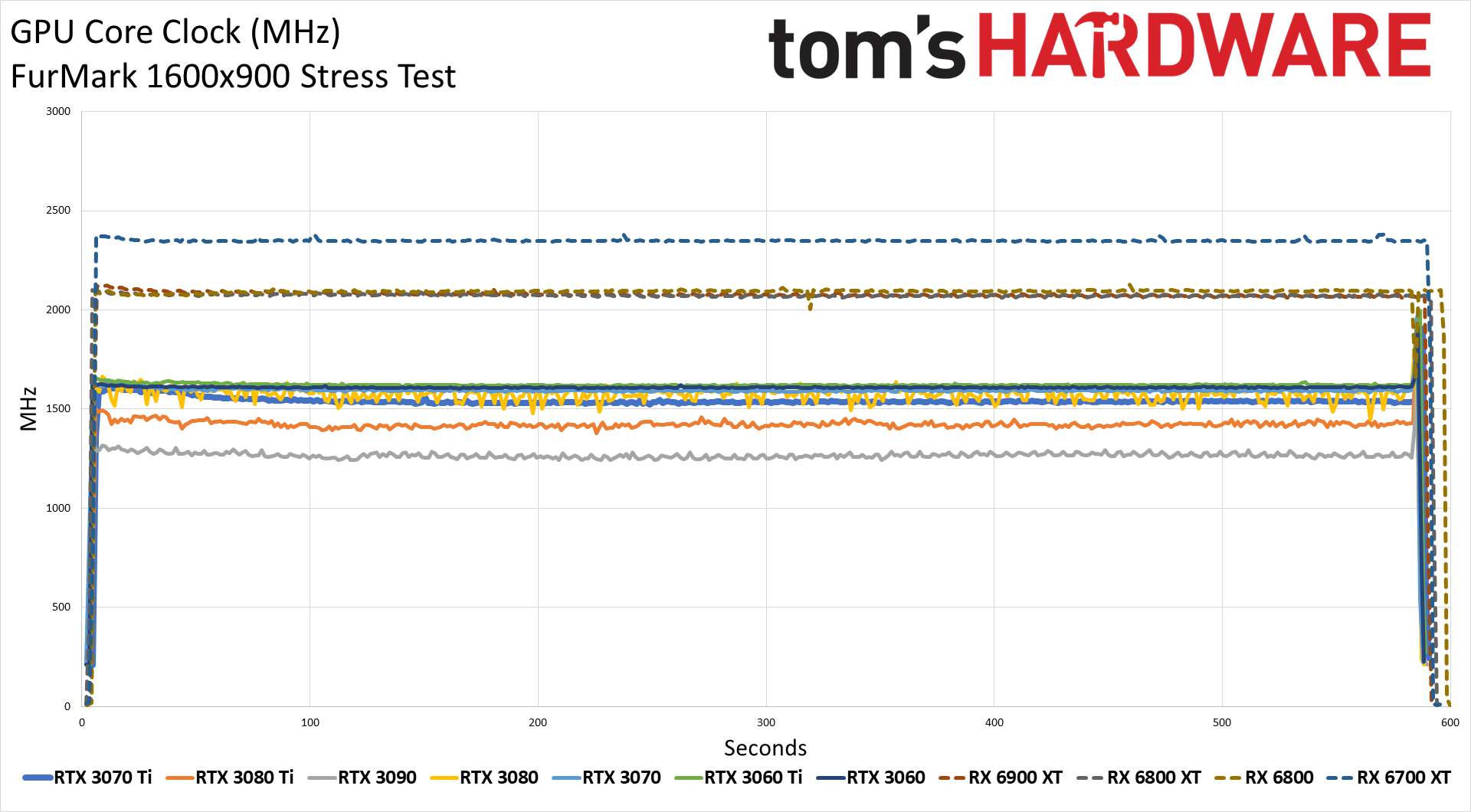
Core clocks were interesting, as the GeForce RTX 3070 Ti actually ended up with slightly lower clocks than the RTX 3070 in FurMark and Metro. On the other hand, both cards easily exceeded the official boost clocks by about 100 MHz. Custom third-party cards will likely hit higher clocks and performance, though also higher power consumption.
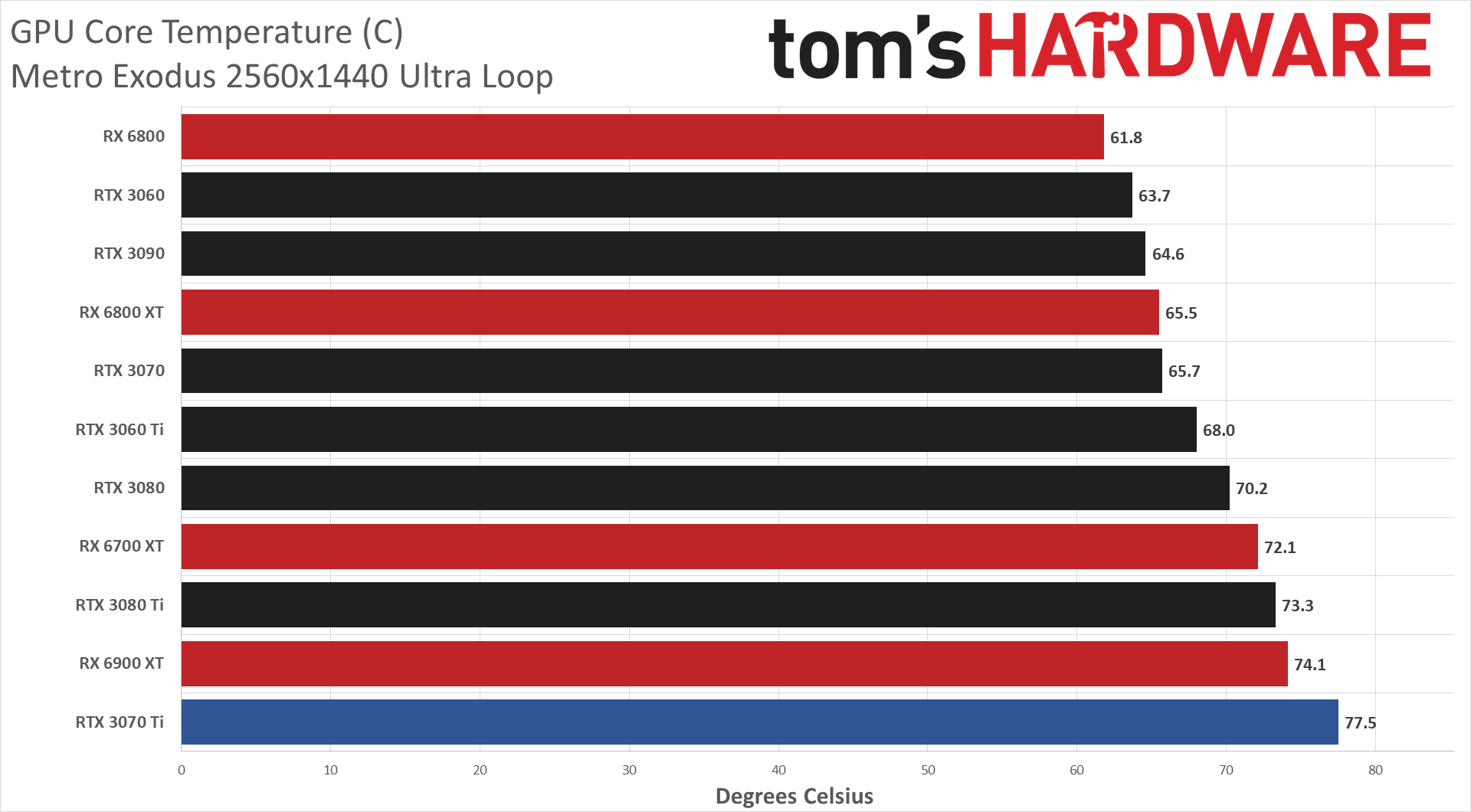
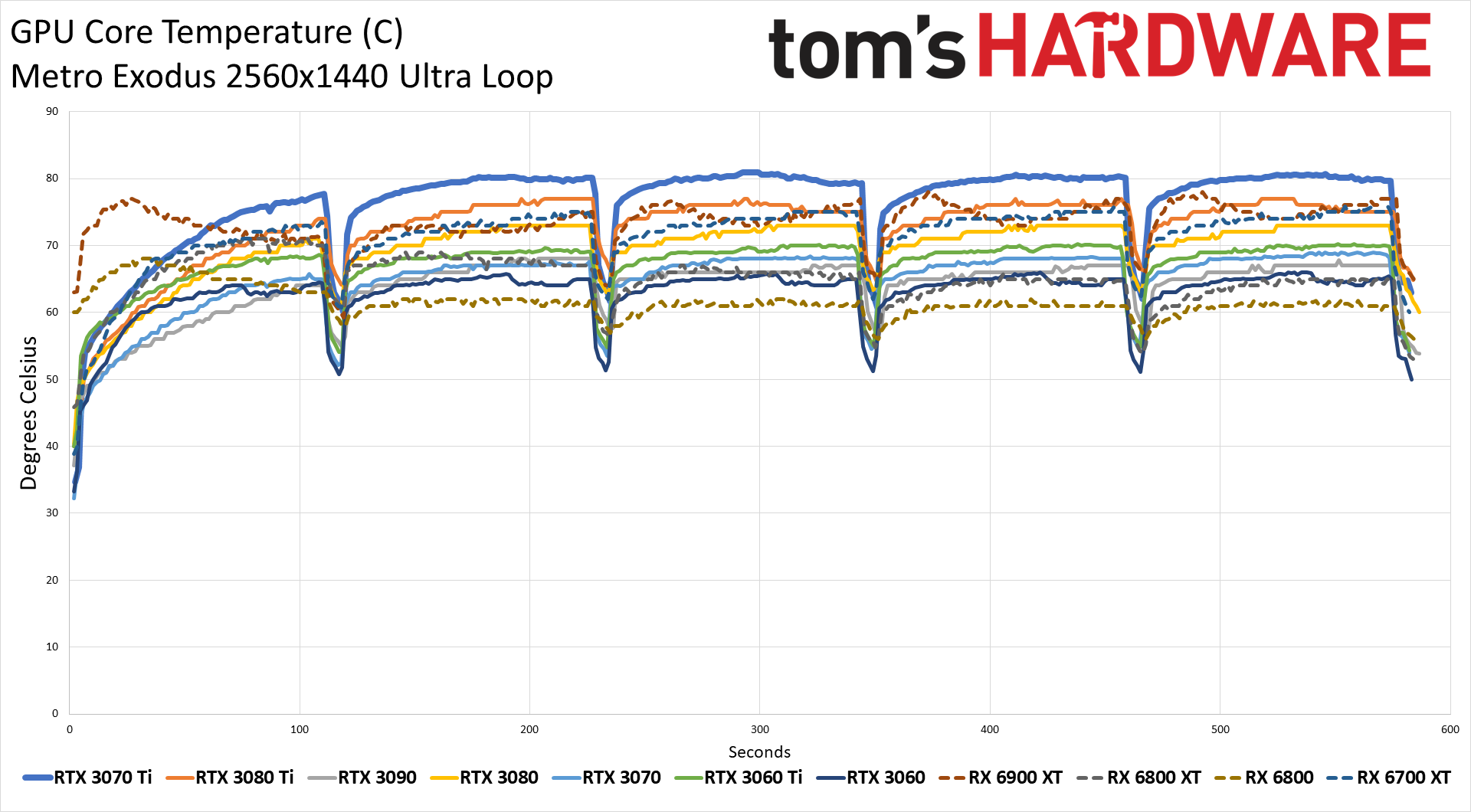

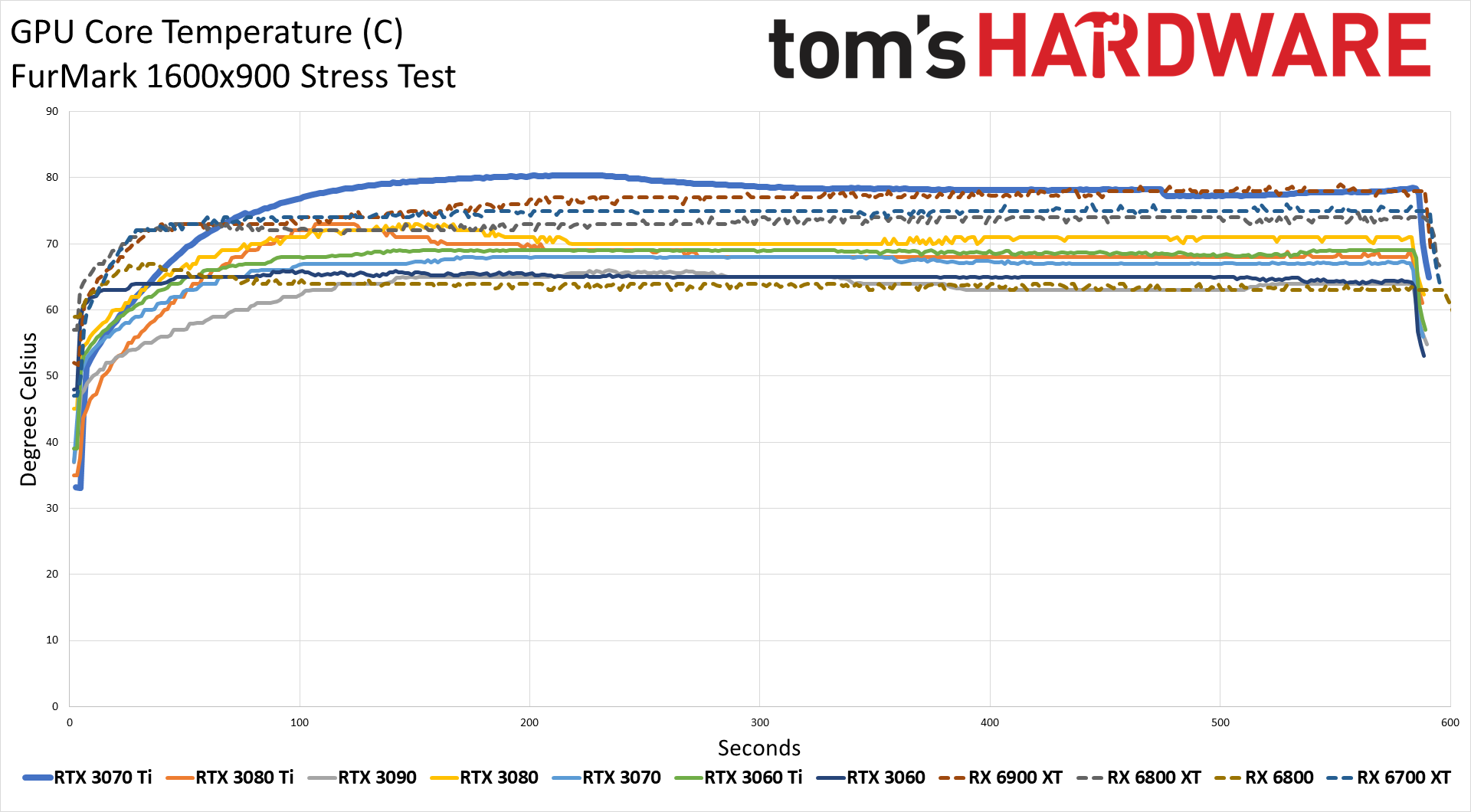
While we don't have fan data (or noise data — sorry, I'm still trying to get unpacked from the move), the RTX 3070 Ti did end up hitting the highest temperatures of any of the GPUs in both Metro and FurMark. As we've noted before, however, none of the cards are running "too hot," and we're more concerned with memory temperatures. The 3070 Ti thankfully didn't get above 100C on GDDR6X junction temperatures when testing, and even that value occured while testing crypto coin mining.
GeForce RTX 3070 Ti: Good but With Diminishing Returns
We have to wonder what things would have been like for the RTX 3070 Ti without the double whammy of the Covid pandemic and the cryptocurrency boom. If you look at the RTX 20-series, Nvidia started at higher prices ($599 for the RTX 2070 FE) and then dropped things $100 with the 'Super' updates a year later. Ampere has gone the opposite route: Initial prices were excellent, at least on paper, and every one of the cards sold out immediately. That's still happening today, and the result is a price increase — along with improved performance — for the 3070 Ti and 3080 Ti.
Thankfully, the jump in pricing on the 3070 Ti relative to the 3070 isn't too arduous. $100 more for the switch to GDDR6X is almost palatable. Except, while the 3070 offers about 90% of the 3070 Ti performance for 80% of the price and represents an arguably better buy, the real problem is the RTX 3080. It's about 12–20% faster across our 13 game test suite and only costs $100 more (a 17% price increase).
Well, in theory anyway. Nobody is really selling RTX 3080 for $700, and they haven't done so since it launched. The 3080 often costs over $1,000 even in the lottery-style Newegg Shuffle, and the typical price is still above $2,000 on eBay. It's one of the worst cards to buy on eBay, based on how big the markup is. In comparison, the RTX 3070 Ti might only end up costing twice its MSRP on eBay, but that's still $1,200. And it could very well end up costing more than that.
We'll have to see what happens in the coming months. Hopefully, the arrival of two more desktop graphics cards in the form of the RTX 3080 Ti and RTX 3070 Ti will alleviate the shortages a bit. The hashrate limiter can't hurt either, at least if you're only interested in gaming performance, and the drop in mining profitability might help. But we're far from being out of the shortage woods.
If you can actually find the RTX 3070 Ti for close to its $600 MSRP, and you're in the market for a new graphics card, it's a good option. Finding it will be the difficult part. This is bound to be a repeat of every AMD and Nvidia GPU launch of the past year. If you haven't managed to procure a new card yet, you can try again (and again, and again…). But for those who already have a reasonable graphics card, there's nothing really new to see here: slightly better performance and higher power consumption at a higher price. Let's hope supply and prices improve by the time fall blows in.
MORE: Best Graphics Cards
MORE: GPU Benchmarks and Hierarchy
MORE: All Graphics Content

Jarred Walton is a senior editor at Tom's Hardware focusing on everything GPU. He has been working as a tech journalist since 2004, writing for AnandTech, Maximum PC, and PC Gamer. From the first S3 Virge '3D decelerators' to today's GPUs, Jarred keeps up with all the latest graphics trends and is the one to ask about game performance.
-
cknobman This card, IMO, is underwhelming.Reply
Besides not having a very big bump in performance I think the biggest bummer is no more VRAM.
For the price having "sufficient" RAM for games today is sad because its sure as heck not promising for future games.
This card gulps power too. -
Phaaze88 Hopefully, everyone gets it: It's a money grab from Nvidia, along with the 3080Ti. They're a business, not a charity.Reply
The MSRP means nothing except for those that acquire these at those prices. If the 3050(Ti) ever comes around, it is not going to be cheap: Sub 200USD at the MSRP? That would be a surprise... -
King_V Just over 30% higher power consumption for a 7-ish% gain in performance?Reply
Even if it were normal times, that seems pretty atrocious. -
usiname How the f this is 6-7% faster with 7% more resterization performance and almost 40% faster memory?Reply -
-Fran- So... nVidia is telling us they went through the effort of wasting GDDR6X memory modules in this thing instead of slapping them on more 3080s and also skipping on making more 3070/3060ti's?Reply
Ah, right. Money grabbing. Of course. Why make the sensible choice here of trying to make more 3070's or 3060ti's instead when you can just spit and squeeze your fanbois even more.
Well, you know what they say: "fool me once, shame on you; fool me twice, shame on me".
Cheers! -
logainofhades Definitely a cash grab move. People are willing to pay the Nvidia tax, and they know it.Reply -
Oli Baba "Let's hope supply and prices improve by the time fall blows in. "Reply
A higher supply will NOT help at all. This isn't a normal hardware market - demand is virtually limitless.
Miners will invest in more and more cards as long as it yields profits. The GPU prices we are seeing are nothing but the threshold up to which a profit can be made off a card. If crypto values rise, GPUs will be even more expensive... if crypto values drop, GPUs will become less expensive.
Gamers can only buy GPUs at or above the value attributed by the mining economics. And no realistic amount of supply will change that as long as the crypto boom exists. -
littlechipsbigchips For the first time in my life I lost interest in reading a new GPU review lolzReply
Almost everyone I know switched to Gaming notebooks ... there is no point paying for any Desktop gaming PC today and waiting for stocks and 3x the price.